






Preceding the opening of the historic Paris 2024 Summer Olympics, RR Auction’s July Olympic Memorabilia sale plays host to nearly 400 lots, highlighted by exceptional winner’s medals, rare relay torches, a remarkable array of pins, badges, participation medals, and other Olympic collectibles. The auction is highlighted by the first public sale of a Paris 2024 torch, plus incredibly scarce Winter Olympic relay torches from Squaw Valley 1960, Grenoble 1968, Lake Placid 1980, Albertville 1992, and Lillehammer 1994. Standing atop the podium of other offered items are a wealth of gold, silver, and bronze winner’s medals, highlighted by first-place prizes from St. Louis 1904, Los Angeles 1932, Tokyo 1964, Munich 1972, Sydney 2000, and London 2012. Now in its eighth year of twice-annual Olympic auctions, RR Auction has established itself as a world leader in sales of rare Olympic memorabilia and collectibles. Join us as we make history selling history in July 2024.
Bob Eaton CEO, Acquisitions bob.eaton@rrauction.com
Carla Eaton Owner, Auctioneer carla.eaton@rrauction.com
Bobby Livingston Executive Vice President, Public Relations bobby.livingston@rrauction.com
Bobby Eaton VP, Business Development Auctioneer, MA/Lic. #3214 bobby.eaton@rrauction.com
Sue Recks
Customer Service Manager Accounts Receivable sue.recks@rrauction.com
Melissa Adams Accounting Executive melissa.adams@rrauction.com
Amey Fuller Staff Accountant amey.fuller@rrauction.com
Elizebeth Otto Consignment Director elizebeth.otto@rrauction.com
Fiona Lenaire Consignor Customer Service Manager fiona.lenaire@rrauction.com
Cecily Gruce Inventory Manager Customer Service cecily.gruce@rrauction.com
Kevin Lessard Shipping Manager kevin.lessard@rrauction.com
Matt Klein Filemaker Developer and IT Administrator matt.klein@rrauction.com
Bill White Lead Autograph Appraiser bill.white@rrauction.com
Dan McCarthy Writer, Researcher dan.mccarthy@rrauction.com
Evan Mugford Writer, Researcher evan.mugford@rrauction.com
Sarina Carlo Head of Production sarina.carlo@rrauction.com
Nikki Brickett Photographer nikki.brickett@rrauction.com
Joe Boucher Production Assistant joe.boucher@rrauction.com
Brooke Kennedy Content Writer brooke.kennedy@rrauction.com
Special Thanks: Olympics Expert Jonathan Becker
Robert S. Eaton Sr. 1940–2001

3001. Berlin 1936 Summer Olympics Torch. Official 1936 Berlin Olympics torch, comprised of steel, measuring 10.5” in length and 6” at its widest point, manufactured by Krupp. Engraved on the handle with a map of the torch relay route, the Olympic emblem, and inscribed, “Fackel-Staffel, Lauf, Olympia-Berlin, 1936.” The top of the torch is inscribed, “Organisations-Komitee fur die XI. Olympiade Berlin 1936, Als Dank Dem Trager.” The underside of the torch platform is inscribed, “Stiftung Der Fried Krupp A. G. Essen, Krupp Nirosta V2A Stahl.” The torch bears light overall scuffs and scratches.
The 1936 Summer Olympics torch relay was the first of its kind, transporting the Olympic flame from Olympia in Greece to the site of the Games in Berlin. Krupp produced a total of 3,840 torches, and 3,331 torchbearers participated in the relay. In total, it covered 3,187 km over twelve days. Representing the historically important 1936 Berlin Olympics as well as the establishment of the torch relay tradition, this is an iconic Olympic torch. Starting Bid $500
3002. London 1948 Summer Olympics Torch. Historic official 1948 London Olympics torch, comprised of aluminum alloy, measuring 16” in length and 5” at its widest point, designed by Ralph Lavers. The upper part is designed in the shape of a cauldron with three ‘cut-outs’ of the Olympic rings, encircled below by the inscription, “Olympia to London, with thanks to the bearer: XIVth Olympiad 1948.” Includes its black burner cup. The torch exhibits scattered light scuffs and dings.
The Olympic flame was lit in Olympia, Greece, on July 17, 1948, and traveled a total of 3,365 km before reaching the opening ceremony at Wembley Stadium on July 29. The 1948 Olympics in London represented the first Summer Games since 1936 after a twelve-year hiatus due to World War II. The total number of torches manufactured was 1,688. A desirable, classically designed torch from the second-ever Olympic torch relay. Starting Bid $500

3003. Melbourne 1956 Summer Olympics Torch. Official 1956 Melbourne Olympics torch, comprised of aluminum alloy, measuring 16” in length and 5.5” at its widest point, designed by Ralph Lavers and manufactured by Waco Ltd. The torch was modeled after the one used for the 1948 London Olympics, with the upper part in the shape of a cauldron with three ‘cut-outs’ of the Olympic rings, encircled below by the inscription, “XVI Olympiad 1956: Olympia-Melbourne.” The burner is included and the torch bears overall light scattered scuffs and marks.
After its lighting in Olympia on November 2, 1956, the flame made its way through the Middle East and South Asia en route to Australia, where the relay ended at the opening ceremony on November 22. Altogether, the flame was carried by 3,181 torchbearers over 4,912 km on land. An iconic torch from the first Games to be held outside Europe or North America. Starting Bid $1,500

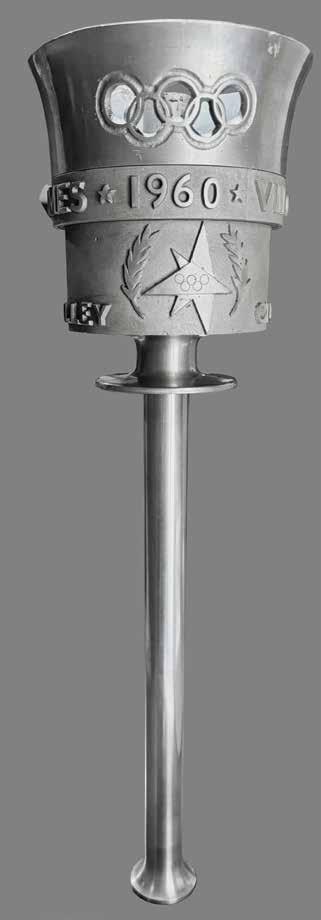
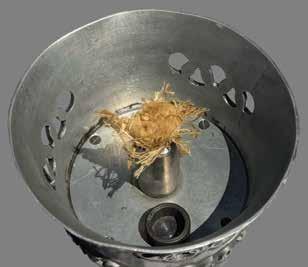


Incredibly rare, highly sought-after torch of
3004. Squaw Valley 1960 Winter Olympics Torch. Excessively rare official torch of the Squaw Valley 1960 Winter Olympics, marked as number “10” on the bottom of the handle, comprised of silver aluminum and measuring 19˝ long, considered to be among the rarest and most valuable of all Olympic torches. Inspired by the Ralph Lavers design of the torches used in 1948 and 1956, this torch was designed by legendary Disney ‘imagineer’ John Hench, and features three Olympic rings cutouts around the bowl, above a circular legend: “VIII Olympic Winter Games.” Below is the Squaw Valley Games emblem between two branches and the legend “Olympia to Squaw Valley.” The burner wick remains in place. The torch exhibits some minor scuffing to the bowl and handle. Consignor notes that this was acquired from the estate of a California state employee who was responsible for for the safety of the of the torch runners.
Interestingly, Walt Disney served as chairman of the Pageantry Committee for the 1960 Squaw Valley Games, whose duties included the organization of the torch relay. One of his Disney artists, John Hench, designed the torch, the 16foot snow-sculptures that lined the Avenue of Athletes, and the massive, 79-foot-tall Tower of Nations that marked the
staging area where the opening and closing ceremonies were held.
The torch’s legend, “Olympia to Squaw Valley,” indicates the route originally envisioned for the relay preceding the VIII Olympic Winter Games. However, the Hellenic Olympic Committee, informed a month before the Games, did not have enough time to organize a lighting ceremony at the traditional site. Instead, the Olympic flame was lit in Morgedal, Norway, at the home of the ‘father of modern skiing,’ Sondre Norheim, then transported by car to Copenhagen via Oslo. The flame was then flown to Los Angeles, where the relay carried it north through Bakersfield, Fresno, Stockton, San Francisco, and Sacramento, before arriving at Squaw Valley.
On the day of the Opening Ceremony, the torch was carried by American skier Andrea Mead Lawrence, who was accompanied by eight members of the National Ski Patrol. The flame was passed to the last torchbearer, skater Kenneth Charles Henry, who did a lap of the ice in front of the Blyth Memorial Arena before lighting the cauldron in which the flame would burn throughout the Games. Starting Bid
$50,000
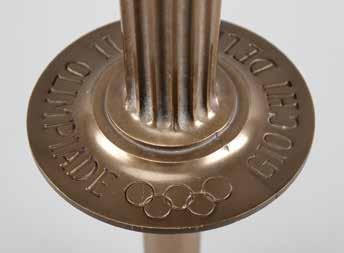
3005. Rome 1960 Summer Olympics Torch. Official 1960 Rome Summer Olympics torch, constructed of bronzed aluminum, measuring 15.5” in length and 3.75” at its widest point, manufactured by the Curtisa firm of Bologna. The torch’s designer, Amedeo Maiuri, was a renowned Italian archaeologist famous for his studies of the Roman site of Pompeii. Inspired by the designs and patterns of the host city’s ancient ruins and monuments, the torch is grooved with slender conical fluting along its candlestick frame, features consistent with the classical touch of the 1960 Games. The torch platform bears the engraving, “Giochi della XVII Olympiade,” and maker’s marks, “M. F.—Curtisa—Bologna, 3375,” can be found inscribed on the bottom of the handle. The torch bears trivial wear and dings to the upper and lower rims. Includes its original cylindrical presentation case with its inner plastic bag. The presence of this handsome case is quite rare and adds considerably to the overall appeal and completeness of the item; the case exhibits scattered wear, including denting to the end caps. The Olympic flame was lit on August 12th in Olympia, Greece, and was carried a total of 1,863 km—excluding the flame’s voyage from Athens to Syracuse aboard the training ship Amerigo Vespucci—by over 1,500 torchbearers during its historic fourteen-day relay. The XVII Olympiad earns the distinction of being the first Summer Olympics to be telecast in North America. Starting Bid $300

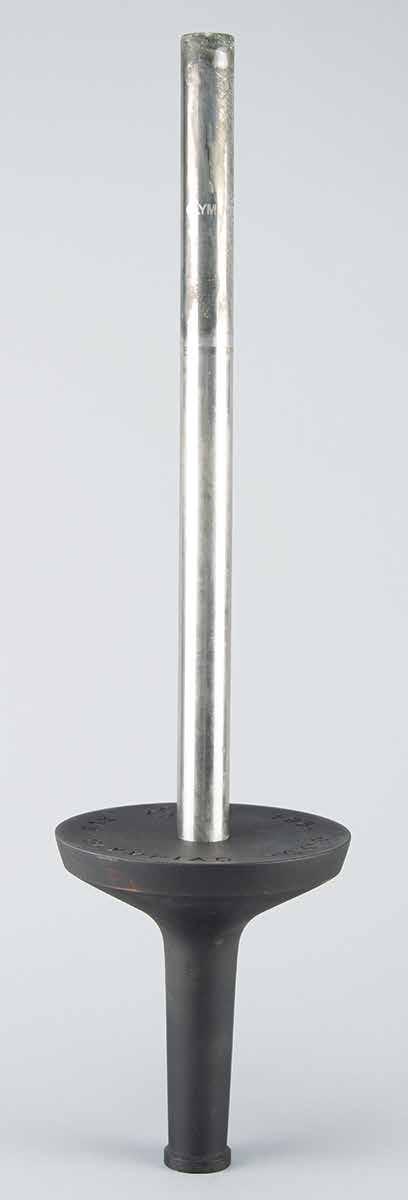
3006. Tokyo 1964 Summer Olympics Torch. Official 1964 Tokyo Summer Olympics torch, consisting of a blackened aluminum alloy bowl and a stainless steel cylinder, measuring 25.5″ in length and 6.75″ at its widest point. Manufactured by Nippon Light Metal Co., the bowl is engraved “XVII Olympiad Tokyo 1964” with a set of Olympic rings, and underside of handle marked: “Nikkei Yanagi.” The lower portion of the cylinder bears the Tokyo Games logo and reads “Showa Kaseihin Co., Ltd., 3-1964,” with upper section marked: “Olym[pic Torch],” partially charred and illegible. Exhibits burn marks and wear to the burner cylinder, and a few scattered marks to the easily scuffed black bowl. Complete with the the rarely seen original cardboard boxes for both piece: a long thin box marked “Olympic Torch” for the burner tube, and a cube-shaped box with the Tokyo 1964 emblem for the torch holder.
The Olympic flame was carried for 51 days by 870 runners for a total of 26,065 kilometers. Designed on the principle of the coal-mine safety lamp, the Tokyo Olympic torch was filled with priming powder and fumigant, a two-component ignition material that needed to be wind and rain resistant, and which could both easily ignite and extinguish. Its effect was similar to that of a flare, and it proved a safe and reliable instrument over the course of its hemisphere-trotting relay. Although a typhoon and various plane issues caused a one-day delay late in the schedule, the triumphant final relay by Yoshinori Sakai through Tokyo’s National Olympic Stadium on October 10, 1964, served as a defining moment for a still healing post-war Japan. This torch bowl beautifully represents the moment the fifth ring of the Olympiad touched down on Asian soil. The Summer Olympics returned to Tokyo for the 2020 Games (hosted in 2021), making it the first Asian city to host two Summer Games. Starting Bid $500
3007. Grenoble 1968 Winter Olympics Torch. Excessively rare official torch of the Grenoble 1968 Winter Olympics. One of just 33 manufactured by the Société Technique d’Equipement et de Fournitures Industrielle (STEFI), the torch is comprised of a handsome rose-gold bronze alloy with a red felt-wrapped grip. It measures 30˝ in length, 4˝ at its widest point, and weighs 3.6 lbs. The torch features a long, narrow combustion chamber with a crenelated upper section representing the flame. The sides of the burner head are decorated with three silver plaques featuring the Grenoble emblem designed by Roger Excoffon, depicting the Olympic rings surmounted by a snowflake, and encircled by the text, “Xes Jeux Olympiques d’Hiver, Grenoble 1968.” A small label is affixed to the bottom of the handle and the torch bears areas of oxidation and discoloring. Per the consignor, the original owner of this Grenoble torch installed and managed the gas equipment instrumental to the lighting of the Olympic flame during the opening ceremony. A magnificent opportunity to claim one of the rarest and most sought-after Olympic torches ever made.
Lit in Olympia, Greece, on December 16, 1967, the Olympic flame traveled over Mount Olympus to Athens and was then flown to the Paris-Orly airport. The first torchbearer in France was Alain Mimoun, a gold medal-winning distance runner at the 1956 Games in Melbourne and three-time Olympic silver medallist. The final torchbearer was Alain Calmat, who won silver in skating at Innsbruck in 1964. Between the two, over 5,000 torchbearers carried the flame more than 7,000 kilometers through the Jura and Vosges mountains, the Massif Central, the Pyrenees, and the Alps, with a stop at Chamonix, host of the first-ever Olympic Winter Games in 1924. Starting Bid $10,000


‘Type 4’ torch from the first Olympic Games to be staged in Latin America
3008. Mexico City 1968 Summer Olympics ‘Type 4’ Torch. Official ‘Type 4’ torch from the Mexico 1968 Summer Olympics, constructed of black aluminum and a wooden handle, measuring 20.5” in length and 4” at its widest point. The upper metal ring features a pattern of six doves and the metallic label at the bottom reads “Mexico” twice. The base of the handle bears an affixed label that features the logo of the Games and names the designer, Manuel Villazon. The lower black base is loose from the torch, as are its two metallic “Mexico” labels, which are kept together with an elastic band. Includes the original pink-andturquoise tube, which features slight wear, including some rusting to the end caps. The torch relay for the Mexico 1968 Summer Games recreated the route taken by Christopher Columbus to the New World, and began on August 23, 1968, in Olympia, Greece. It notably traveled through Columbus’s birthplace in Genoa, where he set sail from Palos in Spain, and the first land he reached in San Salvador. In all, there were 2,778 torchbearers on the 13,546 km route. Starting Bid $200
3009. Sapporo 1972 Winter Olympics Torch. Official 1972 Sapporo Winter Olympics torch, consisting of a cast-blackened aluminum alloy bowl and a stainless steel combustion tube, measuring an overall 25.5˝ in length and 4.75˝ at its widest point, manufactured by Nippon Koki. The torch’s designer, Sori Yanagi, was a pioneer of Japanese industrial design, whose simplistic and pure use of lines and curves were regarded as patently Japanese as they were universal. Inspired by the shape of the Olympic cauldron, this classic torch features a slender black bowl, with the handle impressed with the Sapporo Games logo, and the bottom engraved “Nikkei” and “Yanagi”; lower portion of the tube also bears the Sapporo Games logo, with the manufacturer’s stamp below, “GD Nippon Koki Co., Ltd.” Both the black bowl and tube exhibit moderate-toheavy wear from use, with various nicks, scuffs, and scratches to handle, the upper portion of the tube charred and blackened, and worn markings on the tube.
For the Sapporo relay, the torch was filled with priming and smokeproducing powder designed to burn for ten minutes for torches carried by runners and for fourteen minutes for those transported in cars. The Olympic flame was lit on December 28, 1971, in Olympia, Greece, and flown to Okinawa Island for the start of the Japanese relay, a massive undertaking that lasted 38 days and covered just under 19,000 km by an estimated 16,300 torchbearers—nearly all of whom shared a torch. Representing the first Winter Olympics to be held outside Europe and North America, the Sapporo Games proved to be an extravagant and groundbreaking event for the international athletic community. The Sapporo torch is highly sought as one of the rarest Olympic torches. Starting Bid $2,500

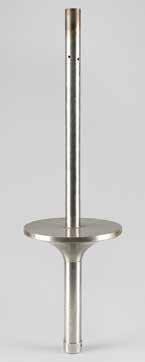
3010. Munich 1972 Summer Olympics Torch. Official 1972 Munich Olympics torch, comprised of metal and steel, measuring 29” in length and 8.5” at its widest, designed by Friedrich Krupp AG. The torch bears Olympic rings and the inscription “Spiele der XX Olympiad, Munchen 1972” on its handle, with the name of the designer engraved on the bottom. The Munich Games emblem designs a platform at the base of the combustion tube. Platform and handle feature scattered areas of rust and scuffing. Starting Bid $200
Sought-after
one of just 100 produced
3011. Innsbruck 1976 Winter Olympics Torch. Extremely rare official 1976 Innsbruck Winter Olympics torch, constructed of aluminum alloy and steel, measuring 29” in length and 8.25” at its widest point, designed by Vereinigte Metallwerke Ranshofen Berndorf. The upper shaft of the torch is hexagonal and features a pair of Olympic rings in openwork, with an elegantly curved metal strip extending from rings to platform representing a ski jump. The rim of the platform features a label inscribed with Olympic rings and “XII. Olympische Winterspiele Innsbruck 1976.” The handle’s base bears a manufacturer’s label, and the top retains its original cap. The shaft, platform, and handle exhibit some mild light marks and discoloration.
The flame of the XII Olympic Winter Games was lit in Olympia, Greece, on January 30, 1976, and traveled a total of 1,618 km over the course of five days to Innsbruck’s Bergisel Stadium. The opening ceremony featured the lighting of two cauldrons, honoring both the current games and those the city hosted in 1964; the latter cauldron was lit by Austrian skier Christl Haas, who became the first woman to light a cauldron for a Winter Olympiad. Given that only 100 were made, this is a uniquely desirable Olympic torch with a wonderful Nordic skiing motif. Starting Bid $1,000

3012. Montreal 1976 Summer Olympics Gold-Plated Presentation Torch. Exceedingly rare golden 1976 Montreal Olympics torch, comprised of gold-plated aluminum, measuring 26” in length and 3” at its widest point, designed by Georges Huel and Michel Daillaire. Unlike its official relay-used variant, which featured a red handle, white logo, and a black flame ‘basket,’ this regal presentation example is entirely gilt-coated from top to bottom, with the Montreal Games emblem engraved just above the handle grip section. The torch bears light scattered scuffs, and the lower handle section features wear and two small nicks. This glorious Montreal Olympic torch was made in a very limited quantity – believed to be 20 – and was presented exclusively to high-profile dignitaries who attended the Games of the XXI Olympiad. Starting Bid $1,000

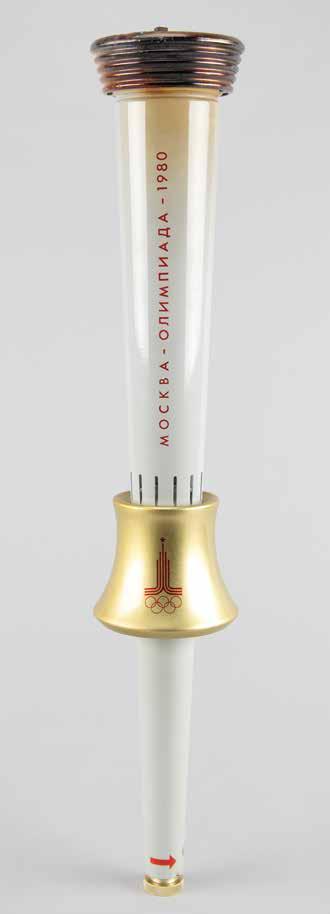
3014. Moscow 1980 Summer Olympics Torch. Official 1980 Moscow Olympics torch, comprised of aluminum, measuring 22” in length and 4” at its widest point, designed by Boris Tutschin. The gray body features red text in Cyrillic, “Moscow-Olympiad-1980,” and a gold-colored top of the handle bears the emblem of the Games and Olympic rings. The top is also accented with a golden ring. Burner remains in place. A few dings and scuffs to the handle and handle top, with the surface to upper portion showing effects from one-time exposure to the Olympic flame. In all, about 5,435 torchbearers participated in the relay, which lasted from June 19 to July 19. These Olympics were especially controversial due to the USSR’s recent invasion of Afghanistan, and the United States led 65 countries in a boycott of the Games. Starting Bid $200
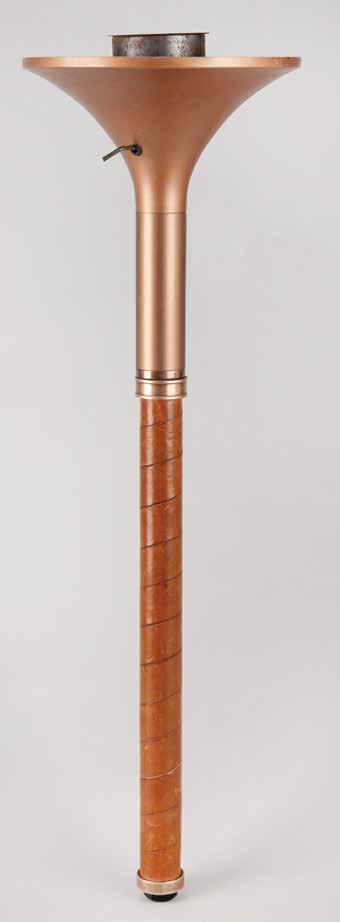

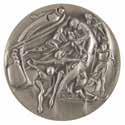
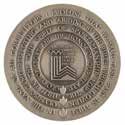
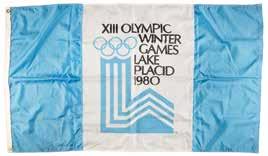
‘Miracle on Ice,’ carried by Georgia’s representative runner
3013. Lake Placid 1980 Winter Olympics Torch, Carried by Georgia’s Relay Runner. Rare and unusual 1980 Lake Placid Olympics torch carried by DeForrest Jackson as Georgia’s runner in the official torch relay, comprised of bronze-colored leather and metal, measuring 28.5˝ in length and 8.5˝ at its widest point, designed by Don McFarland and manufactured by Cleanweld Turner. The torch design and materials symbolized a blend of modern technology and a reference to Ancient Greece. The central ring lacks the Lake Placid emblem and text seen on many torches, as issued for this variant; the torch bowl also has a rare metal switch seen on few other examples of Lake Placid 1980 Winter Olympic relay torches, evidently designed to control the burn rate. The bottom brass ring, which exhibits some light wear, is engraved with the maker’s information, “Cleanweld / Turner, Sycamore, Illinois” and marked “102.” The burner bowl remains in place. The torch exhibits some wear and scuffing to its leather-wrapped handle, as well as general overall wear from use in the relay.
Additionally includes several uniform pieces and souvenirs issued to DeForrest Jackson to commemorate his role as a member of the Lake Placid 1980 Olympic Torch Relay Team: a thick, bright yellow winter jacket featuring a “XIII Olympic Winter Games Lake Placid 1980” embroidered patch on the chest, with matching winter overalls and a pair of gloves, all made by Asics; a “Lake Placid 1980 Olympic Torch Relay Team” tank top with matching running shorts, both made by Asics; a large 5’ by 3’ blue-and-white flag of the Lake Placid 1980 Olympic Winter Games; and an official nickel-silver participation medal issued for the Lake Placid 1980 Winter Olympics, housed in its original hinged case, featuring modernist relief views of the nine winter sports on the front, with Lake Placid Games emblem encircled by the raised words of the Olympic oath in four concentric circles on the reverse. Also accompanied by photocopies of three newspaper articles about DeForrest Jackson’s participation in the Lake Placid 1980 torch relay.

After being lit in Olympia on January 30, the Olympic flame traveled by air to Athens and then to Langley, Virginia, in the United States. The American leg of the relay was 1,600 km and designed to retrace the American Revolution Bicentennial Trail. Only 52 torchbearers participated—including one from every state, plus Washington, D.C. and Lake Placid—picked from a pool of over 6,000 applicants. Of his election as torchbearer, Jackson reflected: ‘Dealing with being selected has made me different. It forces one to ask what does one’s life represent that is of value to be chosen for such an honor. The first reaction is to be very modest. It’s hard to accept being the symbol of the kind of person you aspire to be. The process gives you a new sense of integrity and a sense of being whole.’
Each torchbearer, DeForrest Jackson included, carried the flame many times during the course of the national relay. The Olympic cauldron was kindled at Lake Placid on February 8th. A mere 132 torches were manufactured for the Lake Placid Winter Olympics, one of the smallest production runs for any Olympic torch. They are therefore extremely rare and incredibly highly sought after; additionally, this is the first example identified to a specific runner that we have encountered. Starting Bid $1,000

3015. Sarajevo 1984 Winter Olympics Torch. Official 1984 Sarajevo Olympics torch, comprised of lightweight metal with a long combustion tube, measuring 22.75” in length and 4” at its widest point, manufactured by the Mizuno Corporation of Japan. The handle is silver-colored and topped by a gold-tone base inscribed, “Sarajevo ‘84,” with the Mizuno logo also raised in relief. The combustion tube bears the Olympic rings and emblem of the Sarajevo games, which has been noticeably darkened from having been used in the torch relay. The handle and its base also bear various scuffs and marks. Includes its rare original black plastic presentation base made by Mizuno / Mitsubishi. Starting Bid $300

3016. Los Angeles 1984 Summer Olympics Torch. Choice unused official 1984 Los Angeles Olympics torch, brass-finished with tan leather handles, measuring 22.25” in length and 4.75” at its widest point, manufactured by Turner Industries and engraved “1983 LAOOC,” with a pair of Los Angeles Games logos on the base of the handle. The black burner remains in place, for an overall length of 23”. The bowl is engraved along the top, “Citius, Altius, Fortius, “ with the rings between each word, and the L.A. Memorial Coliseum Stadium below. Complete with its original black vinyl carrying bag and instruction sheet and booklet. Read more online at www.RRAuction.com. Starting Bid $200

3017. Calgary 1988 Winter Olympics Torch. Official 1988 Calgary Olympics torch, comprised of aluminum with a maple handle, measuring 23.5” in length, emblazoned on the handle with pictograms of ten Winter Olympic sports. The top is inscribed, “XV Olympic Winter Games Calgary Alberta Canada 1988,” and the ball at the bottom is engraved with the Olympic motto, “Citius, Altius, Fortius.” This unused torch, which is missing its fuel canister with wicks, bears trivial hints of tarnishing. The torch was designed to resemble the Calgary Tower, an iconic landmark in the Canadian city. Unlike many relays, the torches were shared and thus only about 100 were manufactured. Starting Bid $1,000
3018. Seoul 1988 Summer Olympics Torch. Beautifully designed official 1988 Seoul Olympics torch, constructed of metal, copper, leather, and plastic, measuring 20” in length and 4” at its widest point, designed by Lee Woo-Sung and manufactured by Korea Explosives Co. Ltd. The handle is wrapped in brown leather with a ring above, inscribed, “Games of the XXIVth Olympiad Seoul 1988,” in English and Korean. The upper portion of the torch bears a colorful Olympic ring emblem and the top is engraved with an intricate dragon design symbolizing the harmony between East and West; based on the Chinese zodiac, the year 1988 was also the year of the dragon. The torch’s burner is absent, and the torch exhibits scattered light wear and scuffs to the body and leather. During the 22-day relay, the Olympic Flame traveled from the Greek capital of Athens to Korea’s southernmost point, Jeju Island, before making its way north to Seoul in a 4,167 km relay. Starting Bid $300

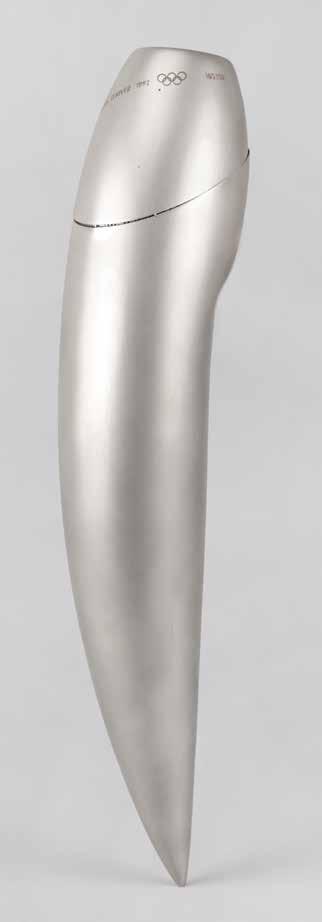
Designed by Philippe Starck, an exceedingly rare example of ‘La Corne’— the 1992 Albertville relay torch
3019. Albertville 1992 Winter Olympics Torch. Exceedingly rare official 1992 Albertville Winter Olympics torch, consisting of a bulbous steel alloy body, measuring 16.5˝ long and 3˝ at its widest point, designed by Philippe Starck and familiarly known as ‘La Corne,’ or ‘The Horn.’ The sleek, modernist design resembles a bull’s horn or flame when turned upside down, and is engraved at the top with golden lettering, “XVIes Jeux Olympiques d’Hiver 1992,” followed by a small emblem of the five Olympic rings and serial number, “105:130.” Complete with its burner, lacking its shroud. The torch exhibits some minor wear, and a few trivial marks.
One day after the Olympic flame was lit in Olympia, Greece, on December 13, 1991, it was taken from Athens to Paris via supersonic Concorde. The relay route aimed to cover as much of France as possible by passing through all regional capitals, and the 57 days of the French leg echoed the 57 events of the Albertville Games. Carried by 5,500 torchbearers, the flame passed down the iconic Champs-Elysees and made a stop at IOC founder Pierre de Coubertin’s childhood home during its 5,700 km trek through the nation. Unlike many relays where each torchbearer carries their own torch, the Albertville torches were passed from bearer to bearer and thus manufactured in extremely limited quantities. Albertville is easily the rarest and most sought-after torch of the last thirty years, and examples are seldom offered on an international stage. Starting Bid $5,000
3020. Barcelona 1992 Summer Olympics Torch. Official 1992 Barcelona Olympics torch, comprised of aluminum and plastic, measuring 26” in length and 7” at its widest point, designed by Andre Ricard. The metal body is inscribed in gold text, “XXV Olimpiada Barcelona 1992,” and bears the emblem of the Games. The sliding red switch to reverse is engraved “000095.” Exhibits scuffs, scratches, and marks to the rubberized handle, and a few scuffs to the upper body. The massive fifty-day relay included nearly 9,500 torchbearers who carried the Olympic flame by foot and bicycle for a total of 5,940 km throughout Spain. The lighting of the cauldron at the opening ceremonies was especially memorable, as Paralympic archer Antonio Rebollo ignited the cauldron by shooting an arrow lit from the Olympic flame. Starting Bid $200
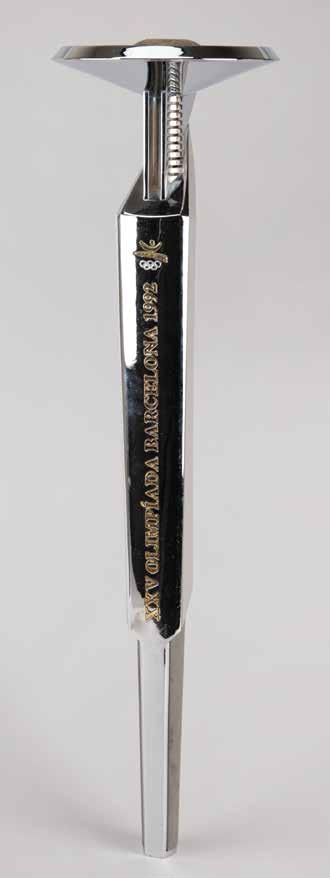
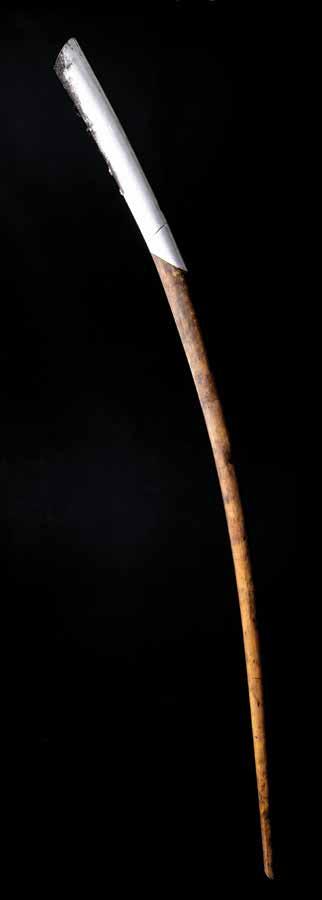
‘Noble’ torch of
‘94— the largest relay torch in
history
3021. Lillehammer 1994 Winter Olympics Torch. Magnificent official Lillehammer 1994 Winter Olympics torch, constructed of wood, iron, and copper, measuring an impressive 60″ in length, designed by André Steenbuch Marandon and Paal Christian Kahrs, and manufactured by Paal J. Kahrs Arkitekter AS. Resembling that of a sheath knife, the torch is highlighted by its long birchwood handle that symbolizes Norwegian tradition, with the upper section consisting of a polished aluminum blade that conversely reflects the nation’s industrial modernity and technology. The base of the burner is engraved with the logo of the XVII Olympic Winter Games, and the upper and lower sections of the inner copper plate feature several event pictograms. To contrast its martial appearance, the torch’s supple elongated shape and considerable length were chosen with the view of forming a harmonious extension between the torch and its bearer—its creators bestowed it with the poetic name ‘Noble.’ The bottom of the handle is marked “125.” Exhibiting general wear from use, this is a superb example of a most desirable torch.
The flame of the XVIIth Olympic Winter Games was lit in Olympia, Greece, on January 16, 1994, and, with the use of 350 torches and 6,916 torchbearers, traveled 18,000 kilometers (11,000 miles) over the course of 27 days to the Lysgårdsbakkene Ski Jumping Arena in Lillehammer, Norway. It was the sixth Winter torch relay to have more than one route, which included a visit to the Arctic Circle and the premiere instance of a torch being passed between two parachutists. Before Prince Haakon lit the cauldron at the opening ceremony, Stein Gruben astounded spectators in spectacular and fiery fashion when he launched from the ski jump with the torch in hand. Nearly the height of a human being, this massive, highly-sought Olympic artifact holds the unique distinction of being the longest and thinnest torch in Olympic history. Starting Bid $5,000
3022. Atlanta 1996 Summer Olympics Torch Presented to IOC Member James Worrall. Official 1996 Atlanta Summer Olympics torch that was presented to Canadian Olympic administrator James Worrall. Constructed of gold-plated brass, aluminum, and Georgian pecan hardwood, measuring 31.75” in length and 2.5” at its widest point. Designed by Peter Mastrogiannis, the wooden handle represents the connection of the flame between heaven and earth, and the torch’s twenty-two reeds, representing every host city of the Olympic Games since 1896, are gathered by bands at the top and bottom, with the top displaying the Atlanta Games logo and the quilt of leaves design, and the bottom band listing all Olympic cities and their dates since 1896. Starting Bid $200

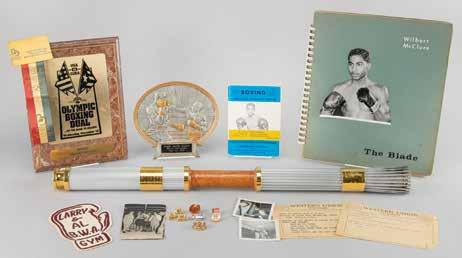
3023. Wilbert ‘Skeeter’ McClure’s Atlanta 1996 Summer Olympics Torch and 1960 Rome Participant Pin—Including Scrapbooks, Photos, AAU Boxing, and Awards. Archive of Olympian boxer Wilbert ‘Skeeter’ McClure (1938–2020), who won a gold medal in the light middleweight division at the Rome 1960 Summer Olympics. The archive, which contains ephemera and personal effects like scrapbooks, awards, correspondence, and souvenirs dating to his time as an AAU and Olympic champion, is highlighted by an official 1996 Atlanta Summer Olympics torch that McClure ran with in Boston during the torch relay of the Centennial Olympic Games. Includes a participation pin from the Rome Olympics, “Olympic Boxing” schedules for the 1960 American boxing trials, and a 1959 University of Wisconsin press release listing matches for the Pan American Amateur Boxing Trials; the latter two items list Cassius Clay, aka Muhammad Ali, as a 178-pound boxer. In overall very good to fine condition. A full listing of this archive’s contents can be read in our online description. Starting Bid $200
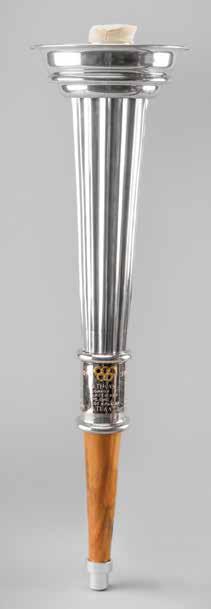
3024. International Olympics Committee 1996 Centennial Torch. Uncommon official International Olympic Committee (IOC) centennial torch, constructed of aluminum and wood, measuring 21.75” in length and 6” at its widest point. The main body is ribbed in a fashion similar to the twenty-two reeds found on the Atlanta torch, with a band above the wooden handle engraved with the names of all the host cities and their dates since 1896; bottom ring slightly loose from band. An example of this unique torch was lit in Greece on March 30, 1996, and designed specifically for use at an event in Athens hosted by the Hellenic Olympic Committee to celebrate the 100th anniversary of the first modern Games. Representatives from each host city since 1896 attended and participated in a torch run inside Athens Olympic Stadium using these torches. An elegant, unused torch commemorating one hundred years of Olympic excellence. Starting Bid $200

3026. Sydney 2000 Summer Olympics Torch. Unused official 2000 Sydney Olympics torch, comprised of steel and aluminum, measuring 30.5˝ in length and 4˝ at its widest point, designed by Blue Sky Design and manufactured by G. A. & L. Harrington. The beautiful aesthetic of this torch drew inspiration from the Sydney Opera House, the blue of the Pacific Ocean, and the Australian boomerang. Both sides of the top of the torch prominently feature the emblem of the Sydney Olympics. The Sydney Olympic Games were lauded as the best ever held and the torch relay was a massive undertaking, taking place over the course of four months and including a total of 13,400 torchbearers. A beautiful torch from the XXVII Olympiad. Starting Bid $300
3025. Nagano 1998 Winter Olympics Torch. Official 1998 Nagano Winter Olympics torch, comprised of aluminum and cotton, measuring 21.5˝ in length and 4.75˝ at its widest point. Manufactured by the Katsura Co., and designed by the Nagano Olympic Games Organizing Committee, the torch was inspired by pine branch torches called taimatsu that were used in the past in Japan. The hexagonal shape of the body represents snow crystals, with the silver color chosen to resemble a wintry landscape; when turned upsidedown, the torch bears the resemblance of a Bonsho bell found in Buddhist temples. The five red rings mounted to the top bear gold-colored Olympic rings, and the yellow rope wrapped to the lower handle is a reference to a traditional element of Japanese design. Light wear to the upper tip edges. Starting Bid $500

“Light

3027. Salt Lake City 2002 Winter Olympics Torch. Unused official 2002 Salt Lake City Winter Olympics torch, constructed of silvered metal and copper, measuring 31.5” in length and 3.5” at its widest point, designed by Axiom Design and manufactured by Coleman. The torch was modeled after an icicle and slightly curved to represent speed and fluidity, with a contrasting dull and polished finish on the handle to represent the meeting of modernity with the past. The handle is engraved with the motto of the games, “Light the fire within,” and a raised emblem of the games appears near the top. The torch bears trivial marks and wear. A desirable example as it is complete with its fragile glass bowl. The Olympic flame was lit in Olympia, Greece, on November 19, 2001, and began the American leg of its journey on December 4 in Atlanta. The route passed through the past host cities in the United States—Atlanta, Lake Placid, St. Louis, Los Angeles, and Squaw Valley—over a 21,725 km route. Starting Bid $200

3028. Athens 2004 Summer Paralympics Torch. Official 2004 Athens Summer Paralympics torch, constructed of aluminum and olive wood, measuring 25.75˝ in length and 2.25˝ at its widest point, designed by Andreas Varotsos and manufactured by GA & L Harrington. The torch was modeled to reflect the simple and congruous lines of an olive tree leaf, with the union of wood and metal evoking the different colors found on either side of the leaf, and the ergonomic design representing the extension of the moving flame. The front of the aluminum sheath bears a label of the 2004 Paralympics emblem, which bears a few scratches. Starting Bid $200

3029. Athens 2004 Summer Olympics Torch. Official 2004 Athens Summer Olympics torch, constructed of aluminum and olive wood, measuring 25.75” in length and 2.25” at its widest point, designed by Andreas Varotsos and manufactured by GA & L Harrington. The torch was modeled to reflect the simple and congruous lines of an olive tree leaf, with the union of wood and metal evoking the different colors found on either side of the leaf, and the ergonomic design representing the extension of the moving flame. The front of the aluminum sheath bears the Olympic rings and Athens emblem, with Greek engraving below presented to Lena Zachopoulou. The Olympic flame was lit in Olympia, Greece, on March 25, 2004, and proceeded on a five-continent journey that witnessed the torch pass by all the cities that had hosted the Games since 1896, as well as marking the flame’s debut in Africa, India, and South America. In total, the torch covered over 84,000 km during its 141-day journey. Starting Bid $200

3030. Torino 2006 Winter Olympics Torch. Official 2006 Torino Winter Olympics torch, constructed of blue techno-polymer-coated aluminum, measuring 31.25” in length and 4.5” at its widest point. Designed by Pininfarina, the shape of the torch was designed to appear like a ski tip, while also representing the monument and symbol of Turin, the Mole Antonelliana. Additionally, the design was intended to replicate the traditional wooden torch, giving the impression that the metal itself catches fire and burns. The middle portion of the torch bears an inscription of the Torino Games emblem with Olympic rings. Slight instances of scuffing to the body and the upper portion of the torch bears evidence of use. Starting on December 8, 2005, the Olympic torch relay lasted 75 days and traversed over 11,300 km. In all, a total of 10,001 torchbearers carried the flame until it entered the Olympic Stadium on February 10, 2006. This sleek and dynamic Olympic torch was awarded the Lorenzo il Magnifico award, the highest prize from the Florence Biennale of Contemporary Art. Starting Bid $200
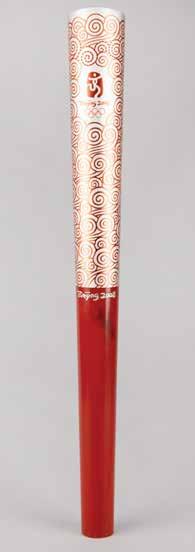
3031. Beijing 2008 Summer Olympics Torch. Unused official 2008 Beijing Summer Olympics torch, constructed of anodized aluminum and rubber, the torch measures 28.5” in length, 3” at its widest point, and was designed by Lenovo China and Aerospace Science & Industry, and manufactured by Zhongshan Vatti Gas Appliance Stock Co., Ltd. The curved shape of the torch embodies that of both a parchment scroll and a cloud, the latter an ancient decorative element from Chinese art that is found on buildings, sculptures, and furniture. The upper portion of the torch is covered in etched patterns of ‘propitious clouds’ and bears the Beijing logo and Olympic rings; its red color symbolizes the spirit of celebration, enthusiasm, and good fortune. The lower handle portion is inscribed “Beijing 2008,” and is layered with a fine rubber-based varnish, a finish specifically designed to improve grip and replicate the contact of human skin as if the torchbearer were holding a friend’s hand. The torch bears a couple of small scuffs, and an area of discoloration is present to the handle. Complete with its original Olympic box. Starting Bid $200
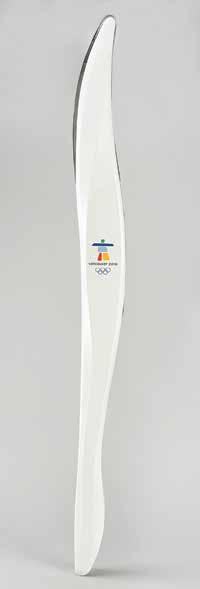
3032. Vancouver 2010 Winter Olympics Torch - From the Collection of IOC Member James Worrall. Official Vancouver 2010 Winter Olympics torch that was presented to Canadian Olympic administrator James Worrall. Constructed of stainless steel, aluminum, and sheet molding, the torch measures 37˝ in length and 3˝ at its widest point. Manufactured by Bombardier, the torch features a shape and contours that represent the lines made by snow and ice sports, and it’s engraved with the motto “With Glowing Hearts / Des plus brilliants exploits,” with the Canadian maple leaf ‘cut-out’ on the opposing side. The Vancouver Games logos are present on either white panel, the upper tips of which show slight separation; the body bears a few light scuffs. Complete with its original torch relay carrying bag. Starting Bid $200
3033. London 2012 Summer Olympics Safety Lamp. Very desirable safety lamp from the London 2012 Summer Olympics, 10” in height and 3.5” in diameter, manufactured by the Protector Lamp and Lighting Co., of Eccles, Manchester, which has produced Olympic lanterns for the last 30 years. The safety lamp consists of a lower globe and brass frame, which features plates to front and back; the front features the London Games emblem with engraved text, “Olympic Torch Relay,” and the back bears the maker plate, which identifies the lamp as “Type 6, M & Q, Safety Lamps, Approval No. 8/28.” The globe and frame house the interior lamp chimney and burner, with base marked “C, 77/”; the frame exhibits some minor dings and scuffs. The design is a modified miner’s lamp, which enables the flame to be safely transported by aircraft.
The Olympic flame was lit in Olympia on May 10, 2012, and embarked on an eight-day journey across Greece and Crete before flying over to London. Commencing in Land’s End in Cornwall on May 19, the UK portion of the relay was designed so that 95 percent of the population of the United Kingdom, the Isle of Man, Jersey, and Guernsey would be a maximum of one hour from the torch route. After seventy days and 15,775 total km, the massive relay touched down in London’s Olympic Stadium on July 27. London became the first city to host the modern Olympic Games three times—having previously hosted in 1908 and 1948. The spectacular event featured more than 10,000 athletes from 204 nations, with new world records set in archery, swimming, and weightlifting. The Summer Games were also remembered for the inventive opening ceremony overseen by Oscar-winning director Danny Boyle. Starting Bid $300


3034. London 2012 Summer Olympics Torch. Beautiful unused official 2012 London Olympics torch, comprised of metal and aluminum, measuring 31.5” in length and 4.25” at its widest point, designed by Edward Barber and Jay Osgerby, and manufactured in collaboration by Tecosim, LPG Gas, Bullfinch and Premier Sheet Metal. The gold-colored torch body consists of two envelopes of aluminum alloy perforated with 8,000 circles, a number which matches with both the amount of torchbearers and the United Kingdom relay miles, and features a golden metal logo of the Games near the top. The triangular shape refers to the multiples of three found in the Olympic movement’s values of excellence, friendship, and respect, the Olympic motto of ‘Citius, Altius, Fortius,’ and London’s hosting of the Games for the third time.
The Olympic flame was lit in Olympia on May 10, 2012, and embarked on an eight-day journey across Greece and Crete before flying over to London. Commencing in Land’s End in Cornwall on May 19, the UK portion of the relay was designed so that 95 percent of the population of the United Kingdom, the Isle of Man, Jersey, and Guernsey would be a maximum of one hour from the torch route. After seventy days and 15,775 total km, the massive relay touched down in London’s Olympic Stadium on July 27. A truly regal and gorgeous example of an Olympic torch, and a work of art that earned the Design of the Year Award at London’s Design Museum. Starting Bid $300

3035. Sochi 2014 Winter Olympics Torch. Official unused 2014 Sochi Winter Olympics torch, constructed of aluminum and various polymers, measuring 37.5” in length and 5.75” at its widest point, developed by a team of designers led by Vladimir Pirozhkov and Andrei Vodyanik. The torch was modeled after the feather of a Firebird or phoenix, which symbolizes good luck or fortune in Russian folklore, and was immortalized in Igor Stravinsky’s eponymous ballet. The torch’s silver represents winter ice, and the red, the traditional color of Russian sport, denotes the fires kindling in the mountains around the resort. The upper portion bears the Sochi Games logo, with a second Sochi logo near the handle. The central red design is slightly loose, and the boy bears a few slight scuffs. More information online at www.RRAuction.com. Starting Bid $200

3036. Rio 2016 Summer Olympics Torch. Unused official 2016 Rio de Janeiro Summer Olympics torch, constructed of recycled aluminum and colored resin, measuring 27” in length and 3.5” at its widest point, designed by Sao Paulo studio Chelles & Hayashi and manufactured by Recam Laser. The torch features a white body that automatically expands upon being lit to reveal multicolored segments drawn from the hues of the Brazilian flag, representing the natural wonders surrounding the host city. The top is adorned with the Rio Olympic emblem, which bears some light flaking. Includes the original presentation tube and drawstring carrying bag. More information online at www.RRAuction.com.. Starting Bid $200

3037. PyeongChang 2018 Winter Olympics Torch. Official 2018 PyeongChang Winter Olympics torch, constructed of a white metal exterior shell with a gold-colored metal interior, measuring 27.5” in length and 3.25” at its widest point, designed and manufactured by Young-se Kim, Inno Design / Groupe Hanhwa. At the top, the exterior shell is divided into five vertical branches to form a pentagonal shape, representing the sporting passion and spirit that unites the five Olympic continents (Africa, Europe, the Americas, Asia, and Australia). A colorful raised PyeongChang 2018 emblem decorates the body of the torch, and the handle is printed with golden stars. The white and gold colors used in the design represent the snow and ice of the Winter Games, as well as the Olympic flame, and correspond with the color scheme of the PyeongChang relay. The 700-millimeter length of the torch represents the altitude of PyeongChang, which lies 700 meters above sea level. The torch is specially designed so that the flame can burn continuously despite inclement weather: it generates an air tunnel that sends more oxygen to the flame, and a pentagonal hole at the bottom of the torch allows water to drain. Complete with its velvet drawstring bag and attractive carrying tube.
The flame lighting ceremony for the 2018 Games was held in Olympia, Greece, on October 24, 2017. Following an eight-day and 2,100-kilometer journey around Greece, the flame arrived on Korean soil in Incheon on November 1st, to commence the 101-day relay toward PyeongChang Olympic Stadium, where the Olympic cauldron was lit on February 9, 2018. The relay aimed to highlight the country’s leading technologies, traditional culture, and most spectacular sites and featured about 7,500 torchbearers in total. A truly stunning Olympic torch that features a harmonious union of traditional and modern aesthetics. Starting Bid $200
3038. Tokyo 2020 Summer Olympics Torch. Official Tokyo 2020 Summer Olympics torch, constructed of recycled aluminum from temporary housing used after the Fukushima, Japan, disaster in 2011. Designed by Tokujin Yoshioka and inspired by Japanese cherry blossoms, the torch measures 28” long and 4.5” at its widest point. Finished in a ‘sakura’ rose-gold color, the torch has a fluted design featuring five petal-shaped columns around the tip, with the “Tokyo 2020” wreath emblem and Olympic rings on the front. The five separate flames from the ‘flower petals’ come together as one at the center of the torch to give off a brilliant light known as the ‘Path of Hope.’ The torch is missing its bottom cap. Includes its original storage cylinder.
The Olympic flame was lit in a traditional ceremony in Olympia, Greece, on March 12, 2020, and the relay continued for one day, traveling through Amaliada, Pyrgos, Kyparissia, and Kalamata, before arriving in Sparta. On March 13th, the Hellenic Olympic Committee announced that the remainder of the relay would be canceled to avoid attracting large crowds amidst the coronavirus contagion. The handover ceremony took place at Panathenaic Stadium in Athens on March 19th, and the flame was subsequently flown to Japan, where it remained lit for a year in anticipation of the postponed Games. The relay resumed in Japan in March 2021, and was completed with the opening ceremony on July 23, 2021. An appealing torch representing the ‘flame of recovery’ and the resilience of the Olympic spirit. Starting Bid $500


3039. Beijing 2022 Winter Olympics Torch and Display Base. Official 2022 Beijing Winter Olympics torch, constructed of a resin-coated carbon fiber composite, measuring 33” in length and 4” at its widest point. Manufactured by Sinopec Shanghai Petrochemical Company and designed by Li Jianye and his team, the torch was inspired by the natural flowing beauty of plants and flowers, a theme that meshed with Beijing’s green approach to the torch’s materials and combustion fuel—carbon fiber composite, a new material made of petroleum products, and hydrogen gas, a special fuel that proved both smoke-free and environmental-friendly. The flora-like spiral construction resulted in a floating ribbon look, and its beautiful replication of movement led to its being given the name ‘Flying’ [Fei Yang]. The torch utilizes an open design with a stunning red and silver color scheme, a metaphor for ice and fire, meant to symbolize how the torch will bring ‘light and warmth to this world of ice and snow’—this color combination, and even the torch’s design, relates to its 2008 predecessor and ceremonial cauldron. ‘Flying’ is exceptionally light yet durable, having been created with high-tech 3D knitting technology to form a body seven to nine times harder than steel. The upper portion of the body bears the Beijing 2022 emblem, the lower portion features 1,268 laser-engraved convex clouds and low-relief snowflake patterns, and the torch’s centralized swirling red line represents the winding Great Wall, the Olympic ski slopes, and ‘humanity’s relentless quest for light, peace, and excellence.’ The upper right of the torch bears a small area of scuffing. Includes the original presentation case, which bears noticeable wear to corners and top end, its commemorative certificate, and its beautifully made display base that includes its shipping box and certificate of authenticity, which are both numbered “1790.”
The flame for the Beijing 2022 Winter Olympics was lit at the site of the Ancient Olympia in Greece on October 18, 2021, and was passed to the Beijing 2022 Organizing Committee the following day before it departed for the Chinese mainland. Due to the COVID pandemic and the measures put in place to meet the prevention and control requirements, it was decided to reduce the length and duration of the traditional relay route, as well as the number of relay runners, which topped off at around 1,200. Shortened to only three days, the Olympic torch relay resumed on February 2nd, when it began its journey through the three Olympic zones, the city of Zhangjiakou and the main sights of Beijing, which became the first city to host both the Summer and Winter Olympic Games. The relay concluded on the 4th in Beijing National Stadium at the end of the opening ceremony. A fusion of artistry and high technology, this stunningly beautiful Olympic torch evokes Beijing’s ambitious plan for a safe and sustainable Winter Olympiad. Starting Bid $500

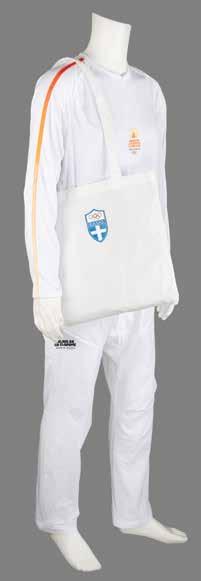
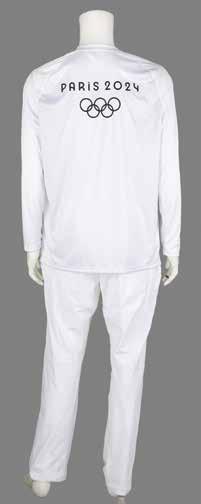
3040. Paris 2024 Summer Olympics Torch and Torchbearer’s Uniform. Incredibly rare official Paris 2024 Summer Olympics torch—the first to be offered at auction—constructed of recycled steel, designed by Mathieu Lehanneur and manufactured by ArcelorMittal, featuring a perfectly symmetrical, flowing design that draws inspiration from three themes of Paris 2024: equality, water, and peacefulness. The torch measures 27.5˝ long and 4˝ at its widest point: the upper half sports a matte finish on a plain surface, with the Paris 2024 insignia and five Olympic rings below; the lower half features a reflective finish on a rippled surface, inspired by the serenity of the water on the majestic River Seine. In total, only 2,000 torches were produced by ArcelorMittal, five times less than what was used at other recent Games.
The torch is accompanied by an original Paris 2024 Summer Olympics torchbearer uniform, size XL, comprising a
long-sleeve runner’s jersey, with “Relais de La Flamme Olympique, Paris 2024” emblem on the chest and large 2024 logo across the shoulders, and white athletic pants with the 2024 relay emblem on the upper thigh.
The Olympic flame was lit in a traditional ceremony in Olympia, Greece, on April 16, 2024, and carried through Greece for more than 3,100 miles to Athens, where it boarded the Belem—a three-masted sailing ship—to cross the Mediterranean Sea to Marseille, where it embarked on its epic journey across France. The relay route takes the Olympic flame through some of France’s most iconic places and architectural masterpieces, such as the Lascaux caves, the Alésia archaeological site, the medieval city of Carcassonne, the Palace of Versailles, and many other famous sites. The Olympic cauldron will be lit on July 26, 2024, at the opening ceremony of the Paris 2024 Olympic Games, marking the end of the 68-day Olympic torch relay. Starting Bid $1,000


3041. Athens 1870 Zappas Olympics Bronze Winner’s Medal in Original Box. Scarce winner’s medal issued for the 1870 Zappas Olympics in Athens. Bronze, 41 mm, 34 gm, by Albert Désiré Barre; manufactured by the Paris Mint. The front depicts a relief bust of King George of Greece encircled with Greek text: “George the First, King of the Hellenes”; the reverse features a laurel wreath with legend: “Olympia, at Athens, 1870,” with surrounding inscription: “Organizer of the Games Evangelis Zappas.” Stamped “Cuivre” on the edge. Complete with its rare original circular case, broken at the hinge.
Sponsored by Evangelis Zappas (1800-1865), a Greek patriot, businessman, and philanthropist, the Zappas Olympics was a series of athletic events held in Athens designed to reintroduce a modern version of the ancient games into the nation of Greece. The first was held in 1859, while the other three—1870, 1875, and 1888—were held posthumously in Zappas’ honor. Although not an international event, the Zappas Olympics were significant to the Games of today, as the modern arrangement of gold, silver, and bronze medals serving as awards for first, second, and third prizes was established according to the original plan of the Zappas Olympics. A scarce and desirable medal, with only 353 bronzes minted for the 1870 event. Starting Bid $200
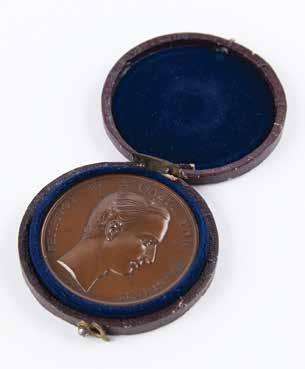
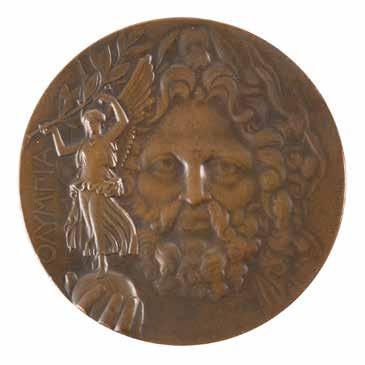

3042. Athens 1896 Olympics Bronze Winner’s Medal. Winner’s medal issued for the Athens 1896 Olympics. Bronze, 50 mm, 60 gm, by Jules Clement Chaplain. The front depicts a relief portrait of Zeus holding Nike, the goddess of Victory, in the palm of his hand, with text along left side, “Olympia”; the reverse bears a detailed view of the Acropolis of Athens topped by the Parthenon, with raised Greek characters to upper and lower portion (translated), “International Olympic Games in Athens, 1896.” Stamped “Bronze” on the edge. Complete with its original case lined in deep red velvet, exhibiting wear and scuffing to the exterior.
Winner’s medals from the historic debut of the Olympic Games remain exceedingly rare, with just 150 bronze second-place prizes originally struck for the Games. Uncommonly found with the original case, this is an exceptional example of this coveted Olympic medal. Representing the debut of one of the most sought-after prizes in the realm of sport, it is a terrific specimen. Starting Bid $5,000

medal silver plaque awarded to organizers of the Paris 1900 Olympics, with its rare original case
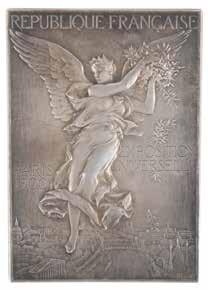
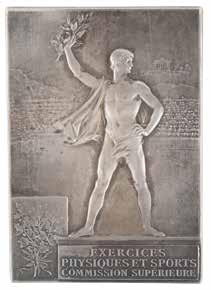

3043. Paris 1900 Olympics Silver Organizing Committee Plaque with Rare Case. Rare plaque issued for the Paris 1900 Olympics, taking the same form as the winner’s medals. Silver, 42 mm x 60 mm, 55 gm, by Frederic Vernon, Paris. The front, inscribed “Republique Francaise, Exposition Universelle, Paris 1900,” features a winged goddess scattering laurels over the grounds of the Exposition; the reverse identifies a Games commissioner as the recipient, “Exercices Physiques et Sports Commission Supérieure [Physical Exercises and Sports Higher Commission],” and depicts a victorious athlete upon a podium with a stadium and the Acropolis in the background. Stamped “Argent” on the edge. Housed in its rare original hinged case, gilt-stamped “Exposition Universelle, 1900” on the lid. A rare and beautiful piece from the Games, especially in its official case. Starting Bid $500
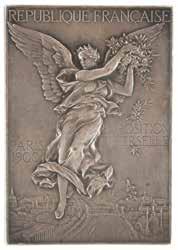

3045. Paris 1900 Olympics Silvered Bronze Winner’s Medal for Physical Exercises. Winner’s medal issued for the Paris 1900 Olympics. Silvered bronze, 42 mm x 60 mm, 57 gm, by Frederic Vernon, Paris. The front, inscribed “Republique Francaise, Exposition Universelle, Paris 1900,” features a winged goddess scattering laurels over the grounds of the Exposition; the reverse identifies the sport as physical exercise and sports, “Exercices Physiques et Sports,” and depicts a victorious athlete upon a podium. Stamped “Bronze” on the edge. Starting Bid $200
3046. Paris 1900 Olympics Winner’s Medal for Shooting. Attractive winner’s medal issued for the Paris 1900 Olympics. Silvered bronze, 38 mm x 57 mm, 58 gm, by Frederic Vernon, Paris. The front, inscribed “Republique Francaise, Exposition Universelle, Paris 1900,” features a winged goddess scattering laurels over the grounds of the Exposition; the reverse identifies the event as shooting, “Concours de Tir VIIme Concours National” [The 7th national shooting competition], and depicts a victorious athlete upon a podium. Stamped “Bronze” on the edge. Starting Bid $200

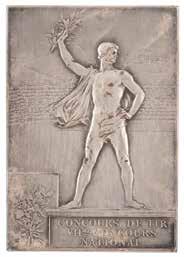

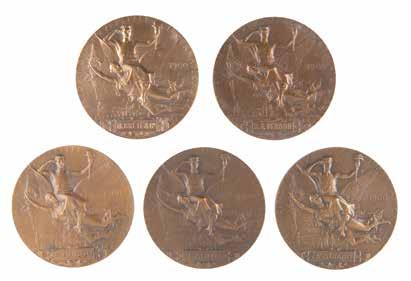
3044. Paris 1900 Exposition Universelle (5) Non-Athletic Award Medals. Attractive set of five non-athletic award medals issued for the Paris 1900 Exposition Universelle, which played host to that year’s Olympics. Each bronze medal measures 63.5 mm, weighs between 91 gm and 100 gm, and was designed by JulesClement Chaplain. The fronts depict a profile view of Marianne, the national symbol of the French Republic; the reverse sides bear an athlete with a torch riding on the back of Nike, the goddess of victory, with a tablet below issuing the medal to its recipient, which read: “R. A. Verron,” “A. Girard,” “Hardy,” “M. Crete & Cie,” and “E. Hubou.” Each is stamped on the edge with the Paris mint’s cornucopia symbol and “Bronze.” Since this Olympics did not issue participation medals, these non-athletic award medals are used as a placeholder in participation medal collections. With its classic Art Nouveau style, these uncommon awards exist as some of the most aesthetically pleasing of all Olympicrelated medals. Starting Bid $200
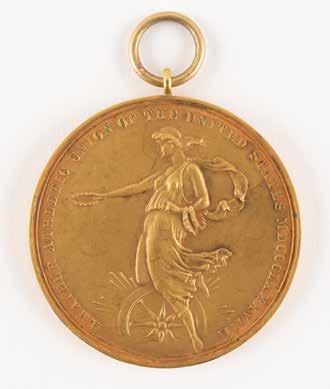

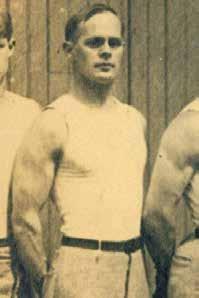

3047. St. Louis 1904 Olympics Gold Winner’s Medal for Rope Climbing - Presented to George Eyser, an American Gymnast with One Leg. Extraordinarily rare gold winner’s medal from the St. Louis 1904 Olympics, issued by the Amateur Athletic Union (AAU) to American gymnast George Eyser for placing first in the rope climbing competition. Solid gold, 31 gm, 44 mm, by Dieges & Clust, New York. The front of the medal depicts the goddess Fortuna on her Rota Fortunae [Wheel of Fortune] and holding a crown of laurels, encircled with raised text: “Amateur Athletic Union of the United States, MDCCCLXXXVIII”; the reverse is engraved with the name of the event, “Rope Climbing,” which is surrounded by sports equipment and the winged foot of Mercury, with text to the upper portion: “Champion.” The reverse also bears the maker’s mark and identifies the medal as “Solid Gold.” The medal bears trivial scuffs. Includes its original red-white-and-blue ribbon, which is in two pieces, the upper section retaining its golden badge with embossed text: “1904, Universal Exposition, Olympic Games, St. Louis.” Both ribbon sections bear toning and small tears. Gold, silver, and bronze medal AAU variants were inadvertently presented as official first-place prizes to an unknown number of podium finishers at the 1904 St. Louis Games, a rare distinction that, coupled with the medal’s recipient and its unusual event, isolates this award into a class all its own.
One of the more remarkable tales of Olympic lore relates to the recipient of this gold medal, American gymnast George Eyser, who secured six medals at the 1904 St. Louis Olympics…in one day…with just one leg. The son of German immigrants who moved to America in 1884, Eyser lost most of his left leg after being run over by a train in a

childhood accident. Undeterred, Eyser was fitted with a wooden prosthetic and joined the Concordia Turnverein [Turner] club in the southern suburbs of St. Louis. It was with Concordia that Eyser competed in the 1904 Games; during this period, the gymnastics competition was divided among club teams, not nations.
The 1904 games featured a muddled program of events spread out over several months, and the gymnastics competition was no different. The gymnastic events consisted of two sets, held in two seasons: the International Turners’ Championship on July 1 and 2, and the Olympic Gymnastics Championships on October 28th. Although Eyser faired poorly during the July competition, he was more than prepared for the October contests. In a single day, Eyser won three gold medals in the parallel bars, the long-horse vault, and the 25-foot rope climbing, the gold medal for which is offered here. He won three more medals in combined (silver), the horizontal bar (bronze), and the pommel horse (silver), capping off a historically successful day and one of the Olympics’ most inspirational stories. Prior to 2008, Eyser was the only person with an artificial leg to have competed at the Olympic Games. Starting Bid $5,000
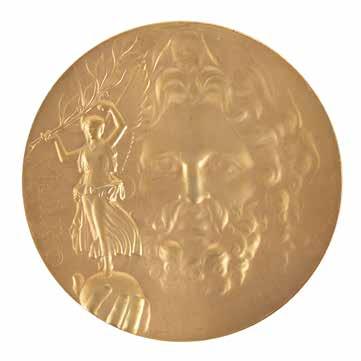

3048. Athens 1906 Intercalated Olympics Gold Winner’s Medal. Remarkable winner’s medal issued for the Athens 1906 Intercalated Olympics. Gilt silver, 50 mm, 63.5 gm, by Jules Clement Chaplain, Paris. The front features a portrait of Zeus holding Nike, the goddess of victory; the reverse features a view of Athens within a Greek legend. Stamped “Argent” on the edge. Complete with its form-fitting hinged red leather case.
The winner’s medals for the 1906 Athens Games share the same design as the Athens Olympics from 1896, with the ceremony year serving as the lone distinction. The 1906 Athens Games were considered the Olympics by the press and participants, which included 854 athletes from 20 countries, but they were never officially sanctioned by the International Olympic Committee. This is an immaculate example of the rare and beautiful gold medal from the unofficial fourth Olympic Games. Starting Bid $1,000

3049. Athens 1906 Intercalated Olympics Silver Winner’s Medal. Sought-after winner’s medal issued for the Athens 1906 Intercalated Olympics. Silver, 50 mm, 63 gm, by Jules Clement Chaplain. The front depicts a relief portrait of Zeus holding Nike, the goddess of Victory, in the palm of his hand, with text along the left side, “Olympia”; the reverse bears a detailed view of the Acropolis of Athens topped by the Parthenon, with raised Greek characters to the upper and lower portion (translated), “International Olympic Games in Athens, 1906.”
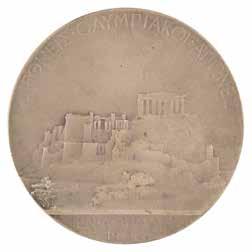
Stamped “Argent” on the edge. The winner’s medals for the 1906 Athens Games share the same design as the Athens Olympics from 1896, with the ceremony year serving as the lone distinction. The 1906 Athens Games were considered the Olympics by the press and participants, which included 854 athletes from twenty countries, but they were never officially sanctioned by the International Olympic Committee. A rare and beautiful winner’s medal from the unofficial fourth Olympic Games. Starting Bid $300


3050. Athens 1906 Intercalated Olympics Bronze Winner’s Medal. Scarce winner’s medal issued for the Athens 1906 Intercalated Olympics. Silver, 50 mm, 58 gm, by Jules Clement Chaplain. The front depicts a relief portrait of Zeus holding Nike, the goddess of Victory, in the palm of his hand, with text along the left side, “Olympia”; the reverse bears a detailed view of the Acropolis of Athens topped by the Parthenon, with raised Greek characters to the upper and lower portion (translated), “International Olympic Games in Athens, 1906.” Stamped “Bronze” on the edge. Housed in a round red faux leather box. The winner’s medals for the 1906 Athens Games share the same design as the Athens Olympics from 1896, with the ceremony year serving as the lone distinction. The 1906 Athens Games were considered the Olympics by the press and participants, which included 854 athletes from twenty countries, but they were never officially sanctioned by the International Olympic Committee. The first bronze example we have offered, this is a scarce and beautiful winner’s medal from the unofficial fourth Olympic Games. Starting Bid $300

3051. London 1908 Olympics Bronze Winner’s Medal for Shooting. Rare winner’s medal issued for shooting at the London 1908 Olympics. Bronze, 33.5 mm, 19 gm, designed by Bertram Mackennel; manufactured by Vaughton & Sons, England. The front, inscribed, “Olympic Games, London 1908,” features a victorious athlete being crowned with a laurel wreath by two seated females; the reverse depicts St. George, the patron saint of England, slaying a dragon as a goddess looks on. The rim is engraved with the name of the event, “Third Prize, Clay Birds Teams.” Includes the original presentation case. This medal was awarded to a member of the British men’s shooting team, which placed third in the men’s team trap event on July 11, 1908, finishing with a total of 372 points behind second and first-place winners Canada (405) and another team from Great Britain (407); each nation could enter up to two teams of six shooters. The Great Britain team members were George Skinner, William Morris, Henry Creasey, Bob Hutton, George Whitaker, and John Butt, the latter two winning
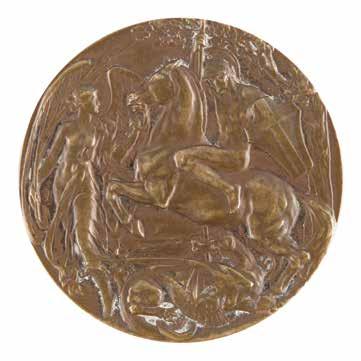
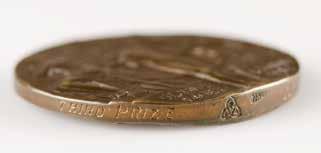
silver medals in team clay pigeons at the Stockholm 1912 Olympics. Great Britain dominated the Games with a total of 146 medals, far eclipsing second and third-place nations the United States (47) and Sweden (25); Great Britain’s top finish in the Olympic medal table marks the only instance the country has done so in its history. An exceptionally scarce winner’s medal commemorating Great Britain’s triumphant first outing as an Olympic host city. Starting Bid $300
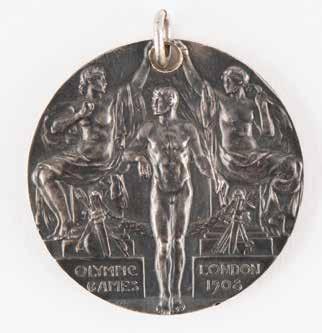
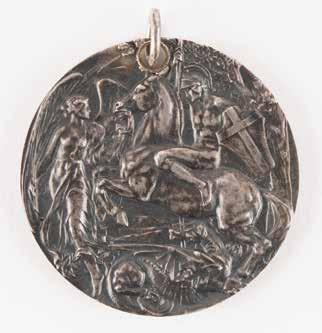
3052. London 1908 Olympics Silver Winner’s Medal for Football (Soccer). Scarce winner’s medal issued for football (soccer) at the London 1908 Olympics. Silver, 33.5 mm, 21 gm, designed by Bertram Mackennel; manufactured by Vaughton & Sons, England. The front, inscribed, “Olympic Games, London 1908,” features a victorious athlete being crowned with a laurel wreath by two seated females; the reverse depicts St. George, the patron saint of England, slaying a dragon as a goddess looks on. The edge is engraved with the name of the placing and event, “Runners Up, Association Football.” A hole has been bored to the upper rim and a small loop attached to allow for presentation purposes.
The London 1908 Games represent the debut of an official football tournament between national representative selections; the Games of 1900 and 1904 featured club football teams. The tournament, which featured a total of six teams, was held at White City Stadium from October 19th to the 24th, with Great Britain defeating runners-up Denmark in the gold medal match 2 to 0. Of particular note, Sophus ‘Krølben’ Nielsen of Denmark set a record by scoring 10 goals in a
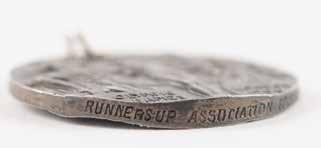

17–1 win over France, and the mathematician Harald Bohr, the younger brother of physicist Niels Bohr, also won a silver medal as a member of Denmark. A highly desirable winner’s prize from a popular event. Starting Bid $500
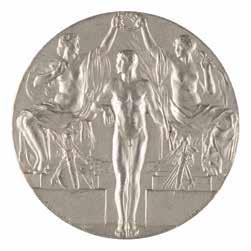

3053. Stockholm 1912 Olympics Aluminum Souvenir Winner’s Medal. Rare souvenir winner’s medal issued for the Stockholm 1912 Olympics. Aluminum, 33 mm, 16 gm, by Erik Lindberg and Bertram Mackennal. The front depicts a victorious athlete with a palm branch being crowned with a laurel wreath by two seated females; the reverse, encircled with the text, “Olympiska Spelen I Stockholm,” features a herald proclaiming the opening of the Olympic Games, with a bust of Ling, the founder of Swedish gymnastics, in the background. The front of the medal, designed by Mackennel, was originally used on the winner’s medals for the 1908 London Olympics. Aluminum winner’s medals were sold as souvenirs during the 1912 Games. However, despite their open availability to the public, souvenir winner’s medals from Stockholm remain quite scarce today. Starting Bid $200

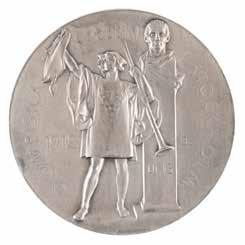
3054. Stockholm 1912 Summer Olympics Silver Winner’s Medal. Winner’s medal issued for the Stockholm 1912 Summer Olympics. Silver, 18 gm, 38 mm, by Bertram Mackennal and Erik Lindberg. The front depicts a victorious athlete with a palm branch being crowned with a laurel wreath by two seated females; the reverse, encircled with the text, “Olympiska Spelen I Stockholm,” features a herald proclaiming the opening of the Olympic Games, with a bust of Ling, the founder of Swedish gymnastics, in the background. The front of the medal, designed by Mackennel, was originally used on the winner’s medals for the 1908 London Summer Olympics.
Of the 2,408 participants at the Fifth Olympiad, a total of 90 athletes were awarded this second-place silver medal, with Sweden, the United States, Great Britain, and Germany winning the lion’s share. The 1912 Games proved a rousing and innovative success, introducing novel events like women’s diving and swimming, art competitions, and the pentathlon and decathlon, the latter two won by Jim Thorpe. These Olympics also witnessed the debut of Japan as a competing country, the first of any Asian nation to participate. A highly desirable winner’s medal from a truly historic Olympic Games. Starting Bid $300

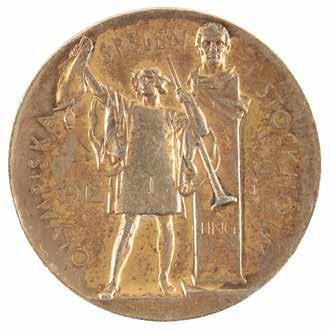
3055. Stockholm 1912 Olympics Team Gold Winner’s Medal. Winner’s medal issued for the Stockholm 1912 Olympics. Gilt silver, 33 mm, 18 gm, by Erik Lindberg and Bertram Mackennal. The front depicts a victorious athlete holding a palm branch as he is crowned with a laurel wreath; the reverse depicts a herald proclaiming the start of the Olympic Games with a bust of Ling, founder of Swedish gymnastics, to his rear. These gilt silver medals were awarded to the first-place winners of team events, while solid gold were given to the winners of individual events and a select few team competitions. Starting Bid $1,000


3056. Berlin 1916 Summer Olympic Trials
Gold-Plated Bronze Winner’s Medal [Canceled Games]. Winner’s medal issued for the German Olympic trials prior to the canceled Berlin 1916 Summer Olympics. Gilt bronze, 50 mm, 54 gm. The front features a bust of Kaiser Wilhelm II of Germany; the reverse reads (translated), “The Winner in the Olympic Trial Contest,” with “The German Committee for the Olympic Games” around the perimeter. The 1916 Olympics were scheduled to be held in Berlin, Germany, but were eventually canceled due to the outbreak of World War I. Any memorabilia related to the 1916 Olympiad is thus quite uncommon, with this being a particularly attractive example. Starting Bid $200
The return of the Summer Games— the first place winner’s medal from 1920 Antwerp, awarded to a member of Great Britain’s 4 x 400 relay team
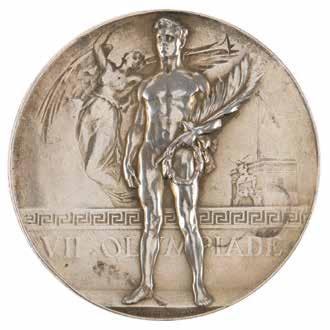
3057. Antwerp 1920 Olympics Gold Winner’s Medal. Winner’s medal issued to British sprinter Guy Butler at the Antwerp 1920 Olympics. Gilt silver, 60 mm, 88 gm, by Josue Dupon. The front shows a victorious athlete holding a laurel wreath and palm branch, with a statue of Renommee in the background, inscribed “VII Olympiade”; the reverse depicts the Brabo fountain above the Antwerp shield, with the Cathedral of Our Lady and city looming in the background, inscribed above, “Anvers MCMXX.” Bottom edge is stamped “A” for Argent and is engraved with the name of the event, the recipient, his teammates, and their placing: “U.K., 1st, G. M. B. Butler & (J. C. A. Davis, R. A. Lindsay, C. Griffiths), 1600 Meters Relay.” Accompanied by a silver-tone “Prize Medal” from Oxford & Cambridge Athletic Sports, 104 gm, 61 mm, with the reverse engraved: “1920, G. M. Butler, 1⁄4 Mile, 49 “.”
Sprinter Guy Butler (1899–1981) remains one of the most awarded runners in the long history of British Olympians. Butler’s four Olympic medals — this offered gold in the 4 x 400, an Antwerp silver in the 400-meter, and two bronzes in the same events in Paris four years later — tie him with
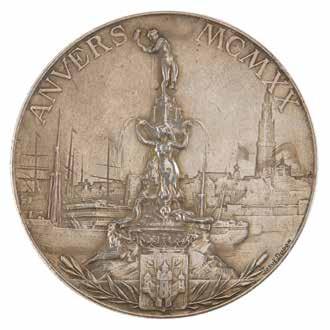
athletes Sebastian Coe, Christine Ohuruogu, and Mo Farah for the most athletic medals in British Olympic history.
Hosting the Olympics in 1920 was a challenging endeavor so close to the end of the war. Because of financing problems for the Games, many shortcuts had to be taken; one of them was reducing the amount of gold plating on the first-place winner’s medals. Unfortunately, most of the gilding wore off almost immediately and, as is often the case, many of the medals appear almost silver. Faint traces of gilding can still be discerned in the medal’s low relief areas.
A total of 29 nations attended the VII Olympiad in Antwerp, Belgium, with Hungary, Germany, Austria, Bulgaria, and the Ottoman Empire all banned from competing due to their involvement in World War I and the cancelation of the 1916 Games. Despite such political unrest, the return of the Games debuted a trinity of enduring Olympic traditions—the voicing of the Olympic Oath, the symbolic release of doves, and the initial flying of the Olympic flag. An exceptional first place medal of the utmost historical interest and rarity. Starting Bid $1,000
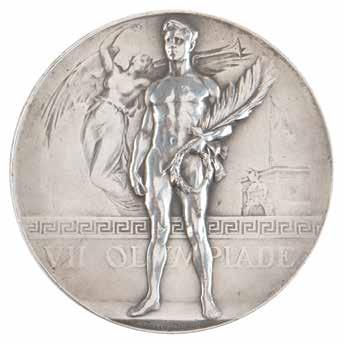
3058. Antwerp 1920 Summer Olympics Silver Winner’s Medal. Winner’s medal issued to British sprinter Guy Butler at the Antwerp 1920 Olympics. Silver, 60 mm, 87 gm, by Josue Dupon. The front shows a victorious athlete holding a laurel wreath and palm branch, with a statue of Renommee in the background, inscribed “VII Olympiade”; the reverse depicts the Brabo fountain above the Antwerp shield, with the Cathedral of Our Lady and city looming in the background, inscribed above, “Anvers MCMXX.” Bottom edge is stamped “A” for Argent and is engraved with the name of the event, the recipient, and his placing: “400 Meters, G. M. B. Butler, 2nd.” Accompanied by two sterling silver winner’s shield plaquettes issued to Butler at a Cambridge University Athletic Club track-and-field event at Trinity College in 1919, which identify Butler as the winner of the “1⁄4 Race” and the “100 Yds Race.”
Sprinter Guy Butler (1899–1981) remains one of the most awarded runners in the long history of British Olympians. Butler’s four Olympic medals — a gold in the 4 x 400 at Antwerp, this offered silver in the 400-meter, and two bronzes in the same events in Paris four years later — tie him with athletes Sebastian Coe, Christine Ohuruogu, and Mo Farah for the most athletic medals in British Olympic history.


A total of 29 nations attended the VII Olympiad in Antwerp, Belgium, with Hungary, Germany, Austria, Bulgaria, and the Ottoman Empire all banned from competing due to their involvement in World War I and the cancelation of the 1916 Games. Despite such political unrest, the return of the Games debuted a trinity of enduring Olympic traditions—the voicing of the Olympic Oath, the symbolic release of doves, and the initial flying of the Olympic flag. An exceptional first place medal of the utmost historical interest and rarity. Starting Bid $1,000
The first winner’s medal to incorporate the Olympic rings
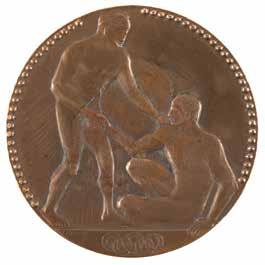
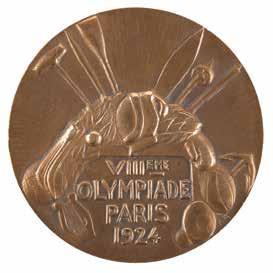
3059. Paris 1924 Summer Olympics Bronze Winner’s Medal. Uncommon winner’s medal issued for the Paris 1924 Summer Olympics. Bronze, 55 mm, 74 gm, by Andre Rivaud, Paris. The front depicts a triumphant athlete extending his hand to a fallen opponent, with the designer’s name “A. Rivaud” etched below his foot, and the Olympic rings at the bottom; the reverse, inscribed, “VIIIeme Olympiade, Paris 1924,” depicts a harp and various pieces of sporting equipment. Stamped “Bronze” on the edge. The winner’s medals for this Olympics were the first to incorporate the Olympic rings into the design. Only 304 of these attractive third-place bronze medals were issued at the Games. Starting Bid $500
Scarce silver prize from the 1924 Summer Games in Paris— the first medals to feature the Olympic rings
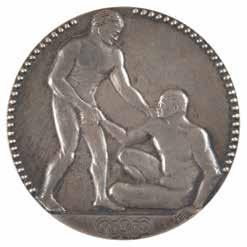

3061. Paris 1924 Summer Olympics Silver Winner’s Medal. Attractive winner’s medal issued for the Paris 1924 Summer Olympics. Silver, 55 mm, 76 gm, by Andre Rivaud, Paris. The front depicts a triumphant athlete extending his hand to a fallen opponent, with the designer’s name “A. Rivaud” etched below his foot, and the Olympic rings at the bottom; the reverse, inscribed, “VIIIeme Olympiade, Paris 1924,” depicts a harp and various pieces of sporting equipment. Stamped “Argent” on the edge. The winner’s medals for this Olympics were the first to incorporate the Olympic rings into the design. Only 304 of these attractive second-place silver medals were issued for the historic 1924 Games, which celebrate their centenary this summer. Starting Bid $300

3060. Paris 1924 Summer Olympics Gold Winner’s Medal for Boxing Great Jackie Fields. Rare winner’s medal issued to American featherweight boxer Jackie Fields at the Paris 1924 Summer Olympics. Gilt silver, 55 mm, 78 gm, by Andre Rivaud, Paris. The front depicts a triumphant athlete extending his hand to a fallen opponent, with the designer’s name “A. Rivaud” etched below his foot, and the Olympic rings at the bottom; the reverse, inscribed, “VIIIeme Olympiade, Paris 1924,” depicts a harp and various pieces of sporting equipment. Stamped “Argent” on the edge. The winner’s medals for this Olympics were the first to incorporate the Olympic rings into the design. Accompanied by myriad newspaper clippings related to the career of Jackie Fields.
First-place winner’s medals from the Paris 1924 Olympiad are exceedingly rare, with this stunning example representing just the second that we have ever offered. Further augmenting its desirability is the medal’s recipient, Jackie

Fields, one of the greatest welterweight boxers of all time. Born Jacob Finkelstein, Fields began his training at an early age, studying with legendary trainers Jack Blackburn and George Blake and sparring with future champs like Fidel LaBarba. He excelled as an amateur fighter, winning over 50 fights, and joined the American national team for the 1924 Paris Olympics. Fields went 5 and 0 against his international opponents and secured a gold medal in the featherweight division, becoming the youngest boxer to ever receive such an honor. The Olympic prize ignited the young boxer, who returned to the States to begin his career as a professional. Fields retired at the age of 25 with a record of 72 wins and nine losses, which included NBA, NYSAC, and The Ring welterweight titles. Fields was elected to the United Savings-Helms Hall of Boxing Fame in 1972, the International Jewish Sports Hall of Fame in 1979, the World Boxing Hall of Fame in 1987, and the International Boxing Hall of Fame in 2004. Starting Bid $2,000
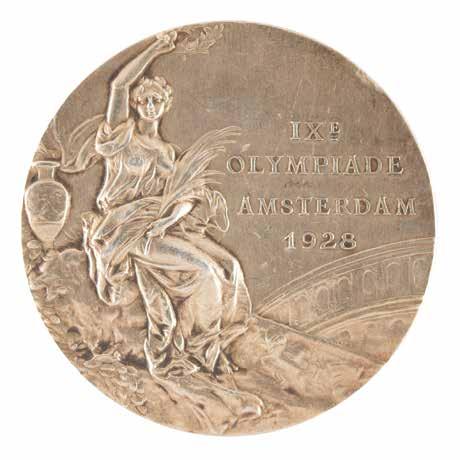

3062. Amsterdam 1928 Summer Olympics Gold Winner’s Medal. Winner’s medal issued for the Amsterdam 1928 Summer Olympics. Gilt silver, 55 mm, 68 gm, by Giuseppe Cassioli; manufactured by the Dutch State Mint of Utrecht, Netherlands. The front, inscribed, “IXe Olympiade, Amsterdam, 1928,” features a ‘Seated Victory’ with the Colosseum in the background; the reverse portrays a winner carried by jubilant athletes. The edge bears a stamped hallmark. The front bears slight fading to gilt, and a slight ding to the upper edge. Accompanied by two sterling silver presentation cups, 6˝ and 2.5˝ in height, with engraved inscriptions dated to 1926 and 1927; the taller cup ostensibly derives from the 1927 Swedish Athletics Championships, which occurred on July 31, 1927.
There were 254 of these gold medals produced, of which 110 were awarded to first-place winners in the 109 sporting events, an unequal number given that a first-place tie in the lightweight category of weightlifting resulted in two gold medals. Additionally, nine gold medals were also awarded to first-place winners of the 13 events of the art competitions, again an unequal number due to some events and categories that did not present medals.
This beautiful top prize medal represents an Olympiad noted for its legendary performances and the start of several enduring Olympic traditions—the Amsterdam Games were the first to bear the name ‘Summer Olympic Games’ and the very first to feature a fixed schedule of 16 days; Germany returned to competition after a 16-year ban; Tarzan actor Johnny Weissmuller won two gold medals in swimming; Finnish runner Paavo Nurmi won his ninth, and final, gold medal; and Mikio Oda of Japan became the first gold medalist from an Asian country after he won the triple jump event. Starting Bid $1,000


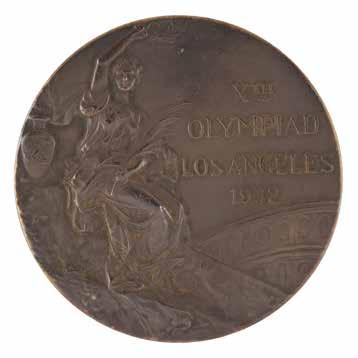
3063. Los Angeles 1932 Summer Olympics Gold Winner’s Medal with Box. Scarce winner’s medal issued for the Los Angeles 1932 Summer Olympics. Gilt silver, 55 mm, 97 gm, designed by Giuseppe Cassioli, minted by Whitehead & Hoag. The front, inscribed, “Xth Olympiad, Los Angeles, 1932,” features a ‘Seated Victory’ with the Coliseum in the background; the reverse portrays a winner carried by jubilant athletes. The medal exhibits uniform wear to the gilt on the obverse and edges. Complete with its Whitehead & Hoag paper box, with tape-repaired splits to the lid. A highly sought example of this classic design, extremely rare with its original box. The Olympic Games will make their historic return to Los Angeles in 2028, elevating the desirability of this beautiful first-place prize. Starting Bid $1,000

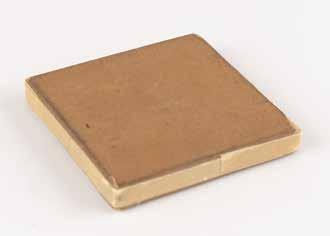


3064. Los Angeles 1932 Summer Olympics Bronze Winner’s Medal. Winner’s medal from the Los Angeles 1932 Summer Olympics. Bronze, 55 mm, 64 gm, designed by Giuseppe Cassioli, minted by Whitehead & Hoag. The front, inscribed, “Xth Olympiad, Los Angeles, 1932,” features a ‘Seated Victory’ with the Coliseum in the background; the reverse portrays a winner carried by jubilant athletes. An attractive third-place medal from the 10th Summer Olympic Games. Starting Bid $500
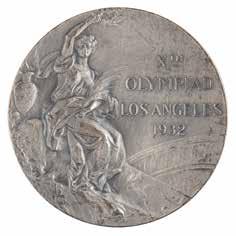
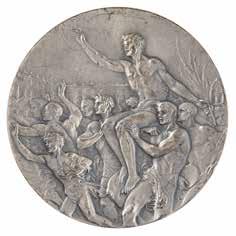
3065. Los Angeles 1932 Summer Olympics Silver Winner’s Medal. Winner’s medal issued for the Los Angeles 1932 Summer Olympics. Silver, 55 mm, 65 gm, designed by Giuseppe Cassioli and minted by Whitehead & Hoag. The front, inscribed, “Xth Olympiad, Los Angeles, 1932,” features a ‘Seated Victory’ with the Coliseum in the background; the reverse portrays a winner carried by jubilant athletes. A wonderful example of this classic design, issued for the Games of the X Olympiad in Los Angeles. These Games left a lasting legacy by setting new standards for future contests with innovations such as the Olympic Village and the use of automatic timing devices and photo-finish photography. Additionally, the event significantly boosted Los Angeles’ global profile, helping to establish the city as a major center for sports and entertainment. Starting Bid $300
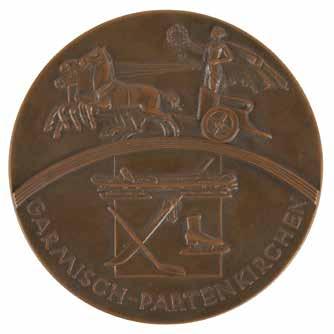
3067. Garmisch 1936 Winter Olympics Bronze Winner’s Medal. Impressive winner’s medal issued for the Garmisch 1936 Winter Olympics. Bronze, 100 mm, 334 gm, struck by Deschler and Sohn of Munich, Germany, and designed by Richard Klein. The front features a female holding a victory wreath and riding a triga on an arch above winter sports equipment, with raised text, “Garmisch-Partenkirchen”; the reverse shows the Olympic rings encircled with raised text, “IV Olympische, Winterspiele 1936.” Complete with its maroon case, stamped on the cover with the Olympic rings; the case exhibits substantial wear, with split corners and one side panel of the lid detached but present.
Only 755 athletes competed in these games, with a total of 36 gold, 36 silver, and 36 bronze medals minted. Any Garmisch winner’s medal is therefore exceedingly scarce and desirable. In addition to their high rarity, the Garmisch winner’s medals are among the largest and most impressive of all Olympic prize medals ever awarded. Starting Bid $1,000



3069. Berlin 1936 Summer Olympics Gold Winner’s Medal for Equestrian Show Jumping with Case. Historic winner’s medal awarded to German show jumper Kurt Hasse at the Berlin 1936 Summer Olympics. Gilt silver, 57 mm, 73 gm, by Giuseppi Cassioli. The front is inscribed “XI. Olympiad, Berlin, 1936” and features a ‘Seated Victory’ with the Coliseum in the background; the reverse portrays a winner carried by jubilant athletes; and the bottom edge is stamped “B. H. Mayer, Pforzheim, 990.” The medal bears some instances of rubbing to the gilt, wear to the edges, and a surface mar to the reverse. Complete with its scarce hinged presentation case, gilt-stamped on the lid with an emblem of the 1936 Berlin Olympic Bell.
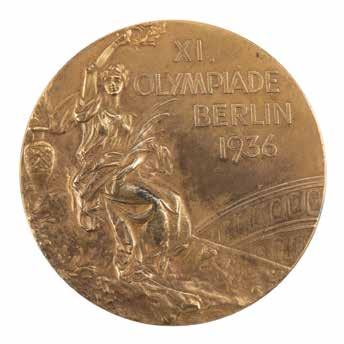
German show jumper Kurt Hasse, with his horse Tora, earned gold medals in the individual and team show jumping events at the Berlin 1936 Summer Olympics. The jumping test featured 20 obstacles and had a time limit of 160 seconds. Points were lost for faults (including elimination for the third refusal on the course) and for exceeding the time limit. Hasse lost just four points for upsetting an obstacle, and won the individual gold medal in a tie-breaking ‘jump off’ against Romanian rider Henri Rang. Riders performed a single round of jumping, with their scores tallied to determine results in the team competition. A career military officer, Hasse would be killed in action on the Eastern Front during World War II. Starting Bid $1000

3068. Berlin 1936 Summer Olympics Silver Winner’s Medal, with Other Medals and Trophies from the Collection of Equestrian Johan Jacob Greter. Extraordinary archive of medals, trophies, and souvenirs from the collection of Dutch equestrian Johan Jacob Greter, highlighted by the silver medal that he won at the Berlin 1936 Olympics, plus his participation medal and participant’s badge from the ‘36 Games. After performing in the Olympics in Nazi Germany, Greter would go on to distinguish himself in battle during World War II: he fought to defend his homeland against German aggression at the Grebbeberg on May 12, 1940, and was taken prisoner in 1942. He escaped by jumping off the train and reached England, where he joined the RAF. He received the Dutch Bronze Cross, awarded for acts of courage and leadership in the face of the enemy, in 1944 and 1947.
The three items from the Berlin 1936 Summer Olympics:
- Highly appealing winner’s medal issued for the Berlin 1936 Summer Olympics. Silver, 55 mm, 72 gm, by Giuseppe Cassioli. The front, inscribed, “XI. Olympiade, Berlin, 1936,” features a ‘Seated Victory’ with the Coliseum in the background; the reverse portrays a winner carried by jubilant athletes. Stamped on the edge, “B. H. Mayer, Pforzheim, 990.” Greter and his horse Ernica won this silver medal as part of the Dutch show jumping team, after finishing sixth in the individual jumping competition.
- Participation medal issued for the Berlin 1936 Summer Olympics. Brown bronze, 70 mm, 114 gm, by Otto Placzek. The front depicts five athletes, representing the five continents, pulling the ropes of the Olympic bell, with raised
text, “XI Olympiade, Berlin, 1936”; the reverse bears the Olympic bell embossed with the German eagle gripping the Olympic rings within five concentric circles, and the name of the designer on the outer edge.
- Participant’s badge issued for the 1936 Berlin Summer Olympics. Bronze, 41 mm x 46 mm, manufactured by Lauer, featuring the Olympic rings over the Brandenburg Gate. The front is engraved “XL Olympiade Berlin 1936, 3330.” Missing its ribbon.
Other items include: a silver windmill “Landenpris [Country Prize]” trophy from the 1934 “Concours Hippique International [International Horse Show]” held in Amsterdam; four Dutch National Olympic Committee/Dutch Sports Federation (NOC/NSF) ‘Olympic Day’ medals from 1933, 1934, 1935, and 1936; a 1936 “Concours Hippique International [International Horse Show]” medal with King Leopold of Belgium on the front; a 1936 “Olympische Proef [Olympic Trial]” first-place medal from 1936, engraved with the name of his horse, “Trixie,” issued by the Koninklijke Militaire Sportvereniging [Dutch Royal Military Sports Club]; a 1936 “Utrecht” medal plaque from an equestrian contest in the Netherlands; a zinc plaque portraying a rider in medieval armor, dedicated by the Aachen-Laurensberger Racing Club to the riders at the 1936 Olympic Games in Berlin and at the international equestrian tournament in Bad Aachen; an attractive silver-tone metal laurel wreath sculpture, with each leaf engraved with the name of one of Greter’s horses and an associated competition (with one cluster, and one single leaf detached from the wire frame); and a vintage photograph of Greter on a leaping horse, displayed in a leather frame. Starting Bid $500
3070. St. Moritz 1948 Winter Olympics Uniface Bronze Winner’s Medal. Unusual uniface winner’s medal issued as a sample or display variant for the St. Moritz 1948 Winter Olympics. Bronze, 60 mm, 80 gm, by Paul Andre Droz. This uniface medal features the front design only, with the French legend, “Vmes Jeux Olympiques D’Hiver, St. Moritz 1948,” situated between two snow crystals. The mint, “Hugenin,” is engraved below. The reverse is blank, but on awarded examples would feature a torchbearer’s hand with the Olympic motto.
The St. Moritz Games were the first to be celebrated following World War II, and were bestowed with the moniker, ‘The Games of Renewal.’ Due to their roles in the preceding war, both Japan and Germany were not invited to compete; they subsequently rejoined the Winter Games in 1952. Starting Bid $500
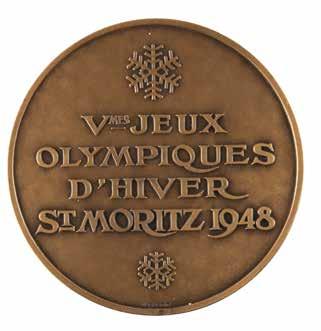
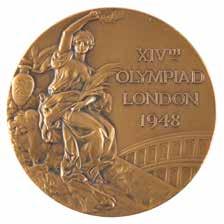
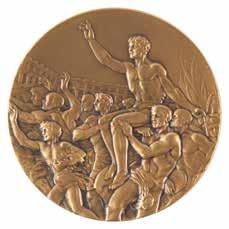

3071. London 1948 Summer Olympics Bronze Winner’s Medal. Winner’s medal issued for the London 1948 Summer Olympics. Bronze, 51 mm, 64 gm, by Giuseppe Cassioli. The front, inscribed, “XIVth Olympiad, London, 1948,” features a ‘Seated Victory’ with the Colosseum in the background; the reverse portrays a winner carried by jubilant athletes. Complete with its hinged case by John Pinches (Medalists) Ltd., London, gilt-stamped on the lid: “The Olympic Games, London, 1948.” These third-place winner’s medals are quite scarce given that only 300 of them were minted, and especially desirable when accompanied by the original case. A spectacular example of a handsome Olympic prize. Starting Bid $300
its original presentation case
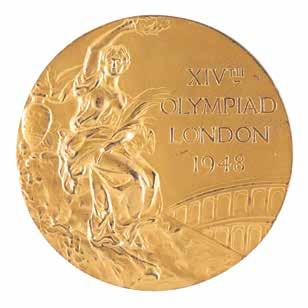
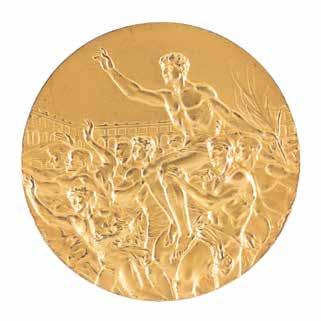
3072. London 1948 Summer Olympics Gold Winner’s Medal. Marvelous winner’s medal issued for the London 1948 Summer Olympics. Gilt silver, 51 mm, 76 gm, by Giuseppe Cassioli. The front, inscribed, “XIVth Olympiad, London, 1948,” features a ‘Seated Victory’ with the Coliseum in the background; the reverse portrays a winner carried by jubilant athletes. Complete with its original hinged case by John Pinches (Medalists) Ltd., London, gilt-stamped on the lid: “The Olympic Games, London, 1948.” The medal exhibits only minor rubbing to gilt on the edges, and the case bears light overall wear. A classic gold medal from a truly momentous Olympiad — the London Games represented the first Summer Olympics since 1936 after a 12-year hiatus due to World War II. With only 138 first-place winner’s medals awarded, they remain quite scarce — especially in their original cases — and are rarely seen in such fine condition. Starting Bid $1,000
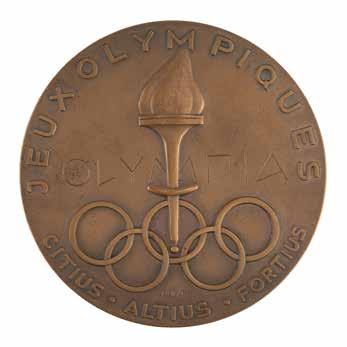
3073. Oslo 1952 Winter Olympics Bronze Winner’s Medal with Case. Especially rare winner’s medal issued for the Oslo 1952 Winter Olympics. Bronze, 70 mm, 118 gm, designed by V. Falireus/Knut Yran, and minted by Th. Marthinsen of Tonsberg, Norway. The front features a raised torch set in the Olympic rings within a French legend with the Olympic motto, “Jeux Olympiques, Citus - AltiusFortius,” with Greek lettering in the background, “Olympia”; the reverse, inscribed “De VI. Olympiske Vinterleker, Oslo 1952,” features a silhouette of Oslo City Hall and three snowflakes. Stamped on the edge, “Th. Marthinsen Norway.”

Housed in its hinged brown velvet presentation case, lined inside in velvet and silk, with the gilt of the Olympic rings on the lid worn away.
Only 48 bronze medals were manufactured for the Oslo Winter Games, 47 of which were awarded to third-place winners. It stands as one of the rarest of all modern Olympic medals, and of winner’s medals in general—this is the first example of an Oslo bronze winner’s medal that we have offered. Starting Bid $500
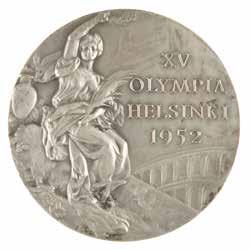

3074. Helsinki 1952 Summer Olympics Silver Winner’s Medal. Appealing winner’s medal issued for the Helsinki 1952 Summer Olympics. Silver, 51 mm, 68 gm, by Giuseppe Cassioli. The front, inscribed, “XV Olympia, Helsinki, 1952,” features a ‘Seated Victory’ with the Coliseum in the background; the reverse portrays a winner carried by jubilant athletes. Factory marks on the edge, “916H” and “Y6,” designate the silver content and mint. Includes its original dark blue presentation case. Only 320 of these silver second-place medals were awarded at the Helsinki games, making this an uncommon and sought-after example. Starting Bid $500
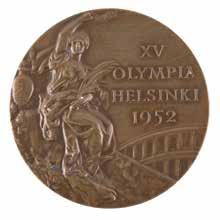


3075. Helsinki 1952 Summer Olympics Bronze Winner’s Medal and Pin. Appealing winner’s medal issued for the Helsinki 1952 Summer Olympics. Bronze, 51 mm, 59 gm, by Giuseppe Cassioli. The front, inscribed, “XV Olympia, Helsinki, 1952,” features a ‘Seated Victory’ with the Coliseum in the background; the reverse portrays a winner carried by jubilant athletes. Includes its scarce bronze winner’s medal pin (issued retroactively to Olympians in the 1980s), marked on the reverse, “9631,” with its black vinyl presentation pouch made by Bertoni of Milan. Only 320 of these bronze medals were issued at the Helsinki Games, making this an uncommon and sought-after example. The consignor notes that this medal and pin derive from a member of the Swedish men’s football (soccer) team, which placed third behind Yugoslavia and Hungary; the athlete’s name will be provided to the winning bidder. Starting Bid $300

3076. Cortina 1956 Winter Olympics Gold Winner’s Medal. Splendid winner’s medal issued for the Cortina 1956 Winter Olympics. Gilt silver, 60 mm, 120.5 gm, by Constantino Affer, Milan. The front, inscribed, “VII Giochi Olimpici Invernali,” features the head of Victory crowned in Olympic rings with a torch to the right; the reverse, inscribed, “Citius Altius Fortius, Cortina 1956,” portrays an ice crystal over Mt. Pomagagnon. The hallmark, “800,” and proof stamp are present on right-center edge of reverse, with the designer name, “Cost/Affer,” visible to the left of Victory’s neck, and the mint on the right rim, “Lorioli.”

Cortina d’Ampezzo was initially selected to host the fifth Winter Olympics in 1944, but the Games were canceled due to the onset of World War II. Awarded as a Winter host twelve years later, Cortina is best remembered for the debut of Soviet athletes in a Winter Olympiad, as well as for the first instance in which the Olympics were internationally televised. One of a total 51 first place prizes issued for the Cortina Games, this is an attractive and exceedingly scarce winner’s medal. Starting Bid $1,000


3077. Stockholm 1956 Summer Olympics Equestrian Events Bronze Winner’s Medal for Show Jumping (Team). Extremely rare winner’s medal issued to British equestrian Peter Robeson at the Stockholm 1956 Summer Olympics equestrian events. Bronze, 50 mm, 92 gm, by V. Falireus/John Sjosvard. The front depicts an ancient Greek horse and rider, inscribed with a Swedish legend, “XVI Olympiadens Ryttartavlingar, 1956, Stockholm.” The reverse portrays the torch and Olympic rings, with “Jeux Olympiques” above, and the Olympic motto below, “Citius, Altius, Fortius.” Stamped on the edge, “Lagerstrom / Mjolby.” Includes its rare green leather presentation case, as well as its accompanying third-place winner’s pin. Made by Bertoni of Milan, the bronze-tone pin features the Olympic rings above a banner with the contest year. Complete with its original paper backing marked as “8818” and its black vinyl presentation pouch made by Bertoni. These pins were issued retroactively to Olympians in the 1980s.

Robeson won a bronze medal in show jumping (team) at the 1956 Summer Olympics in Stockholm, Sweden, and eight years later landed another Olympic bronze medal when he placed first in the individual show jumping at the Tokyo 1964 Summer Games. In total, only 12 of these Stockholm bronze winner’s medals were awarded, making it an exceptionally rare Olympic medal. Starting Bid $2,000
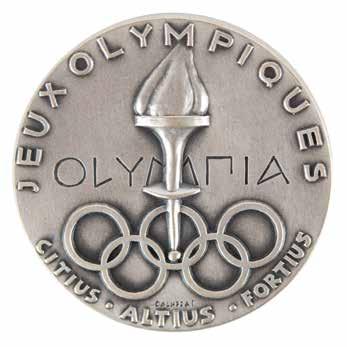
3078. Stockholm 1956 Summer Olympics Silver Winner’s Medal – one of 12 struck. Rare and highly sought winner’s medal issued for the Stockholm 1956 Summer Olympics equestrian events. Silver, 50 mm, 109 gm, by V. Falireus/John Sjosvard. The front depicts an ancient Greek horse and rider in relief, inscribed with a Swedish legend, “XVI Olympiadens Ryttartavlingar, 1956, Stockholm.” The reverse portrays raised imagery of the torch and Olympic rings, with “Jeux Olympiques” above, and the Olympic motto below, “Citius, Altius, Fortius.” The edge is stamped with the corresponding hallmark for Lagerstrom and Mjolby.
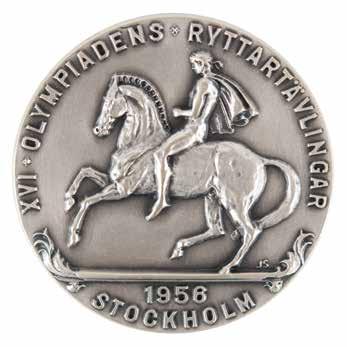
Due to Australian agricultural quarantine regulations, the equestrian events of Melbourne’s XVI Olympiad were held five months earlier in Stockholm, Sweden, making the 1956 Summer Games the second Olympics not to be held entirely in one country; the 1920 Olympics, which Antwerp, Belgium co-hosted with Amsterdam and Ostend, were the first. Given the low number of participants in the equestrian events—158 riders competed in six events—any medal from the Stockholm Games remains rare and highly sought-after. In total, only 12 of these Stockholm silver winner’s medals were awarded, making it an exceptionally rare Olympic medal. Starting Bid $2,500
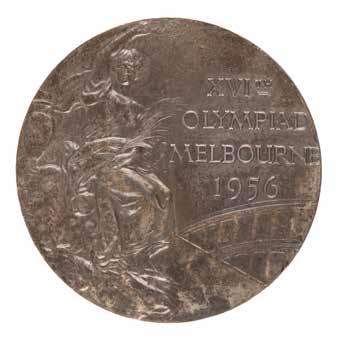
3079. Melbourne 1956 Summer Olympics Silver Winner’s Medal and Participation Medal for Football. Extremely desirable winner’s medal issued for the Melbourne 1956 Summer Olympics. Silver, 51 mm, 67 gm, by Giuseppe Cassioli; manufactured by K. G. Luke. The front, inscribed, “XVIth Olympiad, Melbourne, 1956,” features a ‘Seated Victory’ with the Colosseum in the background; the reverse portrays a winner with a palm branch being carried by jubilant athletes. Includes the original white plastic case by K. G. Luke/Casecraft, with red “XVIth Olympiad” label on the cover, which exhibits chipping to the front lid panel. This prize medal design had been adopted from the Amsterdam 1928 Summer Games, with the only alteration for 1956 being a change in wording to reflect the year and location. There were 280 of these silver medals produced, with 273 of them being awarded; the consignor notes that the recipient of this example was Croatian soccer star Ivan Sˇantek, who was a member of the silver medal–winning Yugoslavian national football team. After blowing out the competition in the quarter-finals (9-1 against the USA) and semi-finals (4-1 against India), the Yugoslavia lost 1-0 to the Soviet Union in the championship match.
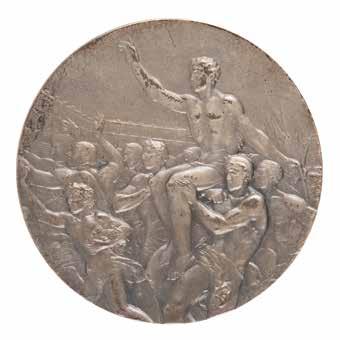


Additionally includes the participation medal issued to Ivan Sˇantek for his role as part of the Yugoslavian national football team at the Melbourne 1956 Summer Olympics. Bronze, 63 mm, 105 gm, by Andor Meszaros. The front depicts the Olympic motto encircled by pairs of athletes following the march of a flag-bearer; the reverse bears the Melbourne coat of arms and Olympic rings, with raised text along the top, “Olympic Games Melbourne, 1956.” Starting Bid $500
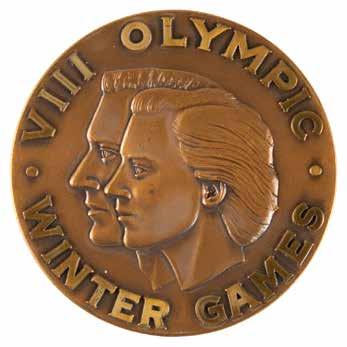
3080. Squaw Valley 1960 Winter Olympics Sample Bronze Winner’s Medal for Biathlon. Rare sample bronze winner’s medal for the Squaw Valley 1960 Winter Olympics. Bronze, 57 mm, 90 gm, by Herff Jones, Indiana. The front features embossed heads of male and female athletes in profile, with bold text: “VII Olympic, Winter Games”; and the reverse is encircled with raised text of the Olympic motto, “Citius, Altius, Fortius,” and the sport, “Biathlon,” and the center stamped “Sample” below the Olympic rings in relief. Edge is engraved, “H. J. CO.”

The Squaw Valley 1960 Winter Olympics hosted the first appearance of modern biathlon in the Olympic Games, which consisted of one event that was held at McKinney Creek Stadium, Tahoma, California, on February 21, 1960. 30 athletes from nine nations competed, with Sweden’s Klas Lestander, Finland’s Antti Tyrvainen, and the Soviet Union’s Aleksandr Privalov taking the top three prizes.
Starting Bid $500


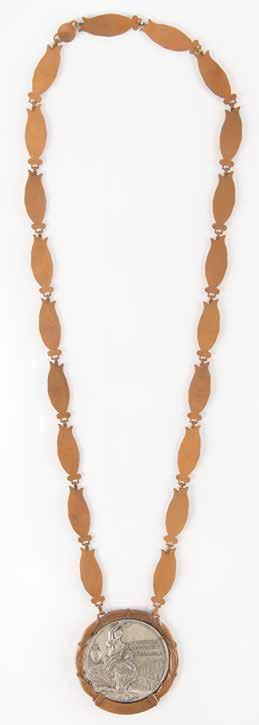
3081. Rome 1960 Summer Olympics Silver Winner’s Medal for Athletics. Winner’s medal issued for an athletics event at the Rome 1960 Summer Olympics. Silver, 68 mm, 110 gm (216 gm with chain), by Giuseppe Cassioli; manufactured by Artistice Fiorentini. The front depicts a victorious athlete being carried by several jubilant athletes; the reverse, inscribed, “Giochi Della XVII Olimpiade Roma MCMLX,” features a ‘Seated Victory’ with the Colosseum in the background. The medal is set in its original cast bronze bezel, engraved at the bottom with the name of the sport in Italian, “Atletica,” and suspends from its beautiful bronze winner’s chain with 20 olive leaf links. Includes its rare original red leather presentation case, 20.25˝ x 4.5˝ x 1˝, designed by Stabilimenti Artistici Fiorentini of Florence, which is slightly warped, features wear to edges, and the inner velvet lining detached but present. The winner’s medals issued for the 1960 Rome Olympics were the first designed to be worn around the neck and the first for any Summer Games to feature the name of the specific sport. The consignor notes that this silver Medal was won by West German athlete Jo (Johannes) Kaiser in the 4 x 400-meter relay race. Kaiser ran the third leg together with teammates Hans-Joachim Reske, Manfred Kinder, and Carl Kaufmann, achieving a time of 3:02.7 min., which was a European record and a close second to the USA Team’s world record gold. For this achievement, Kaiser was also awarded the Silver Laurel Leaf on December 9, 1960, the highest sporting award presented by the Federal Republic of Germany. Starting Bid $1,000

3082. Rome 1960 Summer Olympics Bronze Winner’s Medal for Shooting. Beautiful winner’s medal issued for a shooting event at the Rome 1960 Summer Olympics. Bronze, 68 mm, 102 gm, by Giuseppe Cassioli. The front depicts a victorious athlete being carried by a jubilant crowd; the reverse, inscribed, “Giochi Della XVII Olimpiade Roma MCMLX,” features a ‘Seated Victory’ with the Colosseum in the background. The medal is set in its original cast bronze olive leaf chain, inscribed at the bottom with the name of the sport in Italian, “Tiro.”

Six of these bronze medals were awarded for shooting in six different events. A total of 313 shooters from 59 countries competed at the Rome Games; the nations that took third-place prizes included the Soviet Union, Japan, Venezuela, and the United Team of Germany. The winner’s medals issued for the 1960 Rome Olympics were the first designed to be worn around the neck and the first for any Summer Games to feature the name of the specific sport. An extraordinary, iconic piece. Starting Bid $10,000
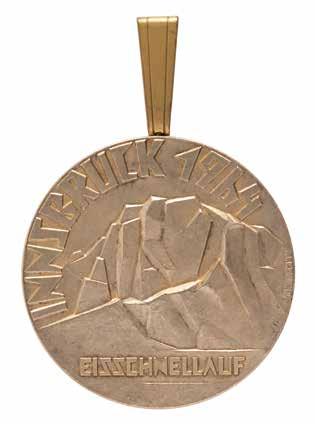
3083. Innsbruck 1964 Winter Olympics Gold Winner’s Medal for Speed Skating. Rare winner’s medal from the Innsbruck 1964 Winter Olympics. Gilt silver, 70 mm, 167 gm, by M. Coufal, Vienna. The front, inscribed, “Olympische Winterspiele IX,” features the Innsbruck Olympic emblem; the reverse identifies the sport as speed skating, “Eisschnellauf,” with raised text, “Innsbruck 1964,” over a large jagged mountain. The bottom edge is stamped with a silver hallmark.

Held at the Eisschnelllaufbahn Innsbruck between January 30th and February 7th, the men’s and women’s speed skating events of the Innsbruck Winter Games were dominated by the Soviet Union, a team that amassed nearly half of the 25 winner’s medals, including a field-leading five gold medals. This attractive example, one of only 70 first-place medals issued at Innsbruck, represents just our second gold medal from the IX Olympic Winter Games. Starting
Bid $1,000
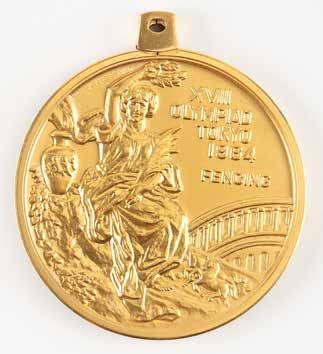

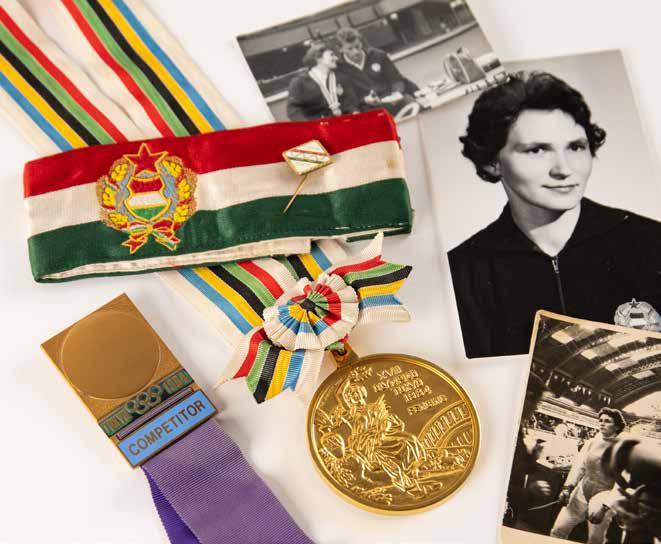
Gorgeous gold medal from the 1964 Tokyo Summer Games, presented to a prominent member of the Hungarian women’s fencing team—includes her competitor’s badge, Olympic team armband, and other Japanese keepsakes
3084. Tokyo 1964 Summer Olympics Gold Winner’s Medal for Fencing. Winner’s medal issued to Hungarian fencer Judit Ágoston-Mendelényi at the Tokyo 1964 Summer Olympics. Gilt silver, 63 mm, 100 gm, by Toshikaka Koshiba (based on the classic design of Giuseppe Cassioli); manufactured by the Japanese Mint. The front is inscribed, “XVII Olympiad Tokyo 1964, Fencing,” and features a ‘Seated Victory’ with the Colosseum in the background; the reverse depicts a victorious athlete being carried by several jubilant athletes. The medal is complete with its original ribbon with Olympic colors and its attractive black lacquer box, the lid of which features the emblem of the Games and one golden dot indicating first place; the box’s hinge is broken and there is wear to the inner lining.
Includes her gold-plated competitor’s badge from the 1964 Tokyo Summer Olympics, 38 mm x 63 mm, 46 gm, which features the rising sun of the Japanese national flag above a green bar with Olympic rings and a blue enamel bar identified as “Competitor.” The badge’s solid purple ribbon extends an additional 76 mm. The badge, presented with its original white leather presentation box, includes an original stickpin for the Hungarian national team from the 1964 Tokyo Games.
Other accompaniments include: seven photos of ÁgostonMendelényi at the Tokyo Games, one of which is signed and another of her wearing her gold medal; a Hungarian national team armband; a purple armband with a vector globe and 1964 in golden thread; a plastic souvenir ‘Tokai Bank’ coin bank from the Tokyo 1964 Summer Olympics; an Englishlanguage souvenir of a Japanese fabric booklet scroll, with label reading (transcribed) “Japan’s Four Seasons”; and a black vintage SAS (Scandinavian Airlines) hand fan.
The women’s team foil event of the Tokyo 1964 Summer Games was held at Waseda Memorial Hall on October 16 and 17th, with a total of 47 fencers from 10 competing nations. The event made its Olympic debut four years prior at the 1960 Rome Olympics with the Soviet Union emerging victorious over their Hungarian rivals. However, Judit Ágoston-Mendelényi and her four Hungarian teammates enacted their revenge in Tokyo. They secured a gold medal by ousting the Soviet fencers in the finals with a score of 9 to 7, a victory that laid the foundation for the future of Hungarian women’s fencing. To date, the Hungarian fencing team (men and women) remains one of the most celebrated in Olympic history—only Italy (130) and France (123) have won more Olympic fencing medals than Hungary (90). Starting Bid $1,000
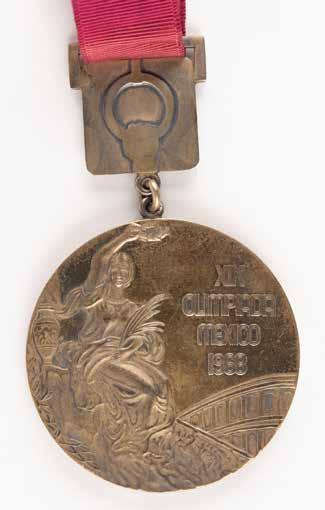
3086. Mexico City 1968 Summer Olympics Gold Winner’s Medal for Gymnastics. Winner’s medal issued for gymnastics at the Mexico City 1968 Summer Olympics. Gilt silver, 60 mm, 125 gm, originally designed by Giuseppe Cassioli. The front is inscribed, “XIX Olimpiada Mexico 1968,” and features a ‘Seated Victory’ with the Colosseum in the background; the reverse depicts a victorious athlete with a palm branch being carried by several jubilant athletes. A small plaque attached to the top of the medal bears the gymnastics pictogram of hand gripping a ring, with the reverse engraved, “viga de equilibrios,” or ‘balance
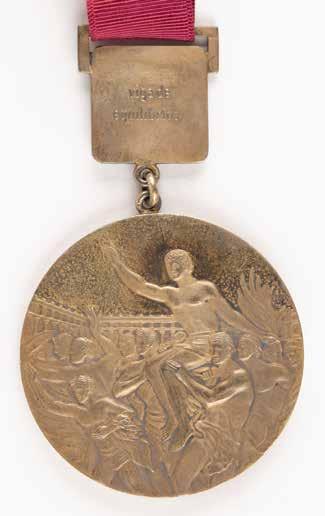
beam,’ and the plaque bearing the original burgundy ribbon.
Mexico winner’s medals with their original pictogram plaque are quite uncommon, with this example all the more historic given the popularity of its event—the gymnastics competition stands among the most beloved of all Summer Olympic events. Soviet gymnast Natalia Kuchinskaya, who earned four medals at the ‘68 Games and was dubbed the ‘Sweetheart of Mexico’ by an admiring press, finished first in the balance beam event after a controversial scoring revision. Starting Bid $1,000
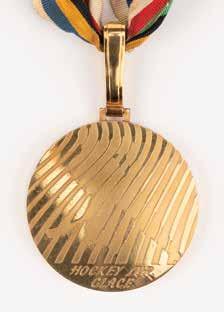

3085. Grenoble 1968 Winter Olympics Gold Winner’s Medal for Ice Hockey with Case. Sought-after winner’s medal issued for the Grenoble 1968 Winter Olympics. Gilt silver, 60 mm, 124 gm, designed by Roger Excoffon and manufactured by the Paris Mint. The front, inscribed, “Xemes Jeux Olympiques D’Hiver, Grenoble 1968,” features the symbol of Grenoble, a snow crystal and three roses, and the Olympic rings; the reverse identifies the sport as ice hockey, “Hockey sur Glace,” and depicts a stylized silhouette of a hockey player. Complete with original colorful ribbon and attractive black leather presentation case by Monnaie de Paris. The medal’s ribbon is creased and stained, and the case exhibits some staining to the interior and rubbing to the exterior. Winner’s medals for the Grenoble 1968 Winter Olympics were produced for the first time with a unique design for each sport. The Soviet Union dominated the Olympic ice hockey competition, which counted as the Olympic Championship, World Championship, and European Championship. The USSR went 7-1 in tournament play, dropping the penultimate match to the rival Czechoslovakian team. In the final match, the Soviets triumphed over Canada to win gold, solidifying their position as a powerhouse in international ice hockey during the era. Starting Bid $500
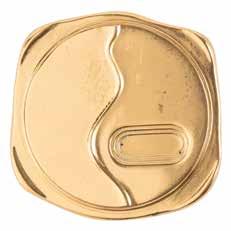
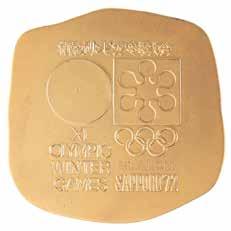
3087. Sapporo 1972 Winter Olympics Gold Winner’s Medal Prototype. Rare prototype of a gold winner’s medal for “Slalom” at the Sapporo 1972 Winter Olympics. Gilt silver, 64 mm x 58 mm, 144 gm, designed by Kazumi Yagi and Ikko Tanaka and struck by the Mint Bureau of the Finance Ministry (Tokyo). The front features a vertical and raised curving line next to recessed concentric ovals, designs meant to denote a ski slalom trail and a speed skating stadium and to produce feelings of peace and security; the reverse features the embossed emblem of the XI Olympic Winter Games with the event engraved neatly to the lower right: “Slalom.” A beautiful prototype example of the elusive Sapporo gold winner’s medal. Starting Bid $250
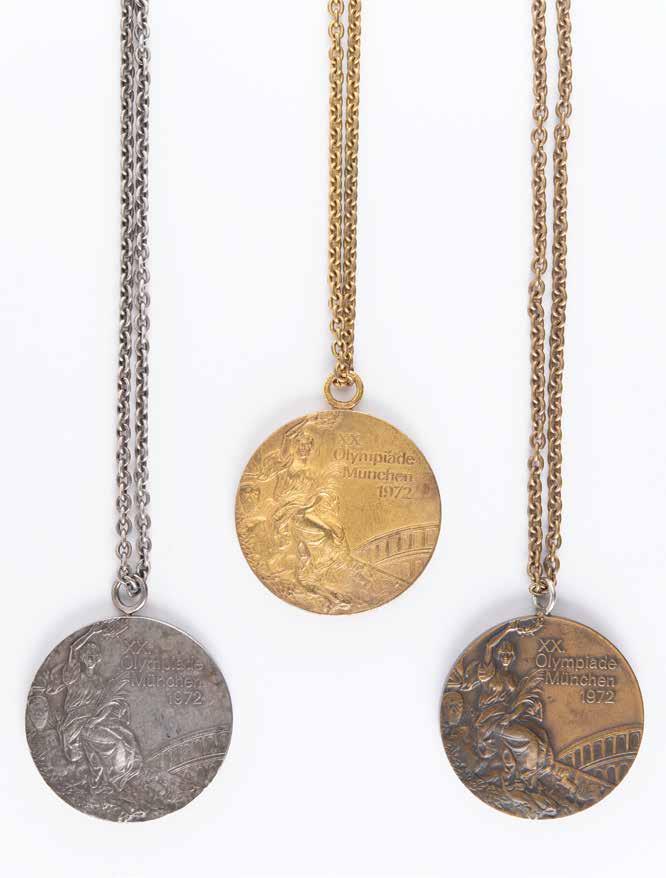
swimmer Steve Genter, who risked his life for the Olympic dream, sacrificed his Olympic career for an American teammate
3088. Steve Genter’s Collection of Munich 1972 Summer Olympics Gold, Silver, and Bronze Winner’s Medals. Historic offering of three winner’s medals that were awarded to legendary American swimmer Steve Genter at the Munich 1972 Summer Olympics, consisting of his gold medal in the 4 x 200-meter freestyle relay, his silver medal in the 200-meter freestyle, and his bronze medal in the 400-meter freestyle.
The gold (gilt silver) medal weighs 160 gm (without chain) or 211 gm (with chain), the silver medal weighs 152 gm (without chain) or 203 gm (with chain), and the bronze medal weighs 130 gm (without chain) or 176 gm (with chain); each medal measures 85 mm. The Munich 1972 winner’s medals were designed by Gerhard Marcks and share the same design to both sides: the front is inscribed, “XX. Olympiade Munchen 1972,” and depicts the ‘Seated Victory’ with the Colosseum in the background; and the reverse portrays the mythological twins Castor and Pollux, the patrons of competitive sport and friendship, with the artist’s monogram below. This was the first winner’s medal since 1928 to feature a new design on the reverse, replacing the traditional depiction of a victorious athlete carried by a jubilant crowd. The top edge of each medal is engraved “Genter, Steven,” with the name of the event: “Schwimmen 4 x 200 m Freistil Herren” (gold), “Schwimmen 200 m Freistil Herren” (silver), and “Schwimmen 400 m Freistil Herren” (bronze). The medals, which each retain their original chain, bear slight instances of marks or discoloration, most noticeable to the bronze reverse. The winning bidder will be granted a one-on-one phone call with Steve Genter.
The Munich massacre. Mark Spitz’s gold medal glory. The controversial ending of the men’s basketball final. These and several other storylines dominated the headlines of the historic 1972 Summer Olympics. It’s perhaps no wonder then that the inspiring tale of American swimmer Steve Genter didn’t receive an outpouring of publicity. At least, not immediately.
A 6-foot 4-inch undergraduate from UCLA, Genter entered the Olympics as a podium favorite and as the chief competitor to teammate Mark Spitz. He also entered Munich with a nagging cough, a lingering effect from bronchitis developed
during the Olympic trials. A week before his first scheduled event, the 200-meter freestyle, Genter complained of a ‘gushy’ feeling in his chest. Concerned, he visited a Munich hospital. The news was not good: he had a collapsed lung.
Doctors inserted a chest tube to release the trapped air, with Genter himself assisting in the process by squeezing rubber inflation balls for five days and nights. Determined to compete, Genter refused any pain medication, fearful that it might contain a controlled substance. By the fifth day, his lung had inflated back to normal and, with the consent of coaches and doctors, Genter was permitted to swim.
On August 29th, a day after being released from the hospital, Genter hit the water for the finals of his 200 freestyle event. His plan to build from the first 100 meters was working, he was leading the pack, Spitz was in his wake. Then, at the 135-meter mark, everything changed. Pain pierced through Genter’s chest. His stitches had ruptured. Seconds later he blacked out. But Genter didn’t stop swimming. With no feeling in his extremities, he doggedly pushed forward, finishing second with a miraculous last-ditch effort. Two days later, a recovered Genter split a 1.52.48 on the 4 x 200-meter relay, a blistering time that would have won the gold medal in the 200 freestyle event and set a world record.
Genter’s bronze medal is just as impressive, albeit for very different reasons. On September 1st, Genter placed third in the 400-meter freestyle, with 16-year-old teammate Rick DeMont taking gold and Australian Brad Cooper taking silver. However, Genter was later officially declared as the second-place finisher after the IOC stripped DeMont of his gold medal; Team USA doctors errantly allowed DeMont to use his asthma medication (Marax) that contained the banned substance ephedrine. When the IOC gave Genter the ultimatum of returning his bronze and accepting the silver, or facing a lifetime ban from Olympic competition, Genter chose the latter in support of his American friend and teammate. An exemplary complete winner’s medal set that embodies the Olympic odyssey of Steve Genter, whose elite displays of athleticism, courage, and sportsmanship define precisely what it means to be a champion. Starting Bid $1,000


3089. Munich 1972 Summer Olympics Gold Winner’s Medal. Highly sought-after unawarded winner’s medal issued for the Munich 1972 Summer Olympics. Gilt silver, 66 mm, 158 gm (without chain) or 211 gm (with chain), by Gerhard Marcks; manufactured by the Bavarian Mint. The front is inscribed, “XX. Olympiade Munchen 1972,” and depicts the ‘Seated Victory’ with the Colosseum in the background; the reverse portrays the mythological twins Castor and Pollux, the patrons of competitive sport and friendship, with the artist’s monogram below. The medal bears overall toning, and the loop to the upper edge has snapped cleanly at the base; the detached loop is present. Complete with its original golden chain, hinged plastic presentation box, and cardboard slipcover, which bears staining and marks to the top. This was the first winner’s medal since 1928 to feature a new design on the reverse, replacing the traditional depiction of a victorious athlete carried by a jubilant crowd. Starting Bid $1,000
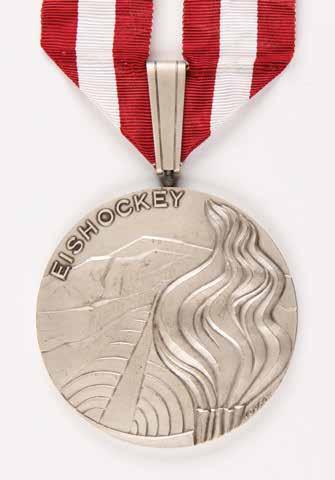
3090. Innsbruck 1976 Winter Olympics Silver Winner’s Medal for Ice Hockey. Rare winner’s medal issued for ice hockey at the Innsbruck 1976 Winter Olympics. Gilt silver, 72 mm, 161 gm, by M. Coufal, Vienna. The front, inscribed, “Olympische Winterspiele XII, Innsbruck 1976,” features the Innsbruck Olympic emblem; the reverse identifies the sport as hockey, “Eishockey,” and portrays the Bergisel ski jump with the Alps in the background. Stamped “A925” on the edge. Complete with original red-and-white ribbon and hinged presentation case, with the “Innsbruck 1976” emblem on the lid. The case exhibits some scuffing and rubbing.
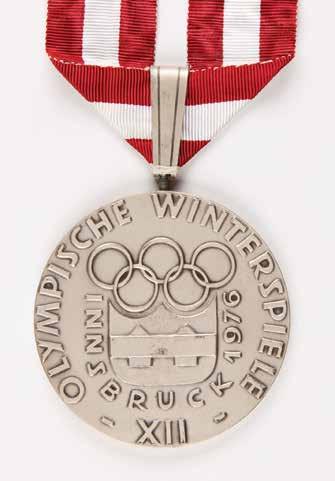
The 1976 Winter Olympic ice hockey tournament served as a showcase for the rivalry between the USSR and Czechoslovak national teams. In the gold-medal game, Czechoslovakia was up 2–0 after the first period. In the second, the score was tied by Vladimir Shadrin and Vladimir Petrov. Eight minutes before the end of the game Eduard Novák scored the third goal for the Czechoslovak team. But rapid-fire goals by Aleksandr Yakushev and Valeri Kharlamov—in the span of a minute—led to the 4-3 victory of the USSR. The Czech team earned silver medals for their valiant effort against the powerhouse Soviet squad, which won gold for the fourth consecutive Olympiad. Starting Bid $1,000


3091. Montreal 1976 Summer Olympics Gold Winner’s Medal for Rowing. Winner’s medal issued for rowing at the Montreal 1976 Summer Olympics. Gilt silver, 60 mm, 160 gm, by Giuseppe Cassioli, minted by the Royal Canadian Mint, Ottawa. The front, inscribed, “XXIe Olympiade Montreal 1976,” features a ‘Seated Victory’ with the Coliseum in the background; the reverse features the Montreal Olympic emblem and victor’s laurel wreath. The bottom edge is engraved with the sport, “Aviron.” Complete with its golden chain.
Rowing at the 1976 Summer Olympics in Montreal featured races in 14 events, all held at the rowing basin on Notre Dame Island. The Montreal Games also marked the debut of women’s rowing events, as well as the introduction of quadruple sculls. A total of 593 rowers from 31 nations competed: East Germany dominated with nine first-place finishes, with Bulgaria, the Soviet Union, Norway, and Finland also earning gold medals. Starting Bid $1,000

3092.Lake Placid 1980 Winter Olympics Bronze Winner’s Medal for Speed Skating with Case. Bronze winner’s medal awarded to East German speed skater Sabine Becker for the Lake Placid 1980 Winter Olympics. Bronze, 80 mm, 180 gm, by Tiffany and Co. of New York. The front, inscribed “XIII Olympic Winter Games,” depicts a raised hand holding the Olympic torch against a mountain backdrop, with the Olympic rings to the right side; the reverse features a small Lake Placid Games emblem and a large conifer branch with pinecones, inscribed “Lake Placid 1980,” and engraved with the event and winner’s name, “Speedskating, 1,500m. Women, Becker Sabine.” Inscribed on the bottom edge, “Tiffany & Co., Bronze, 1979.” The medal exhibits trivial instances of tarnishing,

and lacks its ribbon. Complete with its hinged Tiffany & Co. dark blue leather presentation case, stamped on the lid with the insignia of the Lake Placid 1980 Winter Olympics, as well as its Tiffany & Co. cardboard box. With gorgeous Tiffany’s craftsmanship and striking designs, this is a highly sought-after bronze medal from a memorable Olympics.
The 1980 Winter Olympic speed skating events were held from February 9–18 at the outdoor James B. Sheffield Olympic Skating Rink in Lake Placid. An excellent long-distance skater, Sabine Becker reached the podium for both the 1,500m and 3,000m women’s speed skating events, demonstrating her versatility and endurance. Starting Bid $500

3093. Moscow 1980 Summer Olympics Bronze Winner’s Medal. Desirable winner’s medal awarded for a weightlifting event at the Moscow 1980 Summer Olympics. Bronze [tombac], 60 mm, 120 gm, by Ilya Postol, Moscow. The front, inscribed in Cyrillic, features a ‘Seated Victory’ with the Colosseum in the background; the reverse features the Moscow Olympic emblem and Olympic flame. The bottom edge is engraved “ТЯЖЕЛАЯ
in Cyrillic to indicate the associated sport, weightlifting. The medal is missing its colorful ribbon, and the ribbon loop has been neatly filed off of the top edge.
The United States led sixty-five countries in a boycott of the 1980 Moscow Summer Games to protest the Soviet

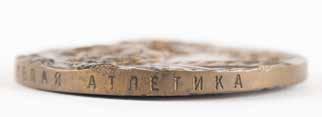
invasion of Afghanistan. Between the important historical events surrounding the 1980 Moscow Olympics and the scarcity of these uncommon medals, they hold a special international appeal and are sought by collectors worldwide—this is just the second third-place prize we have offered. Starting Bid $500

3094. Sarajevo 1984 Winter Olympics Unawarded Gold Winner’s Medal. Rare unawarded winner’s medal issued for the Sarajevo 1984 Winter Olympics. Gilt silver, 65 mm x 71 mm, 165 gm, by Majdanpek, Belgrade. The front, inscribed, “XIV Zimske Olimpijske Igre, Sarajevo 1984,” features the Olympic rings and Sarajevo emblem; the reverse features a stylized athlete’s head with laurel crown. Complete
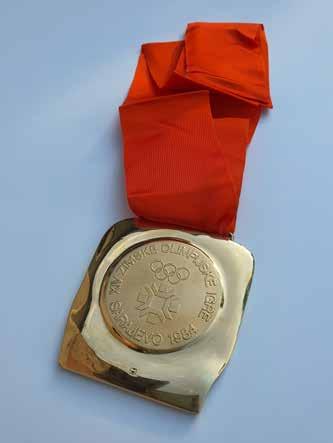
with its original orange ribbon and handsome leather case with paper box. Only 95 gold medals were produced for the XIV Olympic Winter Games, and of the total of 285 medals manufactured, 222 were awarded while the balance was presented to members of the International Olympic Committee and placed for safekeeping in the Sarajevo Olympic Museum. Starting Bid $500

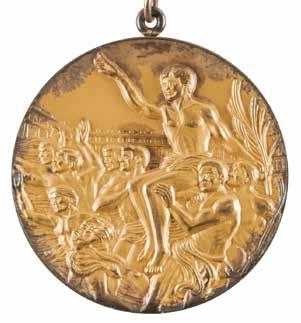
3095. Los Angeles 1984 Summer Olympics Gold Winner’s Medal. Winner’s medal issued for the Los Angeles 1984 Summer Olympics. Gilt silver, 63.5 mm, 144 gm, designed by Dugald Stermer and struck by Jostens, Indianapolis. Inspired by the original design by Giuseppe Cassioli, the front of the medal is inscribed, “XXIII Olympiad, Los Angeles 1984,” and features a ‘Seated Victory’ with the Colosseum in the background, and the reverse portrays a victorious athlete being carried by a jubilant crowd. The edge is inscribed with the name of the event, “Weightlifting”; the athlete’s name will be provided to the winning bidder. Complete with original magenta, vermillion, and yellow ribbon, which is separated at the seam. Exhibits some rubbing and wear to the gilt on the rim, the edge, and relief high points. Only 478 of these gold medals were produced for the LA Games. A scarce, attractive medal from this memorable USA-hosted Olympiad. Accompanied by a signed letter of provenance from the winning athlete. Starting Bid $2,500



3096. Los Angeles 1984 Summer Olympics Bronze Winner’s Medal for Shooting. Winner’s medal awarded to American shooter Daniel Carlisle for the Los Angeles 1984 Summer Olympics. Bronze, 63.5 mm, 116 gm, designed by Dugald Stermer and struck by Jostens, Indianapolis. Inspired by the original design by Giuseppe Cassioli, the front of the medal is inscribed, “XXIII Olympiad, Los Angeles 1984,” and features a ‘Seated Victory’ with the Colosseum in the background, and the reverse portrays a victorious athlete being carried by a jubilant crowd. The edge is inscribed with the name of the event, “Shooting, Olympic Trap.” Suspended from its original magenta, vermillion, and yellow ribbon. A scarce, attractive medal won by an American at this memorable USA-hosted Olympics. Starting Bid $500

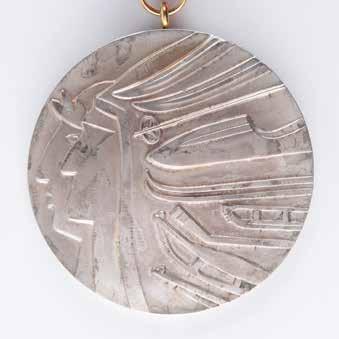

3097. Calgary 1988 Winter Olympics Silver Winner’s Medal for Alpine Skiing with Case. Exceptionally rare silver winner’s medal issued to West German skier Frank Worndl for “Alpine Skiing, Men Slalom” at the Calgary 1988 Winter Olympics. Silver, 70 mm, 191 gm, designed by Peter Friedrich and struck by Jostens. The front depicts combined profiles of a laureated athlete and a First Nations indigenous person whose headdress is formed by winter sporting equipment; the reverse bears the stylized snowflake/maple leaf emblem of the Games and the Olympic rings at the center, with surrounding raised bilingual text: “XVes Jeux Olympiques d’hiver, XV Olympic Games, Calgary 1988.” The edge of the medal is engraved in English and French with the name of the event: “Alpine Skiing Men Slalom.” The medal, which exhibits some wear and toning, includes its cyan, red, and blue ribbon (ends not sewn together) and original blue velvet case.
After subpar results at the 1980 Lake Placid Games, German alpine skier Frank Worndl (born 1959) returned to Olympic competition as a favorite eight years later. Worndl, a slalom world champion at the FIS Alpine World Ski Championships in 1987, turned in two amazing slalom runs and earned a spot on the winner’s podium, taking silver and missing out on a gold medal by .007 seconds. An exceedingly rare silver winner’s medal awarded to one of the most successful German alpine skiers in history. Starting Bid $500
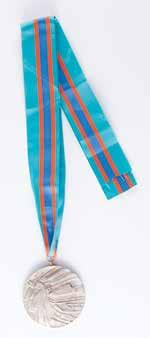

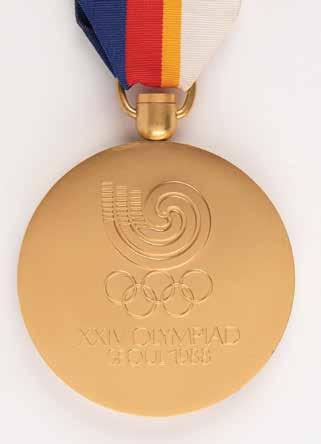
3098. Seoul 1988 Summer Olympics ‘Exhibition Sport’ Gold Winner’s Medal for Badminton. Scarce ‘exhibition sport’ winner’s medal issued for the Seoul 1988 Summer Olympics. Gilt silver, 60 mm, 152 gm, by the Korea Security Printing and Minting Corporation. The front features the mascot of the Games, Hodori, playing badminton over “XXIV Olympiad / Seoul 1988”; the reverse features the emblem of Seoul’s XXIV Olympiad. The edge is engraved with the name of the even, “Badminton.” Complete with its original ultramarine, red, orange, and white ribbon, and its purple velvet presentation case. The medal has some minor edgewear, and the case exhibits some foxing to the inner lining.
Badminton was an exhibition sport at the 1988 Summer Olympics in Seoul, featuring five events: men’s singles, women’s singles, men’s doubles, women’s doubles, and mixed doubles. Competitions took place at the Seoul National University Gymnasium on September 19th. South Korea had three gold medal victories, and China had two first-place finishes. Starting Bid $500
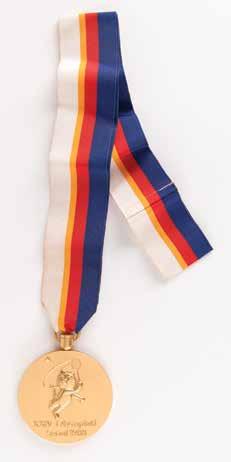
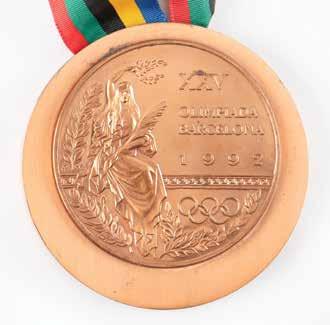

3099. Barcelona 1992 Summer Olympics Bronze Winner’s Medal. Scarce winner’s medal issued for the Barcelona 1992 Summer Olympics. Bronze, 70 mm, 224 gm, by Xavier Corbero (Fábrica Nacional de Moneda y Timbre). The front depicts a seated Victory in Modernist style holding a winner’s crown and a palm branch with Olympic rings and raised text: “XXV, Olimpiada Barcelona, 1992”; and the reverse features the Games logo of a stylized man leaping over the Olympic rings. Includes a replacement ribbon.
The 1992 Summer Olympics were the last competition to be staged in the same year as the Winter Olympics and the first summer games since the end of the Cold War. In the wake of the Soviet Union’s dissolution in 1991, the Baltic nations of Estonia, Latvia, and Lithuania sent their own teams for the first time since 1936, with the 12 other former Soviet republics competing as the Unified Team, a collective that led the Olympiad with a total of 112 medals. Starting Bid $300

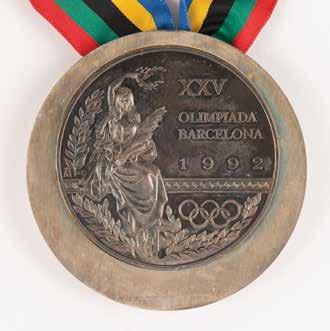

3100. Barcelona 1992 Summer Olympics Silver Winner’s Medal. Winner’s medal issued for the Barcelona 1992 Summer Olympics. Silver, 75 mm, 269 gm, by Xavier Corbero; manufactured by Fábrica Nacional de Moneda y Timbre. The front depicts a seated Victory in Modernist style holding a winner’s crown and palm branch with Olympic rings and raised text: “XXV, Olimpiada Barcelona, 1992”; and the reverse featuring the Games logo of a stylized man leaping over the Olympic rings. Includes a cut segment original ribbon with Olympic colors, still attached to the medal. The medal exhibits overall tarnishing.
The 1992 Summer Olympics were the last competition to be staged in the same year as the Winter Olympics, and the first summer games since the end of the Cold War. In the wake of the Soviet Union’s dissolution in 1991, the Baltic nations of Estonia, Latvia and Lithuania sent their own teams for the first time since 1936, with the twelve other former Soviet republics competing as the Unified Team, a collective that led the Olympiad with a total of 112 medals. Starting Bid $500
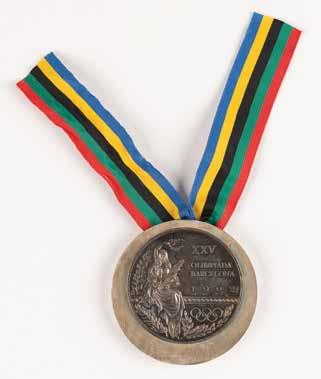


3101. Barcelona 1992 Summer Olympics Gold Winner’s Medal. Winner’s medal issued for the Barcelona 1992 Summer Olympics. Gilt silver, 75 mm, 236 gm, by Xavier Corbero; manufactured by Fábrica Nacional de Moneda y Timbre. The front depicts a seated Victory in Modernist style holding a winner’s crown and palm branch with Olympic rings and raised text: “XXV, Olimpiada Barcelona, 1992”; the reverse features the Games logo of a stylized man leaping over the Olympic rings. Complete with its striped ribbon in five Olympic colors. The medal exhibits overall tarnishing.
The 1992 Summer Olympics were the last competition to be staged in the same year as the Winter Olympics, and the first summer games since the end of the Cold War. In the wake of the Soviet Union’s dissolution in 1991, the Baltic nations of Estonia, Latvia and Lithuania sent their own teams for the first time since 1936, with the twelve other former Soviet republics competing as the Unified Team, a collective that led the Olympiad with a total of 112 medals. Starting Bid $500


3102. Lillehammer 1994 Winter Olympics Bronze Winner’s Medal for Luge. Winner’s medal issued for the Lillehammer 1994 Winter Olympics. Bronze, 78 mm, 122 gm, by Ingjerd Hanevold; manufactured by Th. Marthinsen of Tonsberg. The medal contains a polished circular piece of 600 million-year-old sparagmite that was collected from the Lillehammer Olympic Park during the construction of the Lysgardsbakkene Ski Jumping Arena. The front of the medal features the Olympic rings in bronze, with the bronze ice crystal design and the interior stone engraved, “Lillehammer ‘94” and “The XVII Olympic Winter Games”; the reverse retains the ice crystal design and includes the Lillehammer Games emblem with a large pictogram of a luge athlete, inscribed on the inset stone and rim: “Luge - Double Men.”

The rim is stamped with the initials of the designer and mint, and the medal bears slight scuffing and lacks its ribbon.
According to designer Ingjerd Hanevold, she intended the medals to be ‘humorous, sober, and recognizable’ and stated that their design is ‘Norwegian through and through.’ Her choice of sparagmite was in keeping with the guiding principles behind the Lillehammer Games as a means of presenting Norway’s genuine natural surroundings and increasing national environmental awareness. ‘The medals symbolize the very essence of Norway, the Norwegian mountain landscape. The stone also serves a symbolic function; it reminds us of how precious our earth and nature are, and how important it is that we protect them.’ Starting Bid $500
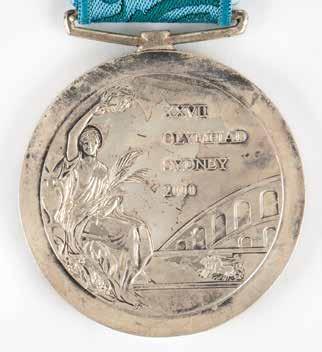
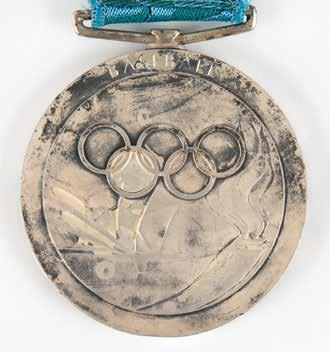
3103. Sydney 2000 Summer Olympics Silver Winner’s Medal for Baseball. Desirable winner’s medal awarded for baseball at the Sydney 2000 Summer Olympics. Silver, 68 mm, 185 gm, by Wojciech Pietranik and Brian Thompson; manufactured by the Royal Australian Mint. The front depicts a ‘Seated Victory’ with the Colosseum in the background; the reverse portrays the Olympic rings over the iconic Sydney Opera House, with the Sydney Olympic torch at right, inscribed above, “Baseball.” The front and reverse bear uneven toning that is typical of Sydney silver winner’s medals. The medal exhibits wear and significant tarnishing throughout, typical of Sydney silver winner’s medals. Complete with the original blue ribbon embroidered in silver with the legend, “Sydney 2000,” with two pins attached.
Cuba won silver in the 2000 Summer Olympics baseball tournament after being shut out by the U.S. in the championship game; this was just the second game the Cuban team ever lost during Olympic play. The star of the team was Jose Contreras, who defected from the country to play in the Major Leagues two years later. A highly desirable silver winner’s medal, enhanced by its status as a piece of baseball memorabilia. Starting Bid $500

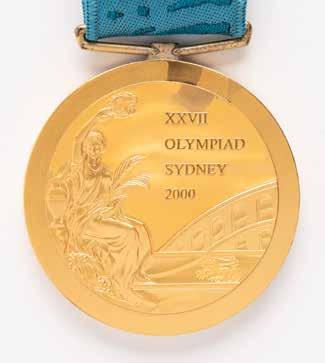

3104. Sydney 2000 Summer Olympics Gold Winner’s Medal for Taekwondo. Winner’s medal from the Sydney 2000 Summer Olympics awarded to Cuban martial artist Ángel Matos, who placed first in the men’s taekwondo (80 kg) competition. Gilt silver, 68 mm, 193 gm, by Wojciech Pietranik and Brian Thompson; manufactured by the Royal Australian Mint. The front depicts a ‘Seated Victory’ with the Colosseum in the background; the reverse portrays the Olympic rings over the iconic Sydney Opera House, with the Sydney Olympic torch at right, and sport and category engraved in the upper and lower rim, “Taekwondo” and “Men’s Under 80 KG.” Complete with the original blue ribbon embroidered in silver with the legend, “Sydney 2000,” and the original round case with metal base and hinged plastic cover. Medal bears some slight discoloration to the front, and the reverse bears a small area of gilt loss above the engraved sport.
Cuban martial artist Angel Matos holds a lofty, if not contro-
versial, position within the annals of Olympic competition. One of the world’s most talented taekwondo practitioners in the 80 kg weight class, Matos earned a gold medal at the 2000 Summer Olympics in Sydney with a convincing string of victories, culminating with a 3-1 defeat of Germany’s Faissal Ebnoutalib in the championship round.
Although Matos was unable to place at the 2004 Athens Games, he returned to the Beijing Olympics in 2008 and fought his way to the bronze medal match. Matos injured his foot during the bout and requested a Kyeshi, a one-minute injury time-out. When Matos didn’t return to the ring center or ask for more time, the Olympic referee ruled that Matos, who was leading the match 3-2, had retired, and that his opponent, Kazakhstan’s Arman Chilmanov, was the winner. Matos, in a moment of madness, kicked the referee, an action that resulted in his lifetime ban from the World Taekwondo Federation and the International Olympic Committee. Starting Bid $1,000

3105. Sydney 2000 Summer Olympics Bronze Winner’s Medal for Women’s Handball. Desirable winner’s medal awarded to a member of the Norwegian women’s handball team at the Sydney 2000 Summer Olympics. Bronze, 70 mm, 166 gm, by Wojciech Pietranik and Brian Thompson; manufactured by the Royal Australian Mint. The front depicts a ‘Seated Victory’ with the Colosseum in the background; the reverse portrays the Olympic rings over the iconic Sydney Opera House, with the Sydney Olympic torch at right, inscribed in the upper and lower rim, “Handball, Women.” Complete with the original blue ribbon embroidered in silver with the legend “Sydney 2000.” Accompanied by its associated participant pin from the Sydney 2000 Summer Olympics, housed in its white vinyl Bertoni pouch.


The Sydney 2000 Summer Olympiad has been recognized as one of the finest ever hosted, earning universal acclaim from the public and media. The women’s handball competition took place at The Dome (Sydney Olympic Park), and saw Denmark win gold, Hungary take silver, and Norway finish third. Norwegian standout Kjersti Grini led the entire tournament in scoring, with 61 goals on 96 shots. Starting Bid $500

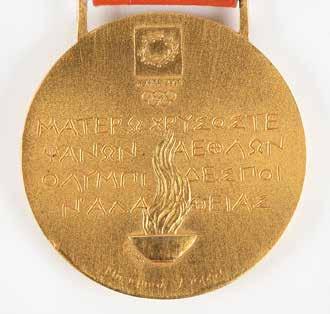
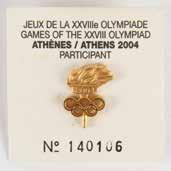
3106. Athens 2004 Summer Olympics Gold Winner’s Medal for Baseball. Stunning winner’s medal awarded for baseball at the Athens 2004 Summer Olympics. Gilt silver, 61 mm, 147 gm, by Elena Votsi and Kostas Kazakos. The front depicts the winged goddess of Victory soaring into the Panathinaikos Stadium, with Greek characters and Olympic rings above; the reverse features the Eternal Flame of Olympia, the opening lines of Pindar’s Eighth Olympic Ode, and the 2004 Summer Games logo, with the sport engraved in Greek lettering along the bottom, “Μπέιζμπολ Aνδρών [Men’s Baseball].” Completed by the original multicolored ribbon, with a Cuban emblem pin and Athens 2004 pin attached. The highly attractive medal exhibits only minor edgewear. Accompanied by a participant pin from the Athens 2004 Summer Olympics, housed in its white vinyl Bertoni pouch, which exhibits some wear.
The Cuban Olympic baseball team displayed a formidable combination of pitching prowess, defensive excellence, and offensive firepower at the 2004 Summer Olympics in Athens, Greece, losing only one game in the tournament en route to a gold medal victory. The 2004 Athens winner’s medals replaced the long-held ‘seated Victory’ design by Giuseppe Cassioli, rectifying the mistake of using a depiction of the Roman Colosseum rather than a Greek venue.Starting Bid $1,000

3107. Torino 2006 Winter Olympics Silver Winner’s Medal. Stunning unawarded winner’s medal issued for ice dancing at the Torino 2006 Winter Olympics. Silver, 470 gm, 108 mm, designed by Quatrini and minted by Ottaviani International. The front features a fluid geometric design of the emblem of the Games at the bottom; the reverse has a polished pictogram of the sport—figure skating—and is engraved with the event, “Mixed Ice Dancing.” The edge is engraved in Italian, French, and English: “XX Giochi Olimpici Invernali, XX Jeux Olympiques d’Hiver, XX Olympic Winter Games.” The uniquely designed medal has a hole at the center, through which the red, gold, and fuschia ribbon is tied. Complete with its original wood-and-plastic curved display case and cardboard box, which is creased. At the time, the Torino winner’s medal was the largest ever issued. Starting Bid $1,000


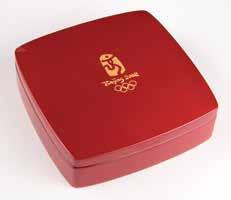
3109. Beijing 2008 Summer Olympics Winner’s Medal Presentation Box. Official winner’s medal box from the Beijing 2008 Summer Olympics, consisting of a beautifully crafted red rosewood presentation case, 6˝ x 6˝ x 1.75,˝ with the lid bearing the engraved gilt emblem of the Games of the XXIX Olympiad and the inside bearing luminant yellow lining and a removable medal tray. The case is completed by its traditional Chinese brocade box, 6.75˝ x 6.75˝ x 2.5˝, the overlying pattern redolent of the ‘Propitious Clouds’ design found on the official Beijing torch. In very fine condition. Starting Bid $200

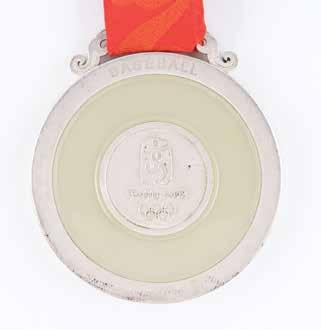
3108. Beijing 2008 Summer Olympics Silver Winner’s Medal for Baseball. Marvelous winner’s medal for the Beijing 2008 Summer Olympics. Silver with inlaid jade, 70 mm, 186 gm, by Medal Design Group, China Central Academy of Fine Arts, Elena Votsi. Created from ancient Chinese jade patterns, the medal consists of silver and jade, symbolizing nobility and virtue. Jade has been regarded as a virtue since ancient times, and the embodiment of Chinese traditional values of ethics and honor. The front depicts the standing goddess of Victory against panoramic imagery of the Panathinaikos Arena, with the text above reading: “XXIX Olympiad Beijing 2008”; and the reverse features the Beijing Games emblem surrounded by inlaid jade and the outer circle engraved with the sport, “Baseball.” The design inspiration of the medal hook derives from jade ‘Huang,’ a ceremonial jade piece decorated with a double dragon pattern, and ‘Pu,’ the reed mat pattern. Includes the original red-and-orange ribbon.
Held at the Wukesong Baseball Field between August 13–23, the baseball tournament of the 2008 Beijing Games consisted of a preliminary round-robin format—all eight teams playing each other once—and single elimination rounds featuring the top four countries. South Korea was a dominant force throughout the Olympics, going 7-0 in preliminaries en route to staying undefeated and winning the gold medal. The silver medal team from Cuba was nearly as impressive, finishing 7-2, with both losses coming at the hands of South Korea. The 2008 Games were the last to feature baseball or softball as an Olympic sport; however, following a 2016 IOC vote, baseball would again be conducted for the 2020 Games. A rare and beautiful Olympic medal from the historic Beijing Olympiad. Starting Bid $500
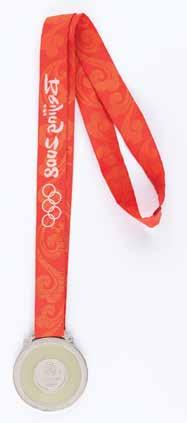
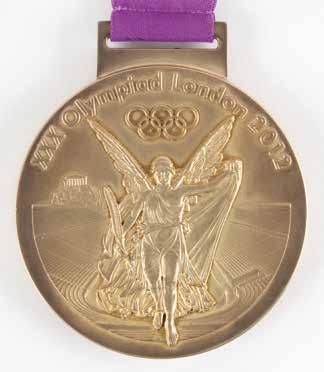
3110. London 2012 Summer Olympics Gold Winner’s Medal, Awarded to a Team USA Runner. Rare winner’s medal awarded to a track and field athlete for her victory in the women’s 4 * 400 metres relay race at the London 2012 Summer Olympics. Gilt silver, 85 mm, 430 gm, by David Watkins. The front of the medal features text across the top, “XXX Olympiad London 2012,” above the winged Nike over Panathinaikon Stadium with the Acropolis in the background; the reverse features the emblem of the London Games against an abstract linear background. The event, “Athletics, Women’s, 4 x 400m Relay,” is engraved along the bottom edge of the medal. Includes its purple ribbon with “London 2012” and the Olympic rings embroidered in white. Includes the original information card and black winner’s medal case, which is heavily scuffed and worn (as typical for this issue), and missing its form-fitting velvet liner. Additionally includes the associated Team USA “Gold Medalist” ring.
This sought-after winner’s medal was awarded to a member of Team USA’s women’s track team for her performance in the women’s 4 * 400 metres relay, which saw DeeDee Trotter, Allyson Felix, Francena McCorory, and Sanya

Richards-Ross win convincingly in the final, finishing at a world-leading 3:16.87pace. Keisha Baker and Diamond Dixon were also awarded gold medals for running in the qualifying heat, in which Team USA also took first. The accompanying “London 2012 Victory Medal” card explains the symbolism of the winner’s medal: “The medal’s circular form is a metaphor for the world. The front of the medal depicts the same imagery as at all the Summer Games - the Greek Goddess of Victory Nike stepping out of the Parthenon to arrive in the Host City. The reverse features five symbolic elements: A curved background represents a bowl similar to the design of an amphitheatre…an architectural expression and a metaphor for the modern city. It is deliberately jewel-like…The grid suggests both a pulling together and a sense of outreach - an image of radiating energy representing the efforts of the winning athletes…The River Thames in the background is a recognisable symbol of London. It also suggests a fluttering ribbon, adding a sense of celebration…The square is the final balancing motif of the design, opposing the overall circularity of the design, emphasising its focus on the centre and reinforcing the sense of ‘place’ as in a map inset.” Starting Bid $1,000
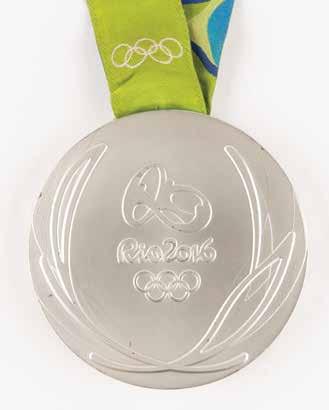
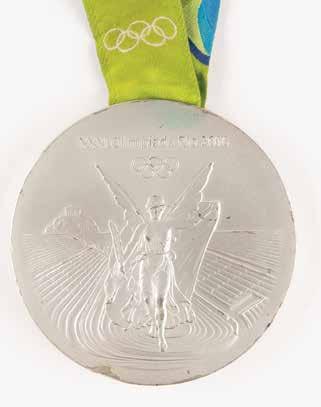
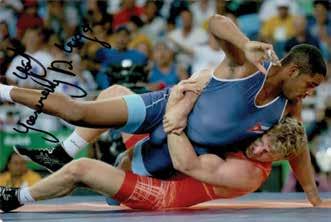
3111. Rio 2016 Summer Olympics Silver Winner’s Medal for Wrestling. Rare winner’s medal awarded to Cuban wrestler Yasmany Lugo for the Rio 2016 Summer Olympics. Silver, 85 mm, 495 gm, produced by the Brazilian Mint. The front features stylized laurel leaves—an ancient Greek symbol of victory—surrounding the Rio 2016 Olympic logo; the reverse features a traditional portrait of Nike, the Greek goddess of victory, over Panathenaic Stadium with the Acropolis in the background, inscribed above, “XXXI Olimpiada Rio 2016.” The bottom edge is engraved with the name of the event: “Wrestling / Men’s Greco-Roman 98kg.” Complete with its colorful original ribbon, and housed in an official wooden presentation case, engraved on the lid with the logo of the Rio Games. The medal exhibits a few minor scuffs and a substantial ding to the lower edge. Accompanied by a glossy 6 x 4 photo of Lugo wrestling, signed in black felt tip.
As the first Olympiad to take place in South America, the Rio 2016 Summer Olympics sought to emphasize sustainability as a key element of its platform. The medals awarded to winning athletes embodied this goal, and were constructed using sustainable and recycled materials: the gold was certified as being mercury-free; about 30% of the silver for the medals was derived from leftover mirrors, solder, and X-ray plates; and the ribbons have a composition of 50% recycled plastic bottles. The Brazilian Mint produced 2,488 medals in total—812 golds, 812 silvers, and 864 bronzes. Starting Bid $1,000
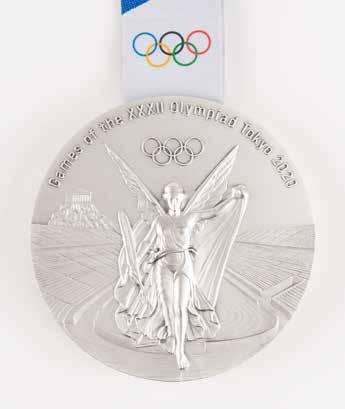
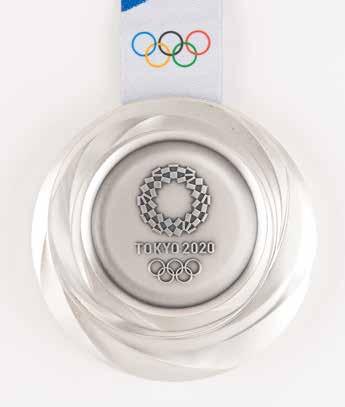
3112.Tokyo 2020 Summer Olympics Silver Winner’s Medal for Cycling with Case. Rare silver winner’s medal awarded to Ukrainian track cyclist Olena Starikova for the Tokyo 2020 Summer Olympics. Silver, 86 mm, 550 gm, by Junichi Kawanishi. The front of the medal features text across the top, “Games of the XXXII Olympiad Tokyo 2020,” above the Olympic rings and a winged Nike flying over Panathinaikon Stadium with the Acropolis in the background; the reverse features the emblem of the Tokyo Games set against a ‘polished stone’ background with surrounding curved lines that represent different patterns of light and the energy of the athletes and their supporters. The bottom edge of the medal is engraved with the event: “Cycling, Women’s Sprint.” Retains its original multicolored ribbon, which bears traditional Japanese design motifs found in ichimatsu moyo (harmonized chequered patterns) and kasane no irome (traditional kimono layering techniques) in a modern format. Complete with its original wooden presentation case with magnetic lid.
Olena Starikova represented Ukraine in track cycling at the 2020 Tokyo Olympics, competing in the women’s sprint and keirin events held at the Izu Velodrome, August 6–8th, 2021. Demonstrating impressive speed and determination, Starikova advanced to the later rounds in both competitions, earning this silver medal for her second-place finish in the women’s sprint finals. One of Europe’s most decorated women cyclists, Starikova placed on the podium in ten different European Championship events between 2018 and 2022. Winner’s medals from recent Olympics are difficult to obtain and ever-popular among collectors—this is the first silver Tokyo winner’s medal that we have offered at auction, and the finest of any type we have encountered. Starting Bid $500


3113. Athens 1896 Olympics
Bronze Participation Medal. Starting Bid $200

3114. Athens 1896 Olympics Gilt Bronze Participation Medal. Starting Bid $200
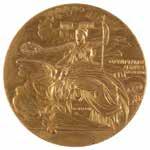
3116. Athens 1906
Intercalated Olympics Gilt Bronze Participation Medal. Starting Bid $200

3118. London 1908 Olympics Bronze Participation Medal. Starting Bid $200
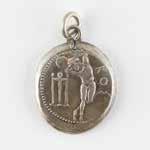
3115. Athens 1906 Olympics
Greek Organizing Committee Participation Medal. Starting Bid $200

3119. London 1908 Olympics
Silvered Bronze Participation Medal for Foil Display. Starting Bid $200

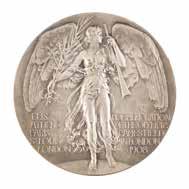
3117. London 1908 Olympics Judge’s Silvered Bronze Participation Medal. Participation medal issued for the London 1908 Olympics. Silvered bronze, 51 mm, 60 gm, by Bertram Mackennal. The front depicts a quadriga with charioteer and judge, preparing to present the palm of victory; the reverse bears the winged figure of Fame standing on a globe with raised text on either side, “Elis, Athens, Paris, St. Louis, London” and “In Commemoration of the Olympic Games Held in London, 1908.” Inscribed on the rim, “Vaughton.” Includes its original blue leather case, reading, “Olympic Games, Judge, London. 1908,” which features some wear to the exterior. Starting Bid $200
3120. London 1908 Olympics Gilt Bronze Participation Medal. Participation medal issued for the London 1908 Olympics. Gilt bronze, 51 mm, 60 gm, by Bertram Mackennal. The front depicts a quadriga with charioteer and judge, preparing to present the palm of victory; the reverse bears the winged figure of Fame standing on a globe with raised text on either side, “Elis, Athens, Paris, St. Louis, London” and “In Commemoration of the Olympic Games Held in London, 1908.” The edge is stamped “Bronze” and engraved by the mint, “Vaughton.” Includes its original presentation case, which is stamped “Olympic Games of London, 1908, Donor.” Presented to dignitaries, donors, and officials, this gilt bronze medal exists as one of the most coveted of all Olympic commemoration prizes. Starting Bid $200
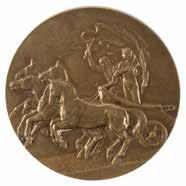


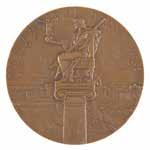
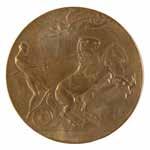




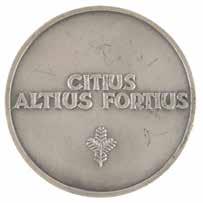
3126. Garmisch 1936 Winter Olympics Silvered Bronze Participation Medal. Very rare participation medal issued for the Garmisch 1936 Winter Olympics. Silvered bronze, 60 mm, 72 gm, by Kunststickerei M. Jorres. The front, inscribed, “Olympische Winterspiele, 1936, Garmisch-Partenkirchen,” features the Olympic rings over an alpine summit; the reverse bears a simple motto, “Citius Altius Fortius,” over a fir branch. Only 120 of these medals were struck, making it one of the rarest of all participation medals. Starting Bid $200


3129. London 1948 Summer Olympics Gilt Bronze Participation Medal. Participation medal issued for the London 1948 Summer Olympics. Bronze, 51 mm, 63 gm, by Bertram Mackennal/John Pinches. The front features a quadriga with a charioteer and judge, preparing to present an athlete with the palm of victory; the reverse bears a city view of London above raised lettering and Olympic rings, “XIV Olympiad, London, 1948.” The medal bears some fading and tarnishing to the gilt. The gilt bronze participation medal of the XIV Olympiad remains quite rare, with this example only the second we have offered. Starting Bid $200


3130. Helsinki 1952 Summer Olympics Bronze Participation Medal. Participation medal issued for the Helsinki 1952 Summer Olympics. Bronze, 54 mm, 77 gm, by Kauko Rasanen. The front depicts the heads of two laureate athletes superimposed over the Olympic Stadium, with raised text, “Helsinki 1952”; the reverse bears male and female athletes holding torches over the Olympic rings, with raised text above, “XV Olympia.” Includes its rare original paper box with Olympic rings to cover, with an old piece of tape adhered to the top and bottom. Starting Bid $250


3131. Stockholm 1956 Summer Olympics Bronze Participation Medal. Participation medal issued for the equestrian events held in Stockholm for the Melbourne 1956 Summer Olympics. Bronze, 38 mm x 50 mm, 39 gm, by John Sjosvard. Inspired by a sculpture in the Parthenon, the front, inscribed around the upper border, “XVI Olympiadens Ryttartavlingar Stockholm 1956,” features an ancient Greek horse and rider on a platform, with the Olympic rings below; the reverse face is plain. Completed by the rare addition of the original paper box. Due to Australian agricultural quarantine regulations, the equestrian events of the XVI Olympiad were held five months earlier in Stockholm, Sweden, making the 1956 Summer Games the second Olympics not to be held entirely in one country; the 1920 Olympics, which Antwerp, Belgium co-hosted with Amsterdam and Ostend, were the first. Given the low number of participants in the equestrian events—158 in total—Stockholm medals remain rare and highly sought-after. Starting Bid $200


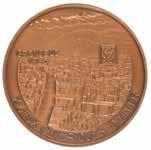
Bid $200

3135.
Participation Medals. Starting Bid $200

3136. Sapporo 1972 Winter Olympics Bronze Participation Medal - From the Collection of IOC Member James Worrall. Starting Bid $200

3137. Munich 1972 Summer Olympics (2) Steel Participation Medals. Starting Bid $200

3138. Montreal 1976 Summer Olympics Copper Participation Medal. Starting Bid $200

3139. Lake Placid 1980 Winter Olympics Nickel-Silver Participation Medal. Starting Bid $200


3140. Moscow 1980 Summer Olympics Tombac Participation Medal. Starting Bid $150

3142. Sarajevo 1984 Winter Olympics Bronze Participation Medal. Starting Bid $200
Sought-after large version of the Sarajevo medal
3141. Sarajevo 1984 Winter Olympics Large Bronze Participation Medal. Massive participation medal issued for the Sarajevo 1984 Winter Olympics. Large bronze, 95 mm x 106 mm, 491 gm, designed by Nebojsa Mitric. The front bears stylized raised text within a circle, “Sarajevo 84,” above the Olympic rings and logo; the reverse is plain with the monogram of the designer. Includes the original leather presentation case with its orange paper sleeve. These large and medium-sized participation medals were bestowed to dignitaries and officials, with the former example existing as perhaps the largest and most formidable of all Olympic participation medals. Starting Bid $300

3143. Los Angeles 1984 Summer Olympics Bronze Participation Medal. Starting Bid $200
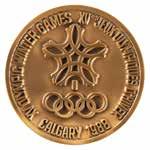
3144. Calgary 1988 Winter Olympics Bronze Participation Medal - From the Collection of IOC Member James Worrall. Starting Bid $150
3145. Calgary 1988 Winter Olympics Collection of (24) Participation and Commemorative Medals. Impressive collection of 24 medals issued for the Calgary 1988 Winter Olympics, including:
Ten (10) bronze participation medals, each 64 mm, 133 gm, by Cornelius Martens, with the front depicting the Calgary Games emblem and raised French and English text, and the reverse bearing a panoramic view of Calgary, the Saddledome Stadium, and the Canadian Rocky Mountains, with the Olympic motto below; the reverse of each bear either an affixed protective foam swatch or remnants of the said swatch. Each medal includes its brown velvet case, and all but one are accompanied by their original Jostens paper slipcase.
Four (4) limited edition gold-tone ‘host city’ commemorative medals, numbered 8, 65, 68, and 85 of 100 issued, each 64 mm, 133 gm, with the Calgary emblem to the front with raised text: “Calgary ‘88, Host City, Ville Hote,” and the reverse bearing the Calgary coat of arms in relief; the reverse of each bear either an affixed protective foam swatch or remnants of the said swatch. Each includes its original brown velvet case, with Jostens slipcase and edition booklet.
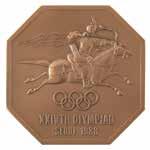
3146. Seoul 1988 Summer Olympics Press Participation Medal. Starting Bid $100


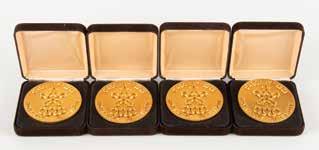
Ten (10) bronze volunteer participation medals, each 63 mm, 136 gm, with the front featuring the Calgary Games emblem and raised French and English text, and the reverse bearing a mountainside with Olympic buildings and raised text: “Team ‘88—Equipe 88, Calgary.” Each includes its original gray presentation case with Jostens slipcase, and all but three contain their original booklet. In overall fine condition, with some wear and stains to the cases and slipcases. Starting Bid $300

3147. Albertville 1992 Winter Olympics Chrome-Plated Steel Participation Medal. Starting Bid $200

3148. Barcelona 1992 Summer Olympics Copper Participation Medal. Starting Bid $100

3149. Barcelona 1992 Summer Olympics Copper Participation Medal. Starting Bid $100
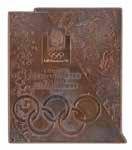
3150. Lillehammer 1994 Winter Olympics Copper Participation Medal. Starting Bid $200
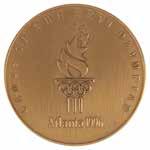
3151. Atlanta 1996 Summer Olympics Bronze Participation Medal. Starting Bid $100

3152.
1998 Winter Olympics Bronze Participation Medal. Starting Bid $200

3153. Sydney 2000 Summer Olympics Silver-colored Participation Medal. Starting Bid $200

3154. Athens 2004 Summer Olympics Bronze Participation Medal. Starting Bid $200

3155.
2016 Summer Olympics Participation Medal. Starting Bid $200

3156. Beijing 2008
Summer Paralympics Bronze
Participation Medal. Starting Bid $100
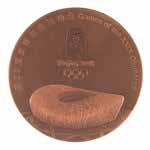
3157. Beijing 2008
Summer Olympics Bronze
Participation Medal. Starting Bid $100
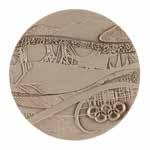
3158. Vancouver 2010
Winter Olympics Volunteer
Participation Medal. Starting Bid $100
3159. Summer and Winter Participation Medals (3) - St. Moritz 1928, Melbourne 1956, and Rome 1960. Attractive set of three participation medals from the historic summer and winter Olympic Games held in St. Moritz (1928), Melbourne (1956), and Rome (1960).
St. Moritz 1928 Winter Olympics
Participation medal issued for the St. Moritz 1928 Winter Olympics. Bronze, 37 mm, 22 gm, by Milo Martin. The front depicts the goddess Victory holding a laurel branch in a horse-drawn sled, with mountains rising in the background and the Olympic rings below; the reverse bears raised text, “II Jeux Olympiques D’hiver St. Moritz 1928,” over a laurel branch. A fine example of this small Olympic medal.
Melbourne 1956 Summer Olympics
Participation medal issued for the Melbourne 1956 Summer Olympics. Bronze, 63 mm, 105 gm, by Andor Meszaros. The front depicts the Olympic motto encircled by pairs of athletes following the march of a flag-bearer; the reverse bears the Melbourne coat of arms and Olympic rings, with raised text along the top, “Olympic Games Melbourne, 1956.”
Rome 1960 Summer Olympics
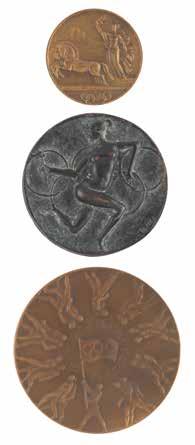

Participation medal issued for the Rome 1960 Summer Olympics. Bronze, 55 mm, 79 gm, by Emilio Greco. The front features a nude female torchbearer superimposed over Olympic rings; the reverse bears a convocation of eagles soaring high above the Olympic stadium, with raised Italian text encircling the edge. Some sections bear slight hints of verdigris patina, a common condition for these medals. Starting Bid $200
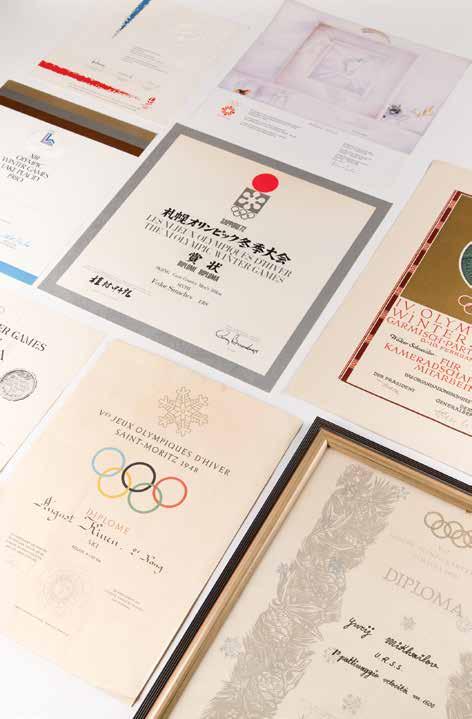
3160. Winter Olympics
Collection of (10) Diplomas. Rare collection of 10 official Winter Olympic diplomas covering over 60 years of international competition. The diplomas, which contain medalist examples and range in size from 10.75 x 10.75 to 14.75 x 18.75, are issued for the following Olympic Games: St. Moritz 1928 (15.75 x 13.5), Lake Placid 1932 (unissued; 14 x 10), Garmisch 1936 (13.75 x 19.25), St. Moritz 1948 (11.75 x 16.5), Cortina 1956 (1st place; 14.75 x 18.75), Innsbruck 1964 (1st place; 13.5 x 18.5), Sapporo 1972 (15.5 x 15.25, with plastic holder), Lake Placid 1980 (unissued; 11.75 x 13.75), Sarajevo 1984 (13.75 x 13.5), and Albertville 1992 (unissued; 10.75 x 10.75). Several diplomas are signed by notable Olympic committee officials (Cortina is signed by IOC President Avery Brundage), and the Cortina diploma is framed to a slightly larger size. In overall fine condition, with instances of toning, edgewear, and folds. Starting Bid $1,000

More images available online.
3161. Summer Olympics Collection of (19) Diplomas. Impressive collection of 19 official Olympic diplomas covering 16 different Summer Olympiads and over 100 years of international competition. The diplomas, which contain five medalist examples and range in size from 11.5 x 16.75 to 21.5 x 29.25, are issued for the following Olympic Games: Paris 1900 (12.75 x 19.75), St. Louis 1904 (22.25 x 18.25), London 1908 (unissued; 17 x 11.75), Stockholm 1912 (11 x 18.25), Paris 1924 (19.5 x 25.25), Amsterdam 1928 (21.5 x 29.25), Los Angeles 1932 (19.25 x 14), London 1948 (2nd place; 22.75 x 17.5), Helsinki 1952 (14 x 19.75), Melbourne 1956 (2nd place; 23 x 17.5), Rome 1960 (3rd place; 24.5 x 18.25), Tokyo 1964 (15.25 x 15.25), Mexico City 1968 (4 posters, each 12.25 x 12.25), Moscow 1980 (11.5 x 16.75), Seoul 1988 (3rd place; 12.5 x 14.25, with folder), and Beijing 2008 (2nd place; 18 x 13.75). Several diplomas are signed by notable Olympic committee officials, and a few examples (Stockholm, 1924 Paris, Rome, and Los Angeles) are matted, mounted, or framed to slightly larger sizes. In overall fine condition, with instances of toning, edgewear, and folds, with tape-repaired tears to the 1908 poster. In overall fine condition. Accompanied several items related to Swedish wrestler Tor Nilsson, the recipient of the 1948 diploma, who won a silver medal in London in the heavyweight division. Of particular interest is Nilsson’s “Identity Card” for the XIV Olympiad, which bears an affixed photo of Nilsson and recognizes him as a “Competitor” in “Wrestling.” Starting Bid $1,000

3162. Zappas 1889 Olympics Winner’s Diploma. Scarce partly-printed DS in Greek, one page, 18˝ x 18˝, June 1889. An official winner’s diploma from the Zappas Olympics of 1889, which was issued to influential Greek painter Georgios Roilos, “exhibitor of the Athenian municipality in Attika of Voiotia for…[his] distinguished portrait.” Signed in the lower right corner by the president of the Olympian committee, “A. Valetas.” Mounted to an overall size of 24.75˝ x 21.5˝. In very good to fine condition, with scattered creasing and edgewear, including tears and paper loss, most significantly to the full extent of the left edge, which has been artistically restored with ink; the document’s bold lettering and beautiful engravings continue to shine brightly in spite of its 134-year-old age. Diplomas from the Zappas Olympics, important precursors to our modern games, are exceedingly rare and virtually unobtainable, this being the first and only example that we have ever offered.
Georgios Roilos (1867–1928) was one of the most important and influential Greek painters of the late 19th-early 20th century. He belonged to the so-called ‘Munich School’ and his major works include historical topics, portraits, and scenes of everyday life.
Sponsored by Evangelis Zappas (1800–1865), a Greek patriot, businessman, and philanthropist, the Zappas Olympics was a series of athletic events held in Athens designed to reintroduce a modern version of the ancient games into the nation of Greece. The first was held in 1859, while the other three—1870, 1875, and 1888—were held posthumously in Zappas’ honor. Although not an international event, the Zappas Olympics were significant to the Games of today, as the modern arrangement of gold, silver, and bronze medals serving as awards for first, second, and third prizes was established according to the original plan of the Zappas Olympics. Starting Bid $1,000
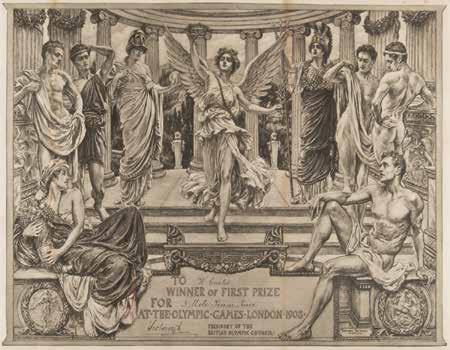
3163. London 1908 Olympics Gold Winner’s Medal Diploma. Rare winner’s medal diploma from the London 1908 Olympics, issued to English long-distance runner William Coales (1886–1960) who won a gold medal as a member of Great Britain men’s 3-mile team. The beautifully illustrated diploma, 24.5 x 19.5, features a drawing by English artist Bernard Partridge of the Goddess Nike descending a platform and holding a laurel wreath crown as an octet of athletes and Roman figures observe. The lower portion bears printed and handwritten text: “To W. Coates, Winner of First Prize, For 3 Mile Team Race, At the Olympic Games London 1908.” Signed below by William Grenfell, 1st Baron Desborough, as president of the British Olympic Council. Framed to a slightly larger size and in very good to fine condition, with a couple of creases, areas of toning, and dampstaining to the lower left corner. Starting Bid $200
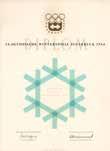
3164. Innsbruck 1964 Winter Olympics
Participation Diploma. Starting Bid $100
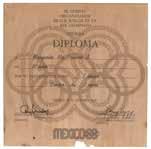
3165. Mexico City 1968 Summer Olympics
Participation Diploma. Starting Bid $100

3166. Albertville 1992 Winter Olympics
Participation Diploma. Starting Bid $200

3167. Paris 1900 Exposition
Universelle Jury Lapel Badge. Starting Bid $200

3168. Paris 1900 Exposition Universelle Opening Ceremony Badge. Starting Bid $100
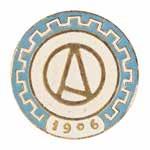
3170. Athens 1906
Intercalated Olympics Official Participant’s Badge. Starting Bid $200

3171. London 1908 Olympics ‘Reception Committee’ Badge. Starting Bid $200
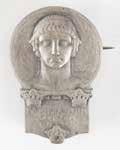
3173. Stockholm 1912 Olympics
Competitor’s Badge. Starting Bid $200

3174. Paris 1924 Summer Olympics
Competitor’s Participation Badge. Starting Bid $200
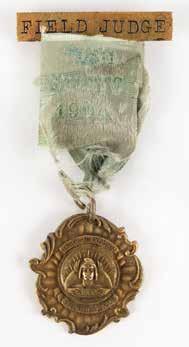
3169. St. Louis 1904 Olympics Judge’s Badge for Irish Sports. Extremely rare field judge’s badge issued for the St. Louis 1904 Olympics. Bronze-tone, 32 mm x 32, 18 gm, by Dieges & Clust, New York. The badge features a central male figure holding a banner that reads “Pax” [Peace] with embossed upper and lower text: “Universal Exposition” and “St. Louis U.S.A., 1904.” Issued only to officials to be worn as a badge, the medal is suspended from a green ribbon marked, “Irish Sports 1904,” with the upper pin bar reading: “Field Judge.” The ribbon bears noticeable wear and fraying. A considerably rare official’s badge from the first Olympic Games to be held outside of Europe. Starting Bid $200
3172. Stockholm 1912 Olympics 50th Anniversary Participant’s Badge (5) Set. Scarce set of five gilt participant badge pins commemorating the 50th anniversary of the Stockholm 1912 Olympics, each 4 gm and 25 mm x 64 mm (with spike), and featuring a Greek athlete’s head at the top, and “Olympiska Spelen, Stockholm 1912 - 1962” in raised letters at the bottom. Housed in their original packaging by C. C. Sporrong & Co. In fine condition. Starting Bid $250


3175. Amsterdam 1928 Summer Olympics Official’s Badge. Starting Bid $200
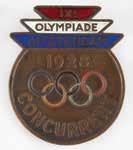
3176. Amsterdam Olympics 1928 Competitor’s Badge. Starting Bid $200

3177. Berlin 1936 Summer Olympics Hungarian NOC Team Badge. Starting Bid $200

3179. London 1948 Summer Olympics Equestrian Official’s Badge and Program. Starting Bid $200

3178. Tokyo 1940 Summer Olympics Badge. Rare official’s badge for the canceled Tokyo 1940 Summer Olympics. Set on a mauve rosette, the silvered and enameled pin, 15 gm, 38 mm in diameter, shows the Olympic rings against Mount Fuji, and reads, “XII Olympiad, Tokyo 1940.”
The start of the second Sino-Japanese on July 7, 1937, raised the question among both the Japanese and the international community whether Tokyo remained a logical Olympic host city. As the Japanese war effort continued to mount, the Games were forfeited to Helsinki, Finland, the runner-up in the original bidding process, but were soon suspended indefinitely following the outbreak of World War II. A solemn remembrance of Tokyo’s lost 1940 Olympics. Starting Bid $300
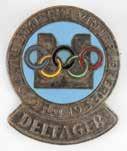
3180. Oslo 1952 Winter Olympics Participant’s Badge. Starting Bid $200

3181. Helsinki 1952 Summer Olympics Badge. Starting Bid $100

3182. Helsinki 1952 Summer Olympics ‘First Class Cross of Merit’ Badge. Starting Bid $200

3183. Cortina 1956 Winter Olympics Radio-TV Badge. Starting Bid $200
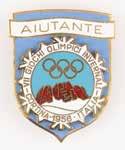
3184. Cortina 1956 Winter Olympics Trainer Badge. Starting Bid $200
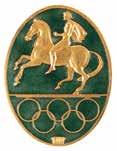
3185. Stockholm 1956 Summer Olympics Official’s Badge. Starting Bid $200
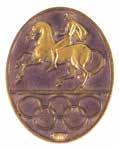
3186. Stockholm 1956 Summer Olympics Team Assistant’s Badge. Starting Bid $200
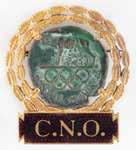
3187. Rome 1960 Summer Olympics National Olympic Committee Badge. National Olympic Committee badge issued for the Rome 1960 Summer Olympics, 45 mm x 51 mm, 29 gm, featuring a gold-tone bezel with inset medallion depicting Romulus and Remus with the Capitoline Wolf, and Olympic rings below. The deep purple enameled panel at the bottom features gold lettering, “C.N.O.” Reverse of panel stamped, “Stab. Artistici Fiorentini, Firenze.” There were just 274 of these badges issued at the 1960 Summer Olympics, a remarkably low number given that over 12,000 badges of 66 different types were distributed. Starting Bid $200

3188. Rome 1960 Summer Olympics Press Badge. Starting Bid $150
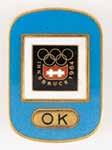
3191. Innsbruck 1964 Winter Olympics Organizing Committee Badge. Starting Bid $200

3192. Tokyo 1964 Summer Olympics
Team Official’s Badge. Starting Bid $200

3189. Rome 1960 Summer Olympics Athlete’s Badge for Hungarian Fencer Tamás Mendelényi. Starting Bid $200
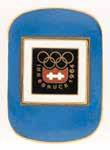
3190. Innsbruck 1964 Winter Olympics Guest of Honor Badge. Starting Bid $200
3193. Tokyo 1964 Summer Olympics (10) Badges. Soughtafter collection of 10 badges issued for the Tokyo 1964 Summer Olympics. All badges are silvered bronze, 37 mm x 60 mm, 44 gm, with ribbons suspended below. The front of each badge bears the Tokyo Games emblem above Olympic rings and the text, “Tokyo 1964”; the reverse features a pin and raised Japanese text. Each badge also bears a colored enamel bar with participant identification. Legends include: “XVIII Olympiad” (red); “Press” (red); “Photo & Film” (red); “Radio & TV” (red); “O.O.C. Official” (blue); “Committee” (blue); “Team Official” (light blue); “Competitor” (light blue); “N.O.C.” (orange); and “I.S.F. Technical Official” (yellow). Each badge includes its original white presentation box, which bear various degrees of toning, wear, and scuffing. A significant grouping of hard-to-find badges from the first Olympics to be held in Asia. Starting Bid $1,000



3195. Tokyo 1964 Summer Olympics IOC President BadgeAttributed to Avery Brundage. Official ‘I.O.C. President’ badge for the Tokyo 1964 Summer Olympics, which is attributed to the collection of Avery Brundage, the longtime president of the International Olympic Committee. Gold-plated, 51 mm x 63 mm, 64 gm, with the two off-white ribbons measuring 83 mm in length. Bordered by bands in the colors of the Olympic rings, the badge features the rising sun of the Japanese national flag above a green bar with Olympic rings and a white enamel bar identified as “I.O.C. President.” Accompanied by its original white leather presentation box, which bears scattered light foxing.
Brundage (1887–1975) was an American sports administrator who served as the fifth president of the International Olympic Committee from 1952 to 1972. The only American and only non-European to attain that position, Brundage is remembered as a zealous advocate of amateurism and for his involvement with the 1936 and 1972 Summer Olympics, both held in Germany. Starting Bid $2,500
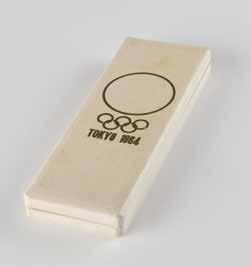

3196. Tokyo 1964 Summer Olympics Official Special Delegate’s Badge. Rare official special delegate’s badge issued for the 1964 Tokyo Summer Olympics. Gold-plated, 50 mm x 67 mm, 62 gm, with the sand-colored double ribbon measuring 80 mm in length. The badge features the rising sun of the Japanese national flag bordered by bands in the colors of the Olympic rings, with a red enamel bar below reading: “XVIII Olympiad.” Accompanied by its original white leather presentation box. Starting Bid $200

Tokyo
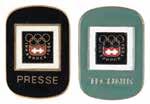
3197. Innsbruck 1964 Winter Olympics Press and Technician Badges. Starting Bid $200

Bid $175


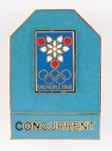
3202. Sapporo 1972 Winter Olympics (10) Badges. Sought-after collection of 10 badges issued for the Sapporo 1972 Winter Olympics. All badges are silvered bronze, 38 mm x 60 mm, 44 gm, with each ribbon measuring 76 mm in length. The front of each badge bears the Sapporo Games logo above Olympic rings and the text, “Sapporo ‘72,” and the reverse features a pin and raised Japanese text. Each badge also bears a colored enamel bar of either green, red, purple, blue, or brown, with seven badges featuring a white-and-yellow ribbon, two with a green ribbon, and one with a brown ribbon. By enamel color, the badges are as follows: (green) “Team Official” and “Competition”; (red) “Press,” “Radio & TV,” and “Photo”; (purple) “Guest”; (blue) “Official,” “S.O.O.C. Official,” and “Committee”; and (brown) “N.O.C.” Each medal includes its original white leather presentation box, which bears various degrees of toning and scuffing; hinge to one not closing completely. A gorgeous collection of decidedly scarce Olympic badges. Starting Bid $1,000




3206. Sapporo 1972 Winter Olympics Guest Badge. Starting Bid $175
3207. Sapporo 1972 Winter Olympics Advisor Badge. Starting Bid $200
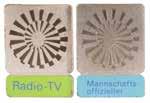
3208. Munich 1972 Summer Olympics (2) Badges. Starting Bid $200

3209. Innsbruck 1976 Winter Olympics Group of (3) Badges. Starting Bid $200

3210. Innsbruck 1976 Winter Olympics Organizing Committee Badge. Starting Bid $200
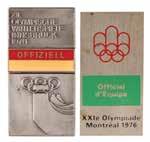
3211. Montreal and Innsbruck 1976 Summer and Winter Olympics (2) Official’s Badges. Starting Bid $200

3212. All India Football Federation (AIFF) 1956 Badges (2). Starting Bid $100

3213. Summer Olympics (1984-2012) ID Lot of (8). Starting Bid $200

3214. Melbourne 1956 Summer Olympics ID Booklet. Starting Bid $100
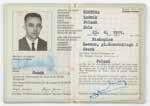
3215. Tokyo 1964 Summer Olympics ID Booklet. Starting Bid $100
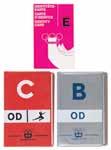
3216. Innsbruck 1964/1976 Winter Olympics Unissued ID Booklets Lot of (3). Starting Bid $100

3217. Mexico City 1968 Summer Olympics ID Card. Starting Bid $75
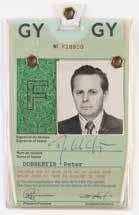

3218. Montreal 1976 Summer Olympics Team Official ID Card. Starting Bid $75
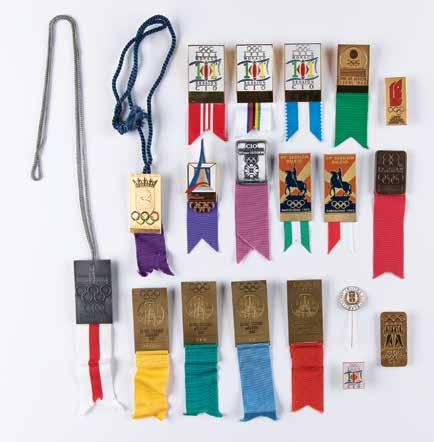
3220. IOC Session Badge Collection (18), dated from 1957 to 1994. Collection of 18 International Olympic Committee (IOC) badges from 12 different sessions dated from 1957 to 1994, an impressive range that covers nearly four decades of Olympic competition. The sessions, and associated badges, are available online at www.RRAuction.com. Starting Bid $200
3219. Berlin 1936 Summer Olympics IOC Chain of Office. Exceedingly rare ‘Gold Chain of Office for the Members of the International Olympic Committee’ issued for the Berlin 1936 Summer Olympics, worn by the members of the IOC during the Games. The chain is gilt cast bronze, approximately 80 cm long, designed by Walter E. Lemcke based on ancient Greek vases and coins. It features six medallions along the chain—depicting a javelin thrower, two wrestlers, a torch runner, a youth with jumping weights, a weapon runner, and a discus thrower—with colorful enameled Olympic rings at the bottom; engraved on the reverse of the rings is, “Skulp. W. E. Lemcke.” Suspended from the rings is a larger medallion of the head of Zeus, 53 mm x 65 mm, engraved on the reverse, “XI. Olympiade Berlin 1936.” The Olympic rings exhibit a few bends and some loss of the enamel.
These chains were originally created by the 1936 Berlin Organizing Committee for members of the IOC to wear during the 1936 Berlin Games, and they were intended to be worn at each Olympiad thereafter. This is the only time such a special and exclusive award was created for the IOC. Of course, the 1940 Games were canceled due to World War II, and the chains were never worn again. It is believed that there were 60 of these produced, but far fewer are known to exist today. They were supposed to be returned to the IOC and stored in a bank vault in Berlin, but some IOC members kept them. Following World War II, only nine of the chains were said to have been recovered from the Berlin vault, and a comprehensive 2012 article, ‘An endless Olympic Chain’ by Karl Lennartz, enumerated only six known chains today. Exquisitely crafted and rarely seen in even the most complete Olympic collections, this is a remarkable piece of history. Starting Bid $1,000

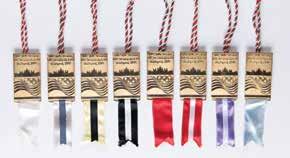
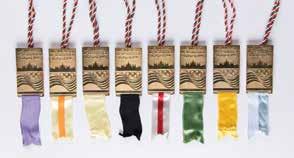
3221. Budapest 1995 Complete Set of (16) IOC Badges – 104th Session. Rare complete set of 16 badges for the 104th International Olympic Committee (IOC) Session in Budapest, Hungary on June 16, 1995, in which Salt Lake City was selected as the host for the 2002 Winter Olympics. Badges measure 1.25 x 2.5 and feature an outline of the Budapest skyline and Olympic rings, with each badge bearing a red, green, and white tassel and a uniquely colored ribbon. An uncommon and attractive assemblage of badges representing the most recent Olympic Games to be held in the United States. Starting Bid $200
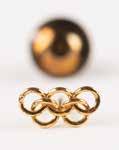
3222. International Olympic Committee (IOC) Senior Membership Pin. Starting Bid $100
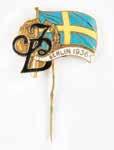
3223. Berlin 1936 Summer Olympics Large Swedish Newspaper “Idrottsblatt” Pin. Starting Bid $100

3224. Berlin 1936 Summer Olympics Czechoslovak NOC Pin. Starting Bid $100

3225. St. Moritz 1948 Winter Olympics Swiss National Olympic Committee Pin and Patch. Starting Bid $300

3226. Stockholm 1956 Summer Olympics Visitor’s Pin. Starting Bid $100
3227. Tokyo 1964 Summer Olympics (5) Olympic Color Pins. Starting Bid $100
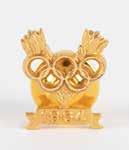
3228. Tokyo 1964 Summer Olympics Gold Medal Winner’s Pin. Starting Bid $200

3229. Hungarian NOC Collection of (29) Summer and Winter Olympics Pins. Starting Bid $200
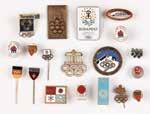
3230. Olympic Pin Collection. Starting Bid $200


3231. Great Britain Olympic Team (24) Badge and Pin Collection. Appealing collection of 24 Olympic pins and badges issued to members of the Great Britain national team, including 13 shield badges, each approximately 25 mm x 38 mm, all featuring the Union Jack flag in colored enamel between “Great Britain” and the Olympic rings, with each badge identifying their Summer Games: Rome 1960, Tokyo 1964, Mexico City 1968, Munich 1972, Montreal 1976, Moscow 1980, Los Angeles 1984, Seoul 1988, Barcelona 1992, Atlanta 1996, Sydney 2000, Athens 2004, and Beijing 2008. Other pins and badges include: two gold-tone badges issued to the Great Britain women’s team at Tokyo 1968 and Montreal 1976; two London 2012 candidate pins; three “Team England,” “Team GM,” and “Gt. Britain” pins; an equestrian pin (missing spike); a hockey pin; a “USA / The British Olympic Association” pin; and a shield badge commemorating the 1956 “Visit of the British Olympic Team” to Hammersmith. In overall fine condition. Starting Bid $200
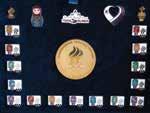
Starting Bid $200
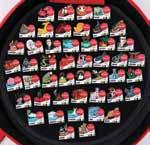
3233. Tokyo 2020 Summer Olympics ‘Team Coca-Cola’ Torch Relay Pin Set. Starting Bid $200

3234. Beijing 2022 Winter Olympics Pin Set - Issued by the National Olympic Committee of Ukraine. Starting Bid $200
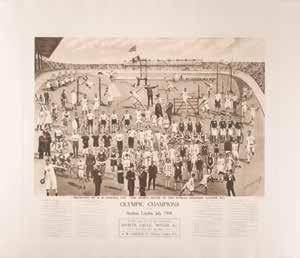
3235. London 1908 Olympics Lithograph - ‘Olympic Champions at the Stadium, London, July, 1908’ (Gamage). Rare original 34 x 29.25 lithograph entitled “Olympic Champions at the Stadium, London, July, 1908,” published by A. W. Gamage of London, portraying a total of 70 athletes and notable figures from the Games of the IV Olympiad, with each individual numbered in a list to the bottom section, which also notes their respective nations, events, and medal-winning results. Professionally restored to fine, rolled condition, with some light edgewear and toning. Starting Bid $200
3236. Paris 1924 Summer Olympics Original Poster by Jean Droit. Exceedingly rare original color 31.25 x 46.5 lithographic poster designed by French artist Jean Droit for the Paris 1924 Summer Olympics. Printed by Machard & Cie, the poster depicts a group of male athletes with their arms raised in salute against a background of France’s national flag, with laurel branches and a shield featuring the Parisian coat-of-arms pictured below. Upper and lower portions of the poster bear large text: “Paris–1924” and “Jeux Olympiques.” Professionally linen-backed, rolled, and expertly restored to fine condition, with some minor surface loss from mounting along the top edge.
Of the 150 projects submitted for the official poster of the VIII Olympiad, the French Olympic Committee selected posters from two finalists—Jean Droit and Orsi. Ten thousand copies of each were printed, and of these 20,000 posters, a total of 12,000 were sent abroad and distributed with the help of the National Olympic Committees, Sporting Federations, and Olympic Associations. Those that remained in France were distributed by sporting establishments, theater companies, and travel agencies. A rare and impressive Olympic poster fast approaching its 100th anniversary, which will be celebrated by the triumphant return of the Summer Games to Paris in 2024.
Jean Droit was a painter and illustrator (1884–1961) who designed several posters for France during the First World War and several travel posters in the years between the wars. Starting Bid $300
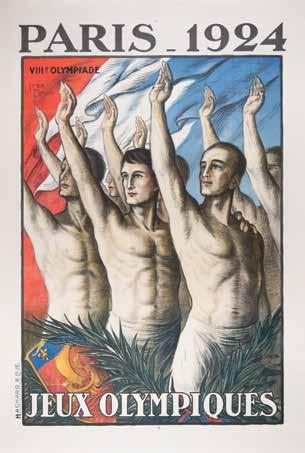
3237. Lake Placid 1932 Winter Olympics Poster (German). Official German color poster for the Lake Placid 1932 Winter Olympics, 24 x 39.5, featuring a large central design by Witold Gordon of the silhouette of a ski jumper soaring over a map of the United States, with a dot marking the location of Lake Placid. The poster features large bold text, “III. Olympische Winterspiele [Olympic Winter Games]” and “Lake Placid, USA, February 4-13, 1934,” and features the Olympic rings to the lower section. Affixed to a same-size cardstock mount and in very good to fine condition, with light edgewear, and a tear extending from the top edge to the skier’s extended arm. One of the rarest Winter Olympic posters. Starting Bid $200
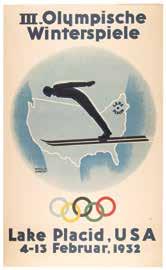
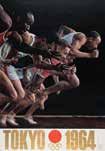



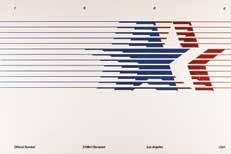
3243. Athens 1896 Olympics Ode Booklet. Rare staple-bound bilingual booklet entitled “Olympic Ode,” published in Athens in 1896 by A. Boreades, 16 pages, 6 x 8.5, offering the text (in Greek and French) of the Pindaric Ode recited for the first Modern Olympic Games. Certified inside with the publisher’s ink signature. In good to very good condition, with tape repair to spine/covers, surface loss to title page, and minor edge chipping. Starting Bid $200


3244. Athens 1906 Intercalated Olympics Official Guidebook. Starting Bid $200
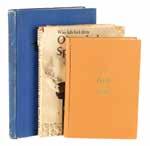
3245. German 1930s Olympic Books (3). Starting Bid $100

3246. Athens 1906 Intercalated Olympics Official Report. Scarce official report: 2nd International Olympic Games, 1906, by Pan. S. Savvidis. First edition. Athens: 1907. Hardcover bound in brown-and-gold cloth, 12.5 x 9, 164 pages. The well-illustrated volume features text almost entirely in Greek, along with a few French captions. Includes coverage of the various athletic competitions and related festivities. In very good condition, with rubbing to gilt on boards, edgewear and worn corners, and a few small edge tears to pages inside. Published with covers in a variety of styles (also including black, blue, and red linen), this is a scarce color variant. Starting Bid $200




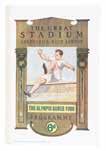
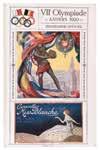

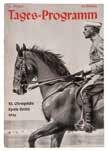
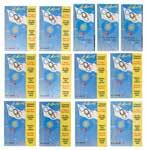

3256. Innsbruck 1964 Winter Olympics
Daily Programs. Starting Bid $350
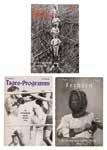
3258.
Starting Bid $100

3259.
Starting Bid

3257. Berlin 1936 Summer Olympics Daily Program and Ticket Stub (August 8th). Starting Bid $150

3260. Munich 1972 Summer Olympics Athletics Programs
Starting Bid $200


3262.
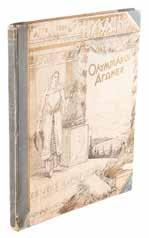
3263. Athens 1896 Olympics Official Report. Very rare complete Greek-and-French language official report for the Athens 1896 Olympics, the first international Olympic Games held in modern history. Published by C. Meissner & N. Kardadouris and edited by Charles Beck of Athens and H. Le Soudier of Paris. Presented in its original lithograph cardboard covers with quarter cloth binding, the report, 10.5 x 13, contains two volumes: the first (101 pages) is entitled “Part One, The Olympic Games In Antiquity,” and the second (109 pages) is entitled “Part Two, The 1896 Olympic Games.” The volumes offer numerous pictures and illustrations to support the ample information on both the ancient Olympic Games and the historic 1896 Olympiad. Includes a custom cloth-bound clamshell case. In good to very good condition, with light dampstaining scattered wear to covers and spine, including scuffs and scratches, a partial separation to opening page of volume one, and a few sections becoming loose from binding. Starting Bid $300
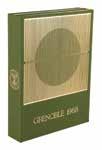





Tickets Lot of (18).
Starting Bid $200

3270. Summer Olympics (1928-2016) Opening Ceremony Ticket Lot of (21). Fantastic lot of Opening Ceremony tickets and ticket stubs for every Summer Olympics held from 1928 to 2016, featuring both spectator tickets and media passes. The comprehensive collection offers one from each of the following Olympic Games: 1928 Amsterdam, 1932 Los Angeles, 1936 Berlin, 1948 London, 1952 Helsinki, 1956 Melbourne, 1960 Rome, 1964 Tokyo, 1968 Mexico City, 1972 Munich, 1976 Montreal, 1980 Moscow, 1984 Los Angeles, 1988 Seoul, 1992 Barcelona, 1996 Atlanta, 2000 Sydney, 2004 Athens, 2008 Beijing, 2012 London, and 2016 Rio de Janeiro. In overall very fine condition with some near mint. Starting Bid $200
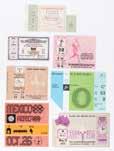
3271. Summer Olympics (1932-2020) Event Tickets Lot of (21). Starting Bid $200
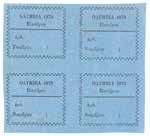
3272. Athens 1870 Zappas Olympics Tickets (4). Starting Bid $200
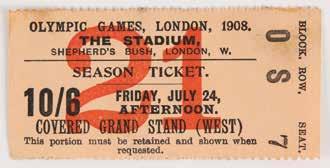
3273. London 1908 Olympics Ticket. Original season ticket for the London 1908 Olympic Games, 3 x 1.5, printed for entrance into “The Stadium” in Shepherd’s Bush on July 24th (afternoon), issued for Block O, Row S, and Seat 7 in the “Covered Grand Stand (West).” In fine condition. The owner of this ticket would have attended the finish of the men’s marathon, which marked the fourth appearance of the event, making it one of 12 athletics events to have been held at every Summer Olympics. American Johnny Hayes won the event after Italy’s Dorando Pietri was disqualified for having received assistance before the finish line. Starting Bid $200

3274. Lake Placid 1932 Winter Olympics Celluloid Season Ticket (Grandstand).
Starting Bid $150

3275. Lake Placid 1932 Winter Olympics Celluloid Season Ticket (Bleacher). Starting Bid $100

3276. Los Angeles 1932 Summer Olympics Village Pass. Starting Bid $100
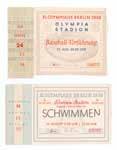
3277. Berlin 1936 Summer Olympics (2) Ticket StubsBaseball and Swimming.
Starting Bid $200
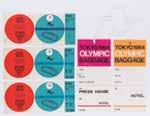
3278. Tokyo 1964 Summer Olympics (3) Football Tickets and Baggage Tags (2). Ticket and tag group lot from the Tokyo 1964 Summer Olympics, which includes three 7.25 x 3 admission tickets to football (soccer) matches held at the Mitsuzawa Football Field on October 11th and 15th, and two 3.25 x 7.5 “Tokyo 1964 Olympic Baggage” tags, both unissued, with the purple tag for “Press House or Hotel” and the orange tag for “Hotel.” Includes an original “Tokyo 1964” ticket envelope, which bears some pencil notation in Japanese. In overall fine condition. Starting Bid $250

3279. Beijing 2022 Winter Olympics Opening and Closing Ceremony Tickets. Appealing pair of original 8 x 3.5 full tickets to the opening and closing ceremonies of the Beijing 2022 Winter Olympics, offering admittance to the National Stadium for the Opening Ceremony on February 4th, and the Closing Ceremony on February 20th. In overall fine condition. Starting Bid $300


3280. Harold Abrahams
Signature and Rare
‘Spalding’s Athletic Library’ Book on Sprinting. Starting Bid $200

3281. Robert Garrett, 1896
Athens Olympic Champion: Book from His Personal Library. Starting Bid $150

3282. London 1908 Olympics Multi-Signed (30+) Opening Banquet Menu. Starting Bid $200
3283. Greg Louganis Signed Winner’s Medal Diplomas from the Los Angeles 1984 Summer Olympics. Marvelous set of three official diplomas issued to legendary American diver Greg Louganis at the Los Angeles 1984 Summer Olympics, including his two gold medal winner’s diplomas and his athlete’s participation diploma, each 14 x 15, each signed in blue felt tip by Louganis. The winner’s diplomas are both calligraphically inscribed to “Gregory Louganis, United States of America,” for “First Place” in the respective events of “Swimming – Platform Diving” and “Diving – Men’s Springboard,” with the lower portion of both bearing autopen signatures of four Olympic committee members (Juan Antonio Samaranch, Paul Ziffren, Peter V. Ueberroth, and Harry L. Usher) and the upper portion bearing the iconic ‘Stars in Motion’ logo for the Games of the XXIII Olympiad. The participation diploma is also inscribed to “Gregory Louganis” and bears printed Olympic committee signatures below. Includes an original diploma envelope from the 1984 LA Olympics. In overall fine condition.
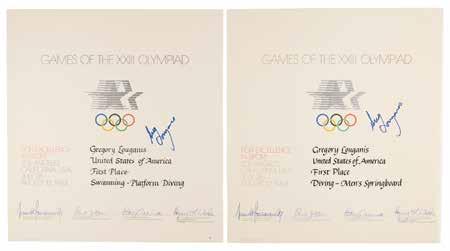
At only 16 years of age, Greg Louganis earned his first Olympic medal when he placed second in the men’s 10-meter platform diving competition at the Montreal 1976 Summer Olympics. The boycott of the 1980 Moscow Games forced Louganis to wait eight years before his next Olympic opportunity in 1984. In his hugely anticipated return, Louganis amazed Los Angeles spectators by taking gold in both diving events: 3-meter springboard and 10-meter platform. Four years later, he won two more golds at the 1988 Seoul Summer Olympics, thus becoming the only man and the second diver in Olympic history to sweep the diving events in consecutive Olympic Games. Starting Bid $200

3284. Paavo Nurmi Signature. Starting Bid $150

3286. Charley Paddock Signed BookThe Fastest Human. Starting Bid $200
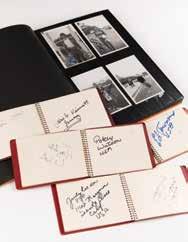
3288. Tokyo 1964 Summer Olympics Autograph Books and Photo Album with (125+) Signatures. Starting Bid $200


3287. Dorando Pietri Twice-Signed Photograph. Starting Bid $200

3290. Louis Zamperini Signed Photograph. Starting Bid $100

3291. International Olympic Committee (IOC) Badge of Office. Starting Bid $200
3292. Olympic Order in Silver - From the Collection of an AP Journalist. Rare Olympic Order in Silver from the collection of Associated Press journalist Larry Siddons, a longtime reporter on the Olympic Games, housed in its hinged blue case by GDE Bertoni, featuring the silver Olympic rings on the lid. The silver collar-style award measures approximately 8.75˝ x 12.75˝, and features the Olympic rings at center, flanked by linked olive leaves leading into a silver chain. Complete with its presentation card: “Larry Siddons: In recognition of your outstanding merit in the cause of world sport and your faithfulness to the Olympic ideal as illustrated by Pierre de Coubertin, Renovator of the Olympic Games, I award you the Olympic Order.”
Established in 1975, the Olympic Order is the highest award of the IOC and is issued to recognize particularly distinguished contributions to the Olympic Movement. It was originally issued in three grades—gold, silver, and bronze—with gold reserved primarily for heads of state or exceptional circumstances. Starting Bid $500

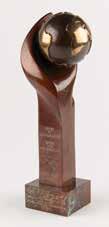
3293. International Olympic Committee (IOC) ‘Sport and Universality’ Marble-andBronze Sculpture Award by Rosa Serra. Appealing marble-and-bronze ‘Sport and Universality’ sculpture award from the International Olympic Committee (IOC), measuring 9˝ in height and weighing four pounds, consisting of a marble arm extending upward with a bronze Earth balanced in its palm. The arm front is gilt engraved with the Olympic rings and text in French and English, “Sport et Universalite, Sports and Universality, CIO - IOC, 2000,” and the base front is calligraphically engraved, “To Prof. Ivan Starkov on the occasion of his 60th Anniversary.” The reverse of the base is etched by noted Spanish sculptor Rosa Serra. In fine condition. Starting Bid $200
‘Olympic Door of the Year 2000’— a limited edition NOC sculpture by Nag Arnoldi
3294. International Olympic Committee (IOC) Bronze ‘Olympic Door of the Year 2000’ Sculpture by Nag Arnoldi. Scarce bronze sculpture from the International Olympic Committee (IOC) entitled ‘Olympic Door of the Year 2000’ and designed by Swiss artist Nag Arnoldi. The sculpture, which stands 12.75˝ in height and six pounds in weight, serves as a miniature replication of Arnoldi’s original bronze sculpture of the same name, which stood over 19´ tall and weighed nearly 8,000 pounds. The sculpture consists of a large door, partially open, comprising the Olympic rings on its two columns and the lintel bearing the year “2000.” Above are four moving characters holding aloft the Olympic rings, and the reverse of the base is engraved, “NAG.” In fine condition. Arnoldi produced 250 of these small-scale replicas, which were ordered by the IOC and presented to various government representatives, via the 200 National Olympic Committees, as a symbol of human understanding, peace, prosperity, and well-being. Starting Bid $200
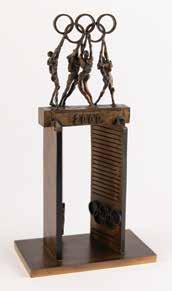
3295. Tokyo 2020 Summer Olympics Lighting Ceremony Bowl. Greek lekythos ceramic bowl used in the official flame lighting ceremony of the Tokyo 2020 Summer Olympics, which was held at the birthplace of the Olympic Games in Olympia, Greece on March 12, 2020. The glazed black bowl measures 6.75˝ in diameter and 4.25˝ in height, and features hand-painted designs and figures, including a torch runner. The bowl contains its interior ceramic ring.Read more online at www.RRAuction.com.Starting Bid $200

3296. Melbourne 1956-Tokyo 1964 Summer Olympics Official Olympic Flame Lighting Ceremony High Priestess Dress. Extremely rare ‘high priestess’ dress used for the Olympic flame lighting ceremonies in Olympia, Greece, from 1956 to 1964. The handsomely crafted white fabric dress features a simple, classical design, with a wide neck, gathered bodice, open arms, and braided cord belt. In very good to fine condition, with some scattered staining and wear from use. Accompanied by a postcard showing the Olympic flame lighting ceremony at Olympia, Greece, on November 22, 1956, with priestesses shown wearing this style of dress.

The duty of the High Priestess in Olympia is to perform the lighting of the Olympic flame by utilizing the power of Apollo, the Greek god of sun and light. Among the pillars, in the ruins of the temple of Hera, beneath Kronos Hill, a reflective bowl is used to catch the rays of the sun and to spark a flame, igniting the Olympic torch held by the High Priestess. From this torch, the flame is passed, or kissed, to the lekythos bowl, which is carried into the ancient stadium and used as a conduit to light the first torch of the Olympic relay. Starting Bid $300

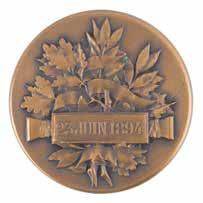

3297. Paris 1894 First Olympic Congress Bronze Commemorative Medal. Rare commemorative medal issued for the inaugural Olympic Congress, which was held in Paris in June 1894. Bronze, 51 mm, 56 gm, by Huguenin. The front features a cluster of leaves with wrapped scroll and a central tablet with raised date, “23 Juin 1894,” and the reverse bears an additional branch and leaves with embossed text in French (translated): “The International Congress of Paris Proclaims the Restoration of the Olympic Games.” Stamped “Bronze” on the edge. Includes the original maroon paper box.
On June 16, 1894, the first Olympic Congress was declared open in the auditorium of the Sorbonne University in Paris. A week later on June 23rd, Pierre de Coubertin’s Olympic dream became a reality when a resolution to revive the Olympic Games was adopted unanimously at the group’s final meeting. The Congress led to the establishment of the International Olympic Committee, of which Coubertin became general secretary and later president, and to the naming of the first modern Olympic Games, which would take place in Athens two years later. A rare opportunity to own the first medal of the modern Olympic tradition. Starting Bid $300

3298. Pierre de Coubertin Silvered Bronze Plaque. Starting Bid $200

3299. Athens 1896 Olympics Souvenir Bronze Medal. Starting Bid $100

3300. London 1908 Olympics: A Reply to Certain Criticisms Book. Starting Bid $200
“Olympic Regatta, 1908, Henley-on-Thames”—rare silver oar presented to rowers at the 1908 London Games

3301. London 1908 Olympics Commemorative Silver Oar. Scarce commemorative silver oar that was presented as a participation gift to all competitors in the rowing events at the London 1908 Summer Olympics. Produced by Elkington & Co., the miniature oar, 14 gm, 152 mm in length, is engraved on the blade area, “Olympic Regatta, 1908, Henley-onThames,” and the reverse of the shaft is marked “60.” Includes its original red leather presentation case. In fine condition, with light wear to the original case.
This rare participant souvenir is referenced in both the official report of the London 1908 Summer Games and in an article in the August 1908 issue of Baily’s Magazine of Sports & Pastimes, which reads, in part: ‘Over thirty crews and scullers from England, Canada, Belgium, Holland, Italy, Hungary, and Germany will be striving for supremacy at Henley simultaneously with this month’s issue of Baily. An extended course of about 1 ½ miles has been provided by the A.R.A. whose arrangements generally are on the most elaborate scale. All the visiting crews will be lavishly entertained while a souvenir in the form of a silver oar is to be presented to every competitor. Inscribed on the blade will be ‘Olympic Regatta 1908 Henley on Thames.’ The meeting is quite the most important ever held in the history of the sport.’ Starting Bid $200
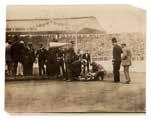
3302. Dorando Pietri: London 1908 Olympics Original Marathon Photograph. Starting Bid $200

3304. Swimming Pioneers Oversized Photograph (1909). Starting Bid $200
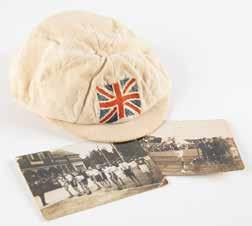

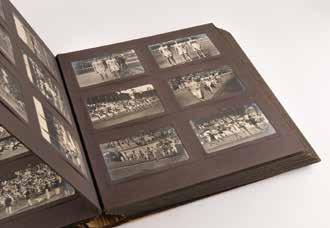
3303. London 1908 Olympics Great Britain Team Cap. Starting Bid $200
3305. Stockholm 1912 Summer Olympics Complete 24-Volume Magazine Set. Starting Bid $200
3306. Stockholm 1912 Olympics Collection of (240) Postcard Photographs, Highlighted by Jim Thorpe and the Debut of Women’s Aquatics. Starting Bid $200
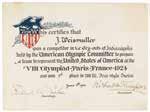
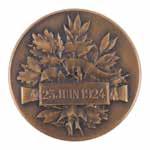
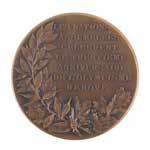




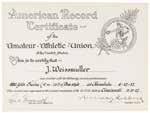

3314. Amsterdam 1928 Summer Olympics

3315. Los Angeles 1932 Summer Olympics Souvenir Ashtray. Starting Bid $100
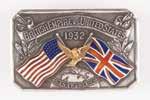
3316. United States and Great Britain 1932 Track and Field Championships Belt Buckle. Starting Bid $200

3317. Lake Placid 1932-1933 Winter Olympics Bobsled Waiver

3318. Los Angeles 1932 Summer Olympics Car Badge. Starting Bid $150

3319. Franklin D. Roosevelt Signed Lake Placid 1932 Winter Olympics Mailing Envelope. Starting Bid $200

3320.

3321.
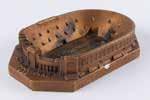
3322.

3323. Berlin 1936 Summer Olympics Book: The Experience of the XI Olympiad in Words, Pictures and Sound. Starting Bid $200

3326. Berlin 1936 Summer Olympics (2) Commemorative Medallions. Starting Bid $200
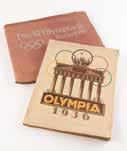
3324. Germany 1936 Summer and Winter Olympics (2) ‘Complete’ Photo Card Books.
Starting Bid $200

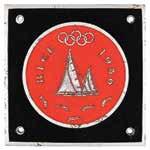
3325. Berlin 1936 Summer Olympics Kiel Olympic Yachting Car Badge. Starting Bid $100
3327. Jesse Owens (5) Original Press Photographs. Starting Bid $200
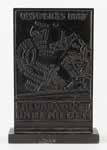
3329. Berlin 1936 Summer Olympics ‘Olympic Village’ Plaque - Presented to the Great Britain National Team. Starting Bid $200
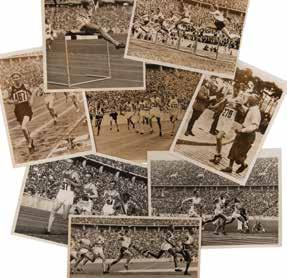
3328. Berlin 1936 Summer Olympics (8) Track Event Photographs. Starting Bid $200

3330. Berlin 1936 Summer Olympics Souvenirs (3) Pennant, Patch, and Pin. Starting Bid $200
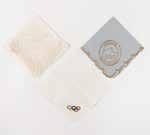
3331. German 1936 Summer and Winter Olympics (3) Fabric Souvenirs from Berlin and Garmisch. Starting Bid $200
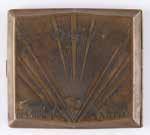
3332. Tokyo 1940 Summer Olympics Cigarette Case. Starting Bid $250

3333. Norwegian 1940 Olympic Committee Fundraising Plaquette. Starting Bid $100

3334. London 1948 Summer Olympics Press Identity Card. Starting Bid $200
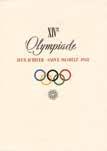
3335. St. Moritz 1948 Winter Olympics Organizing Committee Invitation to Participate. Starting Bid $200

3336. London 1948 Summer Olympics Souvenir Match Case. Starting Bid $100

3337. London 1948 Summer Olympics (2) Souvenir Scarves. Starting Bid $200

3338. Spanish Olympic Committee 1950 Merit Award. Starting Bid $100

3339.
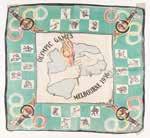

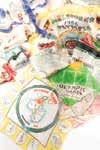
3341.
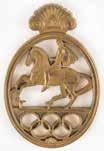

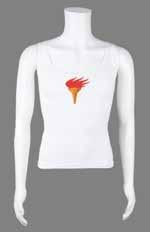
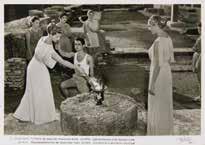

3346.
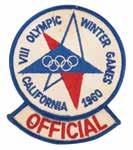
3347.



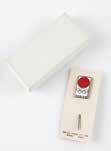

3351.



3354.

3355. Munich 1972 Summer Olympics ‘Pierre de Coubertin’ Porcelain Medallion by Meissen. Starting Bid
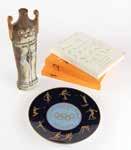


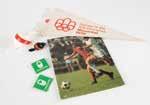

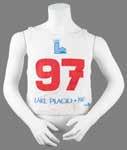
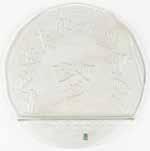
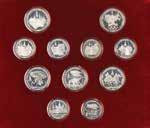

3364. Moscow 1980 Summer Olympics Torch Relay Uniform. Starting Bid $200
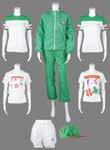
3365. Los Angeles 1984 Summer Olympics
Official Staff Uniform. Starting Bid $100


3366. Seoul 1988 Summer Olympics Flag.
Starting Bid $100
3367. Seoul 1988 Summer Olympics Hwando Sword. Beautiful commemorative Hwando sword from the Seoul 1988 Summer Olympics. Exclusively issued by the Seoul Olympic Organizing Committee, the elegantly made single-edged short sword measures 27˝ in length from the blade tip to the bottom of the pommel, and both the sword handle and accompanying sheath, 21.25˝ in length, are constructed of wood with inset mother-of-pearl designs; the upper handle bears a single SamTaegeuk symbol and the bottom of the blade is stamped “0644.” The sword’s pommel and guard, as well as the attractive sheath, bear bronze-tone metal accents and red tasseled cords. Includes its acrylic presentation stand. In fine condition, with the second Sam-Taegeuk symbol missing from the opposite side of the handle. Starting Bid $200
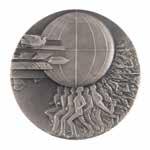
3368. International Olympic Committee (IOC) Medal. Starting Bid $100

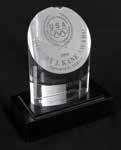

3370. International Olympic Committee (IOC) 1994 Centenary Medal and Badge. Starting Bid $250


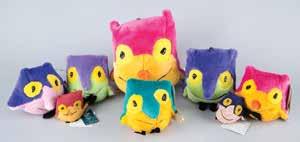

3375. Olympic Watches (2) by Seiko and Swatch. Starting Bid $200

Summer
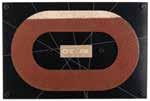

3379. Tokyo 2020 Summer Olympics Souvenir Baseball, Softball, and Tennis Ball. Starting Bid $200

3381.

3378. London 2012 Summer Olympics Section of Olympic Stadium Track. Starting Bid $100

3380. Tokyo 2020 Summer Olympics Asics Running Sneakers - GelQuantum 360 TYO. Starting Bid $200

3382.

3383. London 2012 Summer Olympics Winner’s Medal Presentation Tray. Starting Bid $200
ANYONE EITHER REGISTERING TO BID OR PLACING A BID (“BIDDER”) ACCEPTS THESE CONDITIONS OF SALE AND ENTERS INTO A LEGALLY, BINDING, ENFORCEABLE AGREEMENT WITH R&R AUCTION COMPANY OF MASSACHUSETTS, LLC (“RR AUCTION”) TOGETHER WITH BIDDER, THE “PARTIES”).
This Agreement contains important provisions that control rights and liabilities, and specifically has provisions governing how disputes are handled as well as LIMITATIONS OF LIABILITY that can be imposed upon RR Auction, WAIVER OF JURY and ARBITRATION PROVISIONS. This acknowledgement is a material term of these Conditions of Sale and of the consideration under which RR Auction agrees to these terms. PLEASE READ CAREFULLY.
The following terms and conditions (“Conditions of Sale”) constitute the sole terms and conditions under which RR Auction will offer for sale and sell the property on its website, and/or described in the catalog of items for auction (the “Catalog”). These Conditions of Sale constitute a binding agreement between the Parties with respect to the auction in which Bidder participates (the “Auction”). By bidding at the Auction, whether in person, through an agent or representative, by telephone, facsimile, online, absentee bid, or by any other form of bid or by any other means, Bidder acknowledges the thorough reading and understanding of all of these Conditions of Sale, all descriptions of items in the Catalog, and all matters incorporated herein by reference, and agrees to be fully bound thereby.
Section 1
The Parties1.1 RR Auction and Auction
This Auction is presented by RR Auction, a d/b/a/ of R&R Auction Company of Massachusetts, LLC, as identified with the applicable licensing information on the title page of the Catalog or on the www.RRauction. com Internet site. The Auction is conducted under these Conditions of Sale. Announcements and corrections from the podium at live auctions and those made through the Conditions of Sale appearing on the Internet at RRauction.com supersede those in the printed Catalog.
1.2 Bidder
Bidder shall mean the original Bidder on the property offered for sale by RR Auction and not any subsequent owner or other person who may acquire or have acquired an interest therein. If Bidder is an agent, the agency must be disclosed in writing to RR Auction prior to the time of sale, otherwise the benefits of the warranty shall be limited to the agent and not transferable to the undisclosed principal.
The rights granted to Bidder under these Conditions of Sale are personal and may not be assigned or transferred to any other person or entity, whether by operation of law or otherwise without the express written assent of RR Auction. Bidder may not transfer, assign, or otherwise convey these Conditions of Sale or any of the rights herein, and such purported transfer, assignment, or conveyance shall be null and void. No third party may rely on any benefit or right conferred on any Bidder by these Conditions of Sale, and no third party is intended as a beneficiary of these Conditions of Sale.
Bids will not be accepted from minor persons under eighteen (18) years of age without a parent or legal guardian’s written consent containing an acknowledgment of the Conditions of Sale herein and indicating their agreement to be bound thereby on behalf of the Bidder.
All Bidders must meet RR Auction’s qualifications to bid. Any Bidder who is not a client in good standing of RR Auction may be disqualified at RR Auction’s sole option and will not be awarded lots. Such determination may be made by RR Auction in its sole and unlimited discretion, at any time prior to, during, or even after the close of the Auction. RR Auction reserves the right to exclude any person from the Auction.
If an entity places a bid, then the person executing the bid on behalf of the entity agrees to personally guarantee payment for any successful bid and
agrees to be bound by these Conditions of Sale in addition to company for whom the Bidder is acting
By accepting the Conditions of Sale, Bidder personally and unconditionally guarantees payment.
2.1 In order to place bids, Bidders who have not established an account with RR Auction must either furnish satisfactory credit information (including two collectibles-related business references) or supply additional information if requested, well in advance of the Auction. Bidders who are not members of RRAuction.com should pre-register before the close of the Auction to allow adequate time to contact references. Privileges will be granted at the sole discretion of RR Auction. Additionally, Bidders who have not previously established credit or who wish to bid in excess of their established credit history may be required to provide a cash deposit prior to RR Auction’s acceptance of a bid. Check writing privileges and immediate delivery of merchandise may also be determined by pre-approval of credit based on a combination of criteria: RRAuction.com history, related industry references, bank verification, a credit bureau report and/or a personal guarantee for a corporate or partnership entity in advance of the Auction venue.
2.2 Bidder providing any false or misleading information provided in connection with the registration shall be a material breach of the Conditions of Sale and in addition to any other remedies at law shall excuse RR Auction from performance under these Conditions of Sale, including the right to any refund.
2.2 Bidding privileges may be revoked without notice, for any reason, at the sole discretion of RR Auction .
Section 3
3.1 The Bidder acknowledges and agrees that a 25% buyer’s premium will be added to the hammer price on all individual lots sold in timed and live Auctions. . For payment other than by cash, delivery will not be made unless and until full payment has been received by RR Auction, i.e., check or wired funds have fully cleared. Unless otherwise agreed in writing, signed by RR Auction, payment in full is due within thirteen (13) calendar days of the Auction or within twelve (12) calendar days of the invoice date, whichever is earlier. Bidder’s failure to pay any payment in full when due required shall constitute a material breach, and in addition to other damages available under contract or law, at RR Auction’s election, RR Auction may cancel the sale and require full premium still be due along with interest at 1.5% per month from the date of breach, or at the maximum legally allowable rate.
Section 4
Bidding
4.1 Each Bidder’s determination of its bid should be based upon its own examination of the item(s) and independent investigation, rather than the any reliance as to what is represented in the Catalog, online or elsewhere. Bidder affirms that it regards any statements made by RR Auction concerning the item as solely opinion and that Bidder is making its own inspection and independent evaluation of the goods, and is not relying upon any description or statements by RR Auction (including as to quality, authenticity, provenance, ownership, liens existing, on goods legality, or value) in making its determination to bid on or purchase an item. In any purchase or sale, the value of the item(s) is determined by the price. THE BIDDER HEREBY ASSUMES ALL RISKS CONCERNING ANY AND ALL PURCHASES TO THE FULLEST EXTENT UNDER APPLICABLE LAW.
4.2 RR AUCTION IS NOT RESPONSIBLE FOR ERRORS IN BIDDING. A Bidder should make certain to bid on the correct lot and that the bid is the maximum (plus the Buyer’s Premium) that the Bidder is willing and able to pay. Since other Bidders (by mail, facsimile, online, and in person) will be present, and since a re-offering could damage the momentum of the sale, once the hammer has fallen and RR Auction has announced the winning Bidder, such Bidder is unconditionally bound to pay for the lot,
even if the Bidder has made a mistake.
4.3 All prospective Bidders who examine lots in person prior to the sale shall personally assume all responsibility for any damage they cause in so doing. RR Auction shall have sole discretion in determining the value of the damage caused, which shall be promptly paid by the prospective Bidder.
4.4 Title to any lot remains with Consignor, any secured party of the Consignor, or assignee of Consignor, as the case may be, until the lot is paid for in full by Bidder and Bidder has fully satisfied any outstanding financial obligations to RR Auction (including as it concerns aby other lots). RR Auction reserves the right to require payment in full before delivering any lot to the successful Bidder.
4.5 It is the Bidder’s responsibility and obligation to have the lots fully insured while in their possession. Bidder assumes any and all risk of loss upon the earlier of shipment to Bidder or in Bidder’s possession.
4.6 Bidder grants to RR Auction or its assigns the right to offset any sums due, or found to be due by RR Auction, and to make such offset from any past, subsequent or future consignment, or items acquired by Bidder in possession or control of RR Auction or from any sums due to Bidder by RR Auction. Bidder further grants RR Auction a lien consisting of a senior security interest (or purchase money security interest to the extent applicable) in such sums or items to the fullest extent applicable, authorizes RR Auction to file documents concerning the interest, and Bidder agrees to execute any further documents as may be reasonably necessary to grant RR Auction such security interest. Bidder agrees that RR Auction and its assigns shall be a secured party with respect to items bought by Bidder and in the possession of RR Auction, to the extent of the maximum indebtedness, plus all accrued fees and expenses, until the indebtedness is paid.
4.7 By bidding in this sale, Bidder personally and unconditionally guarantees payment. The authorized representative of any corporate Bidder who is present at the sale shall provide RR Auction or its agent, prior to the commencement of the bidding (or at the time of registration), with a statement signed by a principal, director or officer that they he or she personally and unconditionally guarantees any payment due RR Auction.
4.8 RR Auction may at its sole and absolute discretion, make loans or advances to Consignors and/or prospective Bidders.
Section 5
Bidding Options
5.1 Non-Internet bids (including but not limited to in-person, facsimile, phone and mail bids) are treated similarly to floor bids in that they must be on-increment. Any in-person, facsimile, phone, or mail bids that do not conform to a full increment will be rounded up or down to the nearest full increment and this revised amount will be considered Bidder’s high bid.
5.2 When identical bids are submitted, preference is given to the first received. To ensure the greatest accuracy, written bids should be entered on the standard printed bid sheet and be received at RR Auction’s place of business at least twenty-four (24) hours before the Auction start. RR Auction is not responsible for executing mail bids or facsimile bids received on or after the day the first lot is sold, nor Internet bids submitted after the published closing time; nor is RR Auction responsible for proper execution of bids submitted by telephone, mail, facsimile, e-mail, Internet, or in person once the Auction begins.
5.3 In all Auctions, bids on an item must raise the current high bid by at least 10%, or as specified on a per-Auction basis. Bids will be accepted in whole dollar amounts only. No “buy” or “unlimited” bids will be accepted. In a live sale, bids on an item can change at the discretion of RR Auction.
5.4 RR Auction reserves the right to accept or decline any bid. Bids must be for an entire lot and each lot constitutes a separate sale. All bids are per lot unless otherwise announced. Live auction lots will be sold in their numbered sequence unless RR Auction directs otherwise. It is unlawful and illegal for Bidders to collude, pool, or agree with another Bidder to pay less than the fair value for lot(s). For live auctions, RR Auction will have final discretion in the event that any dispute should arise between Bidders. RR Auction will determine the successful Bidder, cancel the sale,
or re-offer and resell the lot or lots in dispute. RR Auction will have final discretion to resolve any disputes arising after the sale and in online auctions. If any dispute arises, RR Auction’s sale record is conclusive.
6.1 Subject to fulfillment of all of the Conditions of Sale set forth herein, upon the sooner of (1) the passing of title to the offered lot pursuant to these Conditions of Sale, or (2) possession of the offered lot by the Bidder, Bidder thereupon (a) assumes full risk and responsibility (including without limitation, liability for or damage to frames or glass covering prints, paintings, photos, or other works), and (b) will immediately pay the full purchase price or such part as RR Auction may require. In addition to other remedies available to RR Auction by law, RR Auction reserves the right to impose from the date of sale a late charge of 1.5% per month of the total purchase price if payment is not made in accordance with the conditions set forth herein. All property must be removed from RR Auction’s premises by the Bidder at his/her expense not later than sixty (60) business days following its sale and, if it is not so removed, RR Auction may send the purchased property to a public warehouse for the account, at the risk and expense of the Bidder.
6.2 Payment is due upon closing of the Auction session, or upon presentment of an invoice. RR Auction reserves the right to void an invoice if payment in full is not received within thirteen (13) calendar days of the Auction or within twelve (12) calendar days of the invoice date. In cases of nonpayment, RR Auction’s election to void a sale does not relieve the Bidder from their obligation to pay RR Auction its fees (seller’s and Buyer’s Premium) on the lot and any other damages pertaining to the lot.
6.3 All sales for total invoices greater than $1,000 are strictly for cash in United States dollars (including U.S. currency, bank wire, cashier checks, eChecks, and bank money orders), and are subject to all reporting requirements.
6.4 All deliveries are subject to good funds; funds being received in RR Auction’s account before delivery of the Purchases; and all payments are subject to a clearing period. RR Auction reserves the right to determine if a check constitutes “good funds”: checks drawn on a U.S. bank are subject to a ten (10) calendar day hold, and ten (10) business days when drawn on an international bank. Clients with pre-arranged credit status may receive immediate credit for payments via e-Check, personal or corporate checks.
6.5 In the event that a Bidder’s payment is dishonored upon presentment(s), Bidder shall pay the maximum statutory processing fee set by applicable state law. If Bidder attempts to pay via check and the financial institution denies the transfer from Bidder’s bank account, or the payment cannot be completed using the selected funding source, Bidder agrees to complete payment.
6.7 If RR Auction refers any unpaid invoice to an attorney for collection, the Bidder agrees to pay and shall be liable for RR Auction’s attorney’s fees, court costs, and other collection costs incurred by RR Auction in addition to the invoice amount and interest the greater of 1.5% per month or at the maximum legally allowable rate from date of invoice to collection. If RR Auction assigns collection to its house counsel, such attorney’s time expended on the matter shall be compensated at a rate comparable to the hourly rate of independent attorneys.
6.8 RR Auction shall have a lien against the merchandise purchased by the Bidder (as well as to the extent it is a consignor any other monies owed or due to Bidder) to secure payment of the Auction invoice. RR Auction is further granted a lien and the right to retain possession of any other property of the Bidder then held by RR Auction or its affiliates to secure payment of any Auction invoice or any other amounts due RR Auction or affiliates from the Bidder. With respect to these lien rights, RR Auction shall have all the rights of a secured creditor, including but not limited to the right of sale. In addition, with respect to payment of the Auction invoice(s), the Bidder waives any and all rights of offset he might otherwise have against RR Auction and the consignor of the merchandise included on the invoice (the Consignor”). If a Bidder owes RR Auction or its affiliates on any account, RR Auction and its affiliates shall have the right to offset such unpaid account by any credit balance due Bidder, and it may secure by possessory lien any unpaid amount by any of the Bid-
der’s property in their possession.
6.9 All checks, cashiers checks, bank checks, or money orders are payable to R&R Auction Company of Massachusetts, LLC. RR Auction clients with an invoice totaling $1,000 or under will have the option to pay by VISA, Mastercard, Discover or Paypal. All Paypal payments must be sent to FinanceDepartment@rrauction.com. Authorize.net, a third-party service provider contracted by RR Auction for processing on-line payments, charges a nonrefundable service fee of 3%, which will be added to your final invoice should you pay by credit/debit card.
Section 7 Sales Tax
RR Auction is a remote seller and we are now required to collect Sales/ Use Tax from our bidders. The states that we have nexus in we will be required to collect and remit sales tax on your behalf. Each state has different requirements to meet nexus. When RR Auction has achieved a certain monetary and/or invoice threshold in each state we will apply sales tax to your total invoice. The states that are affected are: ARIZONA, ARKANSAS, CALIFORNIA, COLORADO, CONNECTICUT, FLORIDA, GEORGIA, ILLINOIS, INDIANA, IOWA, KANSAS, KENTUCKY, MAINE, MARYLAND, MASSACHUSETTS, MICHIGAN, MINNESOTA, NEBRASKA, NEVADA, NEW JERSEY, NEW YORK, NORTH CAROLINA, OHIO, OKLAHOMA, PENNSYLVANIA,RHODE ISLAND, TENNESSEE, TEXAS, UTAH, VIRGINIA, WASHINGTON, WISCONSIN
If we have not achieved nexus in a particular state it is still your responsibility to pay sales tax on your purchases.
The sales tax rate is determined by the State, Country, and City where purchases are shipped to. If you decide to pick up your purchases at our New Hampshire location you will not be required to pay sales tax. The State of New Hampshire does not have a general sales and use tax. All purchases picked up at our Massachusetts location will be taxed at the current rate of 6.25%.
If you have a resale number please email Sue@RRAuction.com or fax to (603) 732-4288 a copy of your state resale certificate and you will be exempt from paying sales tax.
Section 8
Delivery; Shipping; and Handling Charges
Bidder is liable for shipping and handling and providing accurate information as to shipping or delivery locations and arranging for such. RR Auction is unable to combine purchases from other auctions or affiliates into one package for shipping purposes. Lots won will be shipped in a commercially reasonable time after payment in good funds for the merchandise and the shipping fees is received or credit extended, except when third-party shipment occurs. Bidder agrees that service and handling charges related to shipping items which are not pre-paid may be charged to a credit card on file with RR Auction.
Successful international Bidders shall provide written shipping instructions, including specified Customs declarations, to RR Auction for any lots to be delivered outside of the United States. NOTE: Declaration value shall be the item’(s) hammer price and RR Auction shall use the correct harmonized code for the lot. Domestic Bidders on lots designated for third-party shipment must designate the common carrier, accept risk of loss, and prepay shipping costs.
Section 9
Title
Title shall not pass to the successful Bidder until all invoices of Bidder (including those pertaining to the item(s) at issue) and amounts owed to RR Auction are paid in full. It is the responsibility of the Bidder to provide adequate insurance coverage for the items once they have been delivered to a common carrier or third-party shipper.
Section 10 Rights Reserved
RR Auction reserves the right, at any time before, during or after an auction has ended to: withdraw any lot before or at the time of the Auction,
cancel any bid, and/or to postpone the Auction of all or any lots or parts thereof, for any reason. RR Auction shall not be liable to any Bidder in the event of such withdrawal, cancellation, or postponement under any circumstances. RR Auction reserves the right to refuse to accept bids from anyone at any time.
Section 11
Conducting the Auction
11.1 RR Auction reserves the right to postpone the Auction or any session thereof for a reasonable period of time for any reason whatsoever, and no Bidder or prospective Bidder shall have any claim as a result thereof, including consequential damages.
11.2 RR Auction’s Discretion: RR Auction shall determine opening bids and bidding increments. RR Auction has the right in its absolute discretion to reject any bid in the event of dispute between Bidders or if RR Auction has doubt as to the validity of any bid, to advance the bidding at its absolute discretion and to determine the successful Bidder in the event of a dispute between Bidders, to continue the bidding or to reoffer and resell the lot in question. In the event of a dispute after the sale, RR Auctions record of final sale shall be conclusive. RR Auction also may reject any bid if RR Auction decides either that any bid is below the reserve of the lot or article or that an advance is insufficient. Unless otherwise announced by RR Auction at the time of sale, no lots may be divided for the purpose of sale.
Lots may be subject to a reserve which is the confidential minimum price below which the lot will not be sold. Consignors may not bid on their own lots or property. RR Auction may, from time to time, bid on items that it does not own. RR Auction may execute bids consecutively or otherwise up to one bid increment below the reserve.
Bidding by telephone, facsimile, online, or absentee bidding (advance written bids submitted by mail) are offered solely as a convenience and permitted subject to advance arrangements, availability, and RR Auction’s approval which shall be exercised at RR Auction’s sole discretion. Neither RR Auction nor its agents or employees shall be held liable for the failure to execute bids or for errors relating to any transmission or execution thereof. In order to be considered for off-site bidding in any manner, Bidders must comply with all of these Conditions of Sale and the terms contained on the Registration Form.
11.5 Estimate Prices:
In addition to descriptive information, each item in the Catalog sometimes includes a price range which reflects opinion as to the price expected at auction (the “Estimate Prices”). In other instances, Estimate Prices can be obtained by calling RR Auction at (603) 732-4280. The Estimate Prices are based upon various factors including prices recently paid at auction for comparable property, condition, rarity, quality, history and provenance. Estimate Prices are prepared well in advance of the sale and subject to revision. Estimates do not include the Buyer’s Premium or sales tax (see under separate heading).
11.6 Owned or Guaranteed Property:
RR Auction generally offers property consigned by others for sale at public auction; in very limited occasion, lots are offered that are the property of RR Auction.
11.7 Before the Auction:
Bidder may attend pre-sale viewing for all of RR Auction’s auctions at no charge. All property to be auctioned is usually on view for several days prior to the sale. Bidder is encouraged to examine lots thoroughly. Bidder may also request condition reports (see below). RR Auction’s staff are available at viewings and by appointment.
11.8 Maximum Bids In All Auctions:
To maximize Bidder’s chance of winning, RR Auction strongly encourages the use of maximum bids. RR Auction will then bid for Bidder until the lot reaches Bidder’s specified maximum. Maximum bids are strictly confidential. Placing arbitrary, non-incremental bids on lots with prior maximum bids may result in these lots being sold for less than 10% above the under
Bidder’s bid.
11.9 Successful Bids:
The fall of RR Auction’s hammer indicates the final bid. RR Auction will record the paddle number of the Bidder. If Bidder’s salesroom or absentee bid is successful, Bidder will be notified after the sale by mailed or emailed invoice.
11.10 Unsold Lots:
If a lot does not reach the reserve, it is bought-in. In other words, it remains unsold and is returned to the Consignor. RR Auction has the right to sell certain unsold items after the close of the Auction. Such lots shall be considered sold during the Auction and all these Terms and Conditions shall apply to such sales including but not limited to the Buyer’s Premium, return rights, and disclaimers.
11.11 Bidding in Timed Auction:
Bidder may open, monitor, and/or raise bids at any time before the close of a lot through www.rrauction.com. RR Auction offers a callback service the day of the Auction, but Bidder is responsible for supplying a correct telephone number(s) where Bidder can be reached until the Auction closes. Bidder must request this service in writing. RR Auction will make reasonable efforts to ensure that Bidders who request a callback are contacted if outbid; however, RR Auction does not guarantee this service and it is merely a courtesy and not an enforceable right. The auctioneer may also execute a bid on behalf of the consignor to protect the reserve, either by entering a bid in response to salesroom, telephone or absentee bids. Under no circumstances will the auctioneer place any bid on behalf of the consignor above the reserve. The auctioneer will not specifically identify bids placed on behalf of the consignor to protect the reserve.
To ensure proper registration, those Bidders intending to bid via the Internet must visit www.RRauction.com and register accordingly at least one full day prior to the actual auction. Winning bidders will be notified by RR Auction. RR Auction is not responsible or liable for any problems, delays, or any other issues or problems resulting out of use of the Internet generally or specifically, including but not limited to transmission, execution or processing of bids.
Any Bidder may bid on any lot prior to 6 pm EST/EDT. At that time, an extended bidding period goes into effect. If Bidder has not bid on a lot before 6 pm EST/EDT, Bidder may not bid on that lot after 6 pm EST/EDT. Only those Bidders who have placed bids on a lot before 6 pm EST/EDT will be allowed to bid on that lot after 6 pm EST/EDT. If Bidder is the only Bidder on a lot at 6 pm EST/EDT, that lot is awarded to Bidder. During the extended bidding period, a lot will remain open only to those who bid on that lot prior to 6 pm EST/EDT. All lots WITHOUT an opening bid at 6 pm EST/EDT will remain OPEN to ALL Bidders until 7 pm EST/EDT or until they receive their first bid. These lots will close immediately upon receipt of a bid or at 7 pm EST/EDT, whichever comes first. For all lots that are active after 7 pm EST/EDT, bidding will remain open until 30 minutes pass without a bid being placed on THAT lot (the “30 Minute Rule”). The 30 Minute Rule is applied on a PER LOT BASIS; each lot in the Auction closes individually based on bidding activity after 7 pm EST/EDT. On a PER LOT BASIS, the 30 minute timer will reset each time a bid is placed after 7 pm EST/EDT. If Bidder is the high Bidder, raising Bidder’s maximum bid will NOT reset the timer. RR Auction reserves the right to close the Auction at any time at its sole discretion.
11.12 Bidding - Internet Live Auction:
Bidder may open, monitor, and/or raise bids at any time before the close of a lot through www.rrauction.com. RR Auction offers a callback service the day of the Auction, but Bidder is responsible for supplying a correct telephone number(s) where Bidder can be reached until the Auction closes. Bidder must request this service in writing. RR Auction will make reasonable efforts to ensure that Bidders who request a callback are contacted if outbid; however, RR Auction does not guarantee this service and it is merely a courtesy and not an enforceable right.
To ensure proper registration, those Bidders intending to bid via the Internet must visit www.RRauction.com and register accordingly at least one full day prior to the actual auction. Winning bidders will be notified by RR Auction. RR Auction is not responsible or liable for any problems, delays, or any other issues or problems resulting out of use of the Internet generally or specifically, including but not limited to transmission, execution or processing of bids.
During live internet or live auction, property is auctioned in consecutive numerical order, as it appears in the catalog. The auctioneer will accept bids from those present in the salesroom or absentee bidders participating by telephone, internet or by written bid left with RR Auction in advance of the auction. The auctioneer may also execute a bid or bids (successively or otherwise) on behalf of the consignor to protect the reserve, either by entering a bid in response to salesroom, telephone or absentee bids. Under no circumstances will the auctioneer place any bid on behalf of the consignor above the reserve. The auctioneer will not specifically identify bids placed on behalf of the consignor to protect the reserve. All auctions for lots are with reserve unless specifically stated otherwise.
During live Auctions, internet bids can be placed in real time through one or more of the following Third Party services: www.liveauctioneers.com, www.invaluable.com and www.icollector.com. RR Auction is not responsible or liable for any problems, delays, or any other issues or problems resulting out of use of the Internet generally or specifically, including but not limited to transmission, execution or processing of bids. RR Auction treats any third-party site bids as floor or telephone bids. Floor bids and telephone bids are always considered first over third party sites bids, and floor bids are considered earlier than telephone bids. All RR Auction lots purchased through the third-party sites carry an additional Buyer’s Premium.
Agreements between Bidders and Consignors to effectuate a non-sale of an item at Auction, inhibit bidding on a consigned item to enter into a private sale agreement for said item, or to utilize RR Auction’s Auction to obtain sales for non-selling consigned items subsequent to the Auction, are strictly prohibited. If a subsequent sale of a previously consigned item occurs in violation of this provision, RR Auction reserves the right to charge Bidder the applicable Buyer’s Premium and Consignor a Seller’s Commission as determined for each auction venue and by the terms of the seller’s agreement.
Acceptance of these Terms and Conditions qualifies Bidder as a client who has consented to be contacted by RR Auction in the future. In conformity with ”do-not-call” regulations promulgated by the Federal or State regulatory agencies, participation by the Bidder is affirmative consent to being contacted at the phone number shown in his application and this consent shall remain in effect until it is revoked in writing. RR Auction may from time to time contact Bidder concerning sale, purchase, and auction opportunities available.
11.14 Rules of Construction: RR Auction presents properties in a number of collectible fields, and as such, specific venues have promulgated supplemental Terms and Conditions. Nothing herein shall be construed to waive the general Conditions of Sale by these additional rules and shall be construed to give force and effect to the rules in their entirety.
Section 12
RR Auction’s Remedies
Failure of the Bidder to comply with any of these Conditions of Sale or the terms of the Registration Form is an event of material breach or default. In such event, RR Auction may, in addition to any other available remedies specifically including the right to hold the defaulting Bidder liable for the Purchase Price or to charge and collect from the defaulting Bidder’s credit or debit accounts as provided for elsewhere herein: (a) cancel the sale, retaining any payment made by the Bidder as damages (the Bidder understands and acknowledges that RR Auction will be substantially damaged should such default occur, and that damages under sub-part (a) are necessary to compensate RR Auction for such damages); (b) resell the property without reserve at public auction or privately; (c) charge the Bidder interest on the Purchase Price at the rate of one and one-half percent (1.5%) per month or the highest allowable interest rate; (d) take any other action that RR Auction, in its sole discretion, deems necessary or appropriate to preserve and protect RR Auction’s rights and remedies. Should RR Auction resell the property, the original defaulting Bidder shall be liable for the payment of any deficiency in the purchase price and all costs and expenses associated there with, including but not limited to warehousing, sales-related expenses, reasonable attorney fees and court costs, commissions, incidental damages and any other charges due hereunder which were not collected or collectable. In the event that such Bidder is the successful Bidder on more than one lot and pays less than
the purchase price for the total lots purchased, RR Auction shall apply the payment received to such lot or lots that RR Auction, in its sole discretion, deems appropriate. If RR Auction does not exercise such discretion, the lots to which the payment shall be applied will be in descending order from the highest purchase price to the lowest. Any Bidder failing to comply with these Conditions of Sale shall be deemed to have granted RR Auction a security interest in, and RR Auction may retain as collateral such security for such Bidder’s obligations to RR Auction, any Bidder’s property in RR Auction’s possession or to which title has not yet passed to Bidder. RR Auction shall have the benefit of all rights of a secured party under the Uniform Commercial Code (U.C.C.) as adopted by the Commonwealth of Massachusetts.
13.1 RR Auction does not provide any warranties to Bidders, whether expressed or implied, beyond those expressly provided in these Conditions of Sale. All property and lots are sold ”as is” and “where is”. By way of illustration rather than limitation, neither RR Auction nor the Consignor makes any representation or warranty, expressed or implied, as to merchantability or fitness for intended use, condition of the property (including any condition report), correctness of description, origin, measurement, quality, rarity, importance, exhibition, relevance, attribution, source, provenance, date, authorship, condition, culture, genuineness, value, or period of the property. Additionally, neither RR Auction nor the Consignor makes any representation or warranty, expressed or implied, as to whether the Bidder acquires rights in copyright, trademark, or other intellectual property (including exhibition or reproduction rights) related to the item, or whether the property is subject to any limitations or other rights. RR Auction does not make any representation or warranty as to title.
13.2 All descriptions, photographs, illustrations, and terminology including but not limited to words describing condition (including any condition reports requested by Bidder, see also Terminology), authorship, period, culture, source, origin, measurement, quality, rarity, provenance, importance, exhibition, and relevance, used in the Catalog, bill of sale, invoice, or anywhere else, represent a good faith effort made by RR Auction to fairly represent the lots and property offered for sale as to origin, date, condition, and other information contained therein; they are statements of opinion only. They are not representations or warranties and Bidder agrees and acknowledges that he or she shall not rely on them in determining whether or not to bid or for what price. Price estimates (which are determined well in advance of the Auction and are therefore subject to revision) and condition reports are provided solely as a convenience to Bidders and are not intended nor shall they be relied on by Bidders as statements, representations or warranties of actual value or predictions of final bid prices.
13.3 Bidders are accorded the opportunity to inspect the lots and to otherwise satisfy themselves as to the nature and sufficiency of each lot prior to bidding, and RR Auction urges Bidders to avail themselves accordingly.
13.4 All lots sold by RR Auction are accompanied by an Auction Certificate (“AC”). On any lot presented with an AC issued by RR Auction, the certification is only as to its attribution to the person or entity described or to the lot’s usage and only as explicitly stated therein (the “AC”), to the exclusion of any other warranties, express or implied, including but not limited to those pursuant to the Uniform Commercial Code. The AC inures only to the original Bidder (as shown in RR Auction’s records). Bidder may not transfer, assign, or otherwise convey the AC and such purported transfer, assignment, or conveyance shall be null and void.
Section 14 Firearms
RR Auction complies with all Federal and State rules and regulations relating to the purchasing, registration and shipping of firearms. A Bidder is required to provide appropriate documents and the payment of associated fees, if any. Bidder is responsible for providing a shipping address that is suitable for the receipt of a firearm.
Section 15
Unauthorized Statements
Under no circumstances is any employee, agent or representative of RR
Auction authorized by RR Auction to modify, amend, waive or contradict any of these Conditions of Sale, any term or condition set forth on a registration form, any warranty or limitation or exclusion of warranty, any term or condition in either the Registration Form or these Terms and Conditions regarding payment requirements, including but not limited to due date, manner of payment, and what constitutes payment in full, or any other term or condition contained in any documents issued by RR Auction unless such modification, amendment, waiver or contradiction is contained in a writing signed by all parties. Any statements, oral or written, made by employees, agents or representatives of RR Auction to Bidder, including statements regarding specific lots, even if such employee, agent or representative represents that such statement is authorized, unless reduced to a writing signed Bidder and by an authorized officer of RR Auction by all parties, are statements of personal opinion only and are not binding on RR Auction, and under no circumstances shall be relied upon by Bidder as a statement, representation or warranty of RR Auction.
Section 16
Bidder’s Remedies
16.1 Except as stated expressly herein, Bidder’s sole and exclusive remedy related to or pertaining to items it bids upon, views, or purchases from RR Auction, and any claims by Bidder related to authenticity, ownership, condition, title or value, shall be against Consignor only.
16.2 This section sets forth the sole and exclusive remedies of Bidder as against RR Auction (inclusive of its affiliates, officers, managers, employees or agents), or in any way arising out of, related to, or in connection with these Conditions of Sale, , and is expressly in lieu of any other rights or remedies which might be available to Bidder by law. Time is of the essence with respect to these procedures.
The Bidder hereby accepts the benefit of the Consignor’s warranty of title and any other representations and warranties made by the Consignor for the Bidder’s benefit. In the event that Bidder demonstrates in writing, satisfactory to the sole discretion of RR Auction, that there was a breach of the Consignor’s warranty of title concerning a lot purchased by Bidder, RR Auction may make demand upon the Consignor to pay to Bidder the Purchase Price (including any premiums, taxes, or other amounts paid or due to RR Auction). Should the Consignor not pay the Purchase Price to Bidder within thirty days after such demand (if any made), RR Auction may disclose the identity of the Consignor to Bidder and may assign to Bidder all or some of RR Auction’s rights against the Consignor with respect to such lot or property. Upon such disclosure and/or assignment, all responsibility and liability of RR Auction, if any, with respect to said lot or item shall automatically terminate related to or arising from these Conditions of Sale or such transaction operating as a complete waiver and general release by Bidder as to RR Auction and its agents, contractors, and affiliates, as to any and all claims concerning or related to the item, if any . RR Auction shall be entitled to retain the premiums and other amounts paid to RR Auction by Consignor only. The rights and remedies provided herein are for the original Bidder only and they may not be assigned or relied upon by any transferee or assignee under any circumstances.
(1) If Bidder wishes to dispute or challenge the Authenticity of the lot or item (including asserting that it is incorrect), Bidder must adhere to the following procedure: Within 30 days of the Auction Date, Bidder must present written evidence to RR Auction, that the lot is not authentic as determined by a known expert in the field (and one recognized by RR Auction within its discretion) and send the physical item or lot at issue to RR Auction along with all evidence relied upon by Bidder for contesting the Authenticity. (“Authenticity Challenge Process”) “Authenticity” shall mean a gross discrepancy in the between the description, genuiness, or attribution of the item as represented by RR Auction in the Catalog or at the auction, and the item. If RR Auction concurs that the lot is not Authentic as was represented (it is sole discretion), Bidder’s sole and exclusive remedy as against RR Auction (inclusive of its affiliates, agents, employees, and contractors) shall be a refund of the purchase price of the subject item paid by Bidder, with no other costs, liabilities or amounts recoverable by Bidder. If RR Auction does not agree with the assertion by Bidder, then
the Parties shall follow the dispute resolution procedures of these Conditions of Sale. Strict adherence to the Authenticity Challenge Process is a condition of standing for Bidder to initiate suit or claim.
(2) So long as Bidder has complied with the Authenticity Challenge Process, any claim, suit or action, by Bidder concerning an AC or Certification of Authenticity, or related to the authenticity of the item must, without any exception, be brought within one (1) year of Auction Date and is subject to the other limitations and conditions stated in the Conditions of Sale.
16.5 Other Issues. Any dispute or claim by Bidder against RR Auction (or its affiliates, directors, employees, officers, agents, or contractors)) other than Authenticity, concerning any item or lot bid upon, or purchased, including value, title, condition, bidding process, or description must be asserted (if at all) in the following manner:
(1) If the description of any lot in the Catalog is materially or grossly incorrect (e.g., gross cataloging error), or there is any other gross material issue pertaining to the item or lot, the item or lot may be returned if returned within five (5) calendar days of receipt, and received by RR Auction no later than twenty-one (21) calendar days after the Auction Date with explanation in writing.. If there is any discrepancy between the description in the Catalog and a certificate of auction, then the description in the certificate of auction (“Lot Challenge Process”). This paragraph shall constitute Bidder’s sole right with respect to the return of items, and no refunds shall be given for any items not returned to and received by RR Auction within the period of time stated herein or not materially or grossly in deviation from the description. Such a refund is subject to RR Auction’s sole discretionary review, and any request for refund must be made concurrently with returning the physical item or lot to RR Auction. Any item not returned within said frame will constitute acceptance of the item and a waiver and release of any and all claims by Bidder pertaining to the item other than with respect to authenticity; and
(2) Provided that the Bidder has engaged in the Lot Challenge Process, any claim concerning such must be brought no later than one (1) year of the Auction Date for the item or lot at issue and is subject to the other limitations and conditions stated in the Conditions of Sale.
NO RETURN OR REFUND OF ANY AUCTION LOT WILL BE CONSIDERED OR PROVIDED EXCEPT AS PROVIDED IN THESE CONDITIONS OF SALE AND BIDDERS OR AS MAY BE REQUIRED BY LAW. FAILURE TO COMPLY WITH SUCH SHALL BE A COMPLETE DEFENSE TO ANY CLAIMS BY BIDDER RELATED TO THE CONDITIONS OF SALE, ANY AUCTION OR BID.
16.6 LIMITATION OF LIABILITY. For any and all claims by Bidder arising out of or related to this Agreement, Bidder’s viewing, bid, or purchase of items, or any agreement between the Parties, or otherwise, Bidder agrees that to the fullest extent such can be limited under the law, Bidder shall have no right to recover and hereby waives any and all rights to recover from against RR Auction or its affiliates, directors, employees, officers, agents, or contractors, consequential or indirect damages, lost profits damages, punitive, exemplary, statutory (or multiplier damages), physical or emotional distress damages, general or special damages of any kind (beyond amounts actually paid by Bidder for item(s) at issue), and in the event of recovery of any damages whatsoever, such shall be limited by the amounts actually paid by Bidder to RR Auction for the item(s) at issue in such claim, or if no money was paid to RR Auction by Bidder for items at issue, or there items are at issue, the amount of $150.00.
Section 17
RR Auction’s Additional Services
For Bidders who do not remove purchased property from RR Auction’s premises, RR Auction, in its sole discretion and solely as a service and accommodation to Bidders, may arrange to have purchased lots packed, insured and forwarded at the sole request, expense, and risk of Bidder. RR Auction assumes no and disclaims all responsibility and liability for acts or omissions in such packing or shipping by RR Auction or other packers and carriers, whether or not recommended by RR Auction. RR Auction assumes no and disclaims all responsibility and liability for dam-
age to frames, glass or other breakable items. Where RR Auction arranges and bills for such services via invoice, RR Auction will include an administration charge.
Headings are for convenience only and shall not be used to interpret the substantive sections to which they refer.
Except to the extent Bidder is also a consignor (in which case the terms of the consignment agreement shall also govern), these Conditions of Sale constitute the entire agreement between the Parties together with the terms and conditions contained in the auction Registration Form. They may not be amended, modified or superseded except in a signed writing executed by all parties. No oral or written statement by anyone employed by RR Auction or acting as agent or representative of RR Auction may amend, modify, waive or supersede the terms herein unless such amendment, waiver or modification is contained in a writing signed by all parties.
If any section of these Conditions of Sale or any term or provision of any section is held to be invalid, void, or unenforceable by any court or arbitrator of competent jurisdiction, the remaining parts of the agreement and remainder of the sections or terms and provisions of the section and all sections shall continue in full force and effect without being impaired or invalidated in any way.
20.1 The Parties agree that all agreements between the Parties including but not limited to these Conditions of Sale are entered into in Boston, Massachusetts, no matter where Bidder is situated and no matter by what means or where Bidder was informed of the Auction and regardless of whether catalogs, materials, or other communications were received by Bidder in another location.
20.2 The Parties agree that these Conditions of Sale, any other related agreement(s), along with all claims between the Parties, including those arising out of or related to such are governed by the laws of the Commonwealth of Massachusetts, without regard for its conflict of laws principles. The Parties agree that any dispute between the Parties, including but not limited to those related to or arising out of these Conditions of Sale, or related to or arising out of any other related agreement(s) shall be submitted to confidential binding arbitration (the ”Arbitration”) before a single Arbitrator of the American Arbitration Association (the “AAA”) The Parties agree that the Arbitration shall be conducted pursuant to the commercial rules of the AAA in Boston, Massachusetts, unless the Consumer Arbitration Rules apply, in which case, such rules and venue will govern. In the event that the Parties cannot agree on the selection of the Arbitrator, then the Arbitrator shall be selected by the AAA. The prevailing Party in the Arbitration shall also recover all of its related fees and costs, whether before or after the formal institution of the Arbitration, including but not limited to its reasonable attorneys’ fees and costs, if RR Auction prevails, such recovery, in addition to all remedies available at agreement or law, shall include the Buyer’s Premium as defined in these Conditions of Sale. Federal arbitration law, including the Federal Arbitration Act apply to this agreement to arbitrate and its related provisions. The arbitration and all related proceedings shall be held strictly confidential and all documents and discovery shall be held confidential and not used, published or disclosed publically or to anyone outside the Parties or expert consultants or counsel who shall agree to hold such confidential.
20.3 The Parties consent to the Commonwealth of Massachusetts as exclusive jurisdiction and venue for all claims between the Parties except as provided specifically herein and may seek confirmation of the decision in the Arbitration pursuant to the Federal Arbitration Act in any Court of competent jurisdiction, including the courts of the Commonwealth of Massachusetts or the United States District Court for the District of Massachusetts. To the extent such is necessary under the law, RR Auction may enforce the Arbitration award against Bidder and any related Party
in any court of competent jurisdiction. Nothing in this Agreement shall be construed as RR Auction consenting to jurisdiction or venue in any location outside of the Commonwealth of Massachusetts.
THE PARTIES MAY NOT BRING CLAIMS AGAINST EACH OTHER AS A CLASS OR CLASS MEMBER IN ANY CLAIMED CLASS, OR IN A REPRESENTATIVE ACTION UNLESS OTHERWISE AGREED. UNLESS OTHERWISE AGREED, THE CLAIMS AGAINST EACH OF THE OTHER CANNOT BE CONSOLIDATED OR JOINED WITH MORE THAN ONE ADDITIONAL PERSON OR ENTITIES’ CLAIMS. NO INJUNCTIVE OR DECLATORY RELIEF SOUGHT BY BIDDER IF ANY, CAN AFFECT OR BE ORDERED TO AFFECT ANY OTHER BIDDERS OR PERSONS.
20.4 Except as provided specifically in these Conditions of Sale in Bidder’s Remedies against RR Auction (along with its affiliates, directors, agents, officers, employees, and contractors) for any dispute, claim, cause of action related to or arising out of these Conditions of Sale or any other related agreement(s), brought by Bidder must be brought within the earlier of the Auction Date as it pertains to the item(s) at issue or no later than one (1) year of the acts, omissions or circumstances occurred giving rise to the alleged claim, without exception. This provision is intended as a full, complete and absolute bar to and release of any claims by Bidder initiated after one (1) year of such acts, omissions or circumstances. The Parties agree further that these waiver provisions are intended to be binding in the event of any dispute, specifically including but not limited to third party claims and cross-actions brought by Bidder. These provisions are consideration for the execution of these Conditions of Sale.
20.5 To the fullest extent under applicable law and except as specifically stated herein Bidder hereby holds harmless, releases and discharges RR Auction and its agents, officer’s directors, affiliates, successors, and assigns from any and all claims, liabilities, obligations, promises, agreements, damages, causes of action, suits, demands, losses, debts, and expenses of any nature whatsoever, known or unknown, suspected or unsuspected existing prior to these Conditions of Sale. Bidder agrees to the Conditions of Sale and upon each instance that Bidder participates in any auction, bids, or otherwise agrees to such terms and reaffirms this release as of the date of so participating or agreeing unless Bidder otherwise provides clear written notice to RR Auction prior to so bidding.
20.6 The Bidder hereby agrees that RR Auction shall be entitled to present these Conditions of Sale to a court in any jurisdiction other than set forth in this paragraph as conclusive evidence of the Parties agreement, and the Parties further agree that the court shall immediately dismiss any action filed in such jurisdiction.
20.7 Liquidated Damages for Specific Breaches
In the event that Bidder provides false information in connection with registering for bidding, fails to correct or update information or breaches the Conditions of Sale by failing to pay the purchase price when due after becoming the winning bidder, as liquidated damages associated with such breaches, R&R may obtain from Bidder the greater of (1) 150% the reserve of the item (if any); (2) the amount bidder bid; or (3), the full amount that bidder would have otherwise paid. Bidder will also be liable for an additional 20% of such amount to account for additional administrative costs, shipping, additional advertising, and other damages and liabilities fees that are difficult to calculate on an item-by-item basis.
20.8 Indemnity. Bidder agrees to defend, indemnify, hold harmless RR Auction (along with its officers, directors, agents, contractors, and affiliates) from and against any and all claims, costs, fees, damages, and liabilities arising out of or related to these Conditions of Sale, view of items, or lots, bidding, or participation in any auction by RR Auction, and/or or in any way connected to any item you viewed, bid upon or purchased through RR Auction.
This Auction is being conducted in and the sale shall take place in the State of Massachusetts. Notwithstanding, the foregoing, should these terms and conditions violate the law of any State should that state’s law be found to govern, or any provision herein determined to be invalid, the
clause itself and the remainder of the Agreement shall be valid to the fullest extent allowed. Also, to the extent other states law apply to any transaction arising out of the Agreement (without admitting such), RR Auction states:
For Residents of California:
SALE OF AUTOGRAPHED COLLECTIBLES: AS REQUIRED BY LAW, A DEALER WHO SELLS TO A CONSUMER ANY COLLECTIBLE DESCRIBED AS BEING AUTOGRAPHED MUST PROVIDE A WRITTEN EXPRESS WARRANTY AT THE TIME OF SALE. THIS DEALER MAY BE SURETY BONDED OR OTHERWISE INSURED TO ENSURE THE AUTHENTICITY OF ANY AUTOGRAPHED COLLECTIBLE SOLD BY THIS DEALER.
A written express warranty is provided with each autographed collectible, as required by law. This dealer may be surety bonded or otherwise insured to ensure the authenticity of any autographed collectible sold by this dealer.
Section 22
Information provided to prospective Bidders with respect of any lot, including any pre-sale estimate, whether written or oral, and information in any catalogue, condition or other report, commentary or valuation, is not a representation of fact but rather a statement of opinion held by RR Auction.
Use of the following terms constitutes an opinion as follows:
VERY FINE describes an item believed to be in virtually flawless condition, and is used sparingly for items of exceptionally attractive appearance.
FINE is the most common statement of condition, and applies to most items that we offer. It describes items that we believe to show expected handling wear, generally acceptable random flaws (such as light creases, small bends, etc.), and an overall appearance that is pleasing to the majority of collectors.
VERY GOOD describes an item that we believe exhibits more moderate flaws (such as toning, light staining, professional reinforcements or repairs, etc.). Most collectors would be comfortable with items in very good condition, and this would be the expected condition for many formats (early presidential documents, for example).
GOOD describes an item which we believe to have obvious visible flaws, including heavy wear, missing portions, or repairs that affect appearance; generally items in this condition are offered only if an item is otherwise believed to be exceedingly rare or important.
Bidder may call and request further details and information about RR Auction’s opinions concerning any item via phone or email which shall provided in RR Auction’s discretion.
Bidder warrants that Bidder (and its agents, assigns, successors, and affiliates) shall not purposely deface, destroy, dismember, cut-up into parts the item or Lot purchased at auction from RR Auction and in the event such shall occur whether purposefully or accidently, Bidder (and its agents, assigns, successors, and affiliates) shall refrain from advertising, promoting, or marketing the item as having been purchased from RR Auction and shall in no event display, expressly claim, or imply that the item was certified or auctioned in such state by RR Auction. As liquidated damages for such breach, Bidder agrees to be liable to RR Auction for the greater of the amount of three (3) times the hammer price of the item along with all other fees and costs as otherwise provided in this Terms of Sale.



